

SELLING BRAND ‘PHL’: FOCUS ON UNIQUENESS

CText & Photos
by John Eiron R. Francisco
EBU CITY—The Philippines should capitalize on its “Asianness” and “unique Filipino culture” to strengthen its position in the global MICE (Meetings, Incentives, Conferences, and Exhibitions) market, even as it has long leaned into its Western influences, a global tourism expert said.
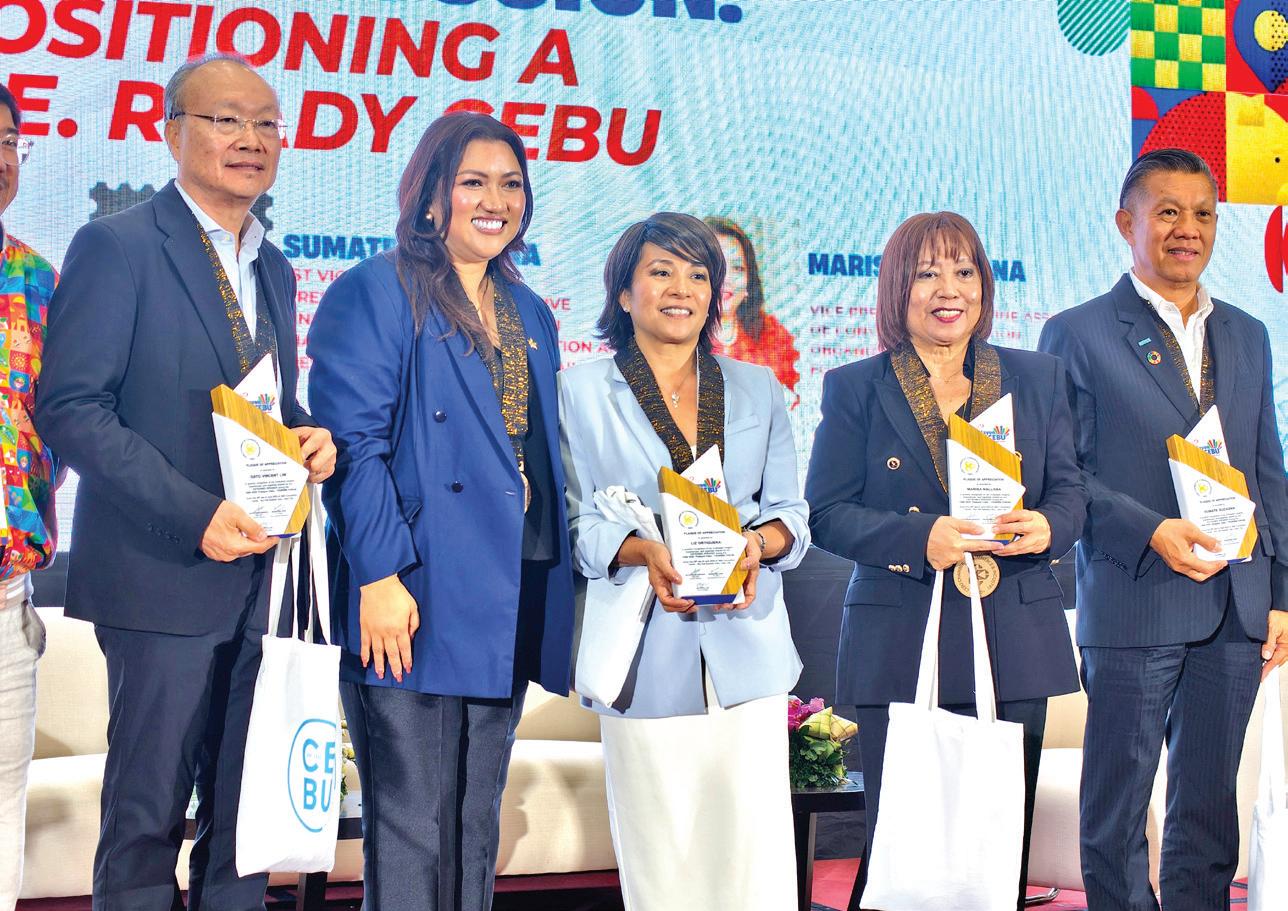


“Sense
Ortiguera pointed out. — Liz Ortiguera, Global Travel and Tourism Leader
“When I come to the Philippines, we’re proud of our Westernness, perhaps, but actually now’s the time to promote your Asianness and your Filipino heritage. That’s super important,” global travel and tourism expert Liz Ortiguera said at the recent Tourism Forum and Experiential Tour event at Skyhall, SM Seaside City. Ortiguera—a Filipina born in the United States—emphasized that establishing a strong “sense of place” is now one of the key advantages for destinations vying for a share of the global business events market. With travelers and organizers seeking more authentic, immersive experiences, she said venues that reflect cultural identity through architecture, cuisine, service, and story-
telling are increasingly being favored over generic, modern spaces.
“Sense of place. Bring your culture in. Great service. This is our expertise. We are the world experts in hospitality and service,” Ortiguera pointed out.
Filipino hospitality, Ortiguera noted, is widely recognized across the globe, with consistent demand for Filipino professionals in countries such as Mexico, India, and Saudi Arabia due to their strong service-oriented reputation.
“This is our intellectual property [unique assets],” she said. “And there’s no better place to showcase it than in the Philippines.”
‘Culture-led branding’ IN a side interview with report-
ers, Tourism Secretary Christina Garcia Frasco affirmed Ortiguera’s remarks, saying the Department of Tourism (DOT) is actively aligning its national strategies to highlight and promote Filipino identity as a core element of the country’s tourism branding.
“I couldn’t agree more,” Frasco told the BusinessMirror. “The President’s directive at the start of the administration was to reintroduce the Philippines to the world not just through the lens of fun, but also through the strength of Filipino identity and culture.”
Frasco noted that the Philippines is still in the early phase of realizing its full potential as an experiential destination. She emphasized the need for deeper integration of culture and community into the tourism offering—an approach already outlined in the DOT’s National Tourism Development Plan and flagship initiatives such as the
“Philippine Experience: Heritage, Culture, and Arts Caravans,” which seeks to deliver immersive cultural encounters for both local and foreign travelers.
“Tourists from around the world are no longer just looking to visit a destination and enjoy worldclass beaches—of which Cebu has many—but are seeking deeper engagement with local culture and communities,” she said.
Frasco added that the DOT’s culture-led strategy is also aligned with its broader ambition of positioning the Philippines among the world’s top 10 MICE destinations by 2030—a target projected to generate P25 billion in revenues. Cebu, she said, is expected to play a central role in achieving this goal.
“Cebu has very promising prospects in terms of being a preferred MICE destination because of its very diversified tourism offerings, apart from world-class facilities, two of which are also forthcoming in the next year,” she said.
‘Cebu’s MICE moment’
IN 2024, Cebu was chosen to host two major United Nations tourism events: the Regional Gastronomy Forum for Asia and the Pacific, and the joint conference of East Asia and the Pacific and South Asia.
Building on this momentum, the tourism chief announced that Cebu is set to host the Asean Tourism Forum in 2026.
Continued on A2



FROM THE EYES OF A SUPER FAN
Cosplayer Ian talks about what it was like to be part of the Manila leg of the ‘Superman’ tour
By Ica Hontiveros-Cheng
WHEN I got the assignment to write about the Superman Press Tour in Manila I didn’t want to just write about the event, as many of my fellow writers would be doing just that.

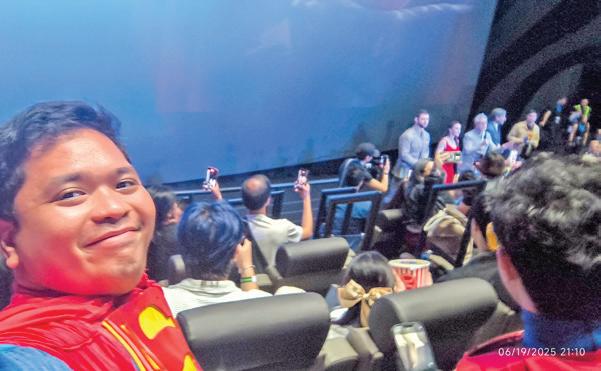
I was looking for a little more oomph, something more personal. And then it hit me. There were so many amazing and incredible fans who braved the heat and the sun, stood in long lines for hours, for a chance to catch a glimpse of Superman writer and filmmaker James Gunn, and stars David Corenswet and Rachel Broshnahan.


ager for a digital media company, but is also a big Jonathan Kent fan. It was a mutual friend of Ian and I who planted the seeds in my head to write this story. Pop culture writer and digital creator Jerald Uy posted how
carpet fan event, and a 30-minute screening of footage from the upcoming movie; the last event was by invitation. From all the video footage and photos from the many events, one cosplayer stood out. He was neither a celebrity cosplayer nor an influencer. Ian, like Clark Kent, has a day job as an Associate PR Man-
Filipino features caught the eye of photographers and videographers. Ian was what a Filipino Superman would look like.
Putting on the cape YOU might ask: Who? Jonathan Kent? Not Clark Kent? Not Superman? This is what Ian had to say: “Honestly, I
of place. Bring your culture in. Great service. This is our expertise. We are the world experts in hospitality and service,”
Photos Courtesy of Ian Panganiban
CULTURE MEETS NATURE IN CEBU Tourists snorkel alongside whale sharks in the famed coastal town of Oslob, a symbol of the Philippines’ rich marine biodiversity and immersive travel experiences. As the country promotes “culture-led branding” to boost its Meetings, Incentives, Conferences, and Exhibitions (MICE) appeal, destinations like Cebu offer not only world-class beaches but also authentic encounters that reflect Filipino heritage and hospitality. TATIANA KORNYLYEVA DREAMSTIME.COM
FROM left: Dato Vincent Lim, AFECA President and Honorary President of the Malaysia Association of Convention and Exhibition Organizers and Suppliers (MACEOS); Cleofe Albiso, Chairperson of the CBM 2025 Tourism Committee; Liz Ortiguera, Global Travel and Tourism Leader; Marisa Nallana, Vice President of the Philippine Association of Convention and Exhibition Organizers and Suppliers (PACEOS) and Founding President of the Philippine MICE Academy; and Sumate Sudasna, First Vice President of AFECA and President of the Thailand Incentive and Convention Association (TICA), also Managing Director of Convention and Destination Management (CDM), Thailand.
FROM left: Anton Mari Perdices, CBM 2025 Overall Chairman; Christina Garcia Frasco, Department of Tourism Secretary; Jay Yuvallos, President of the Cebu Chamber of Commerce & Industry (CCCI); and Cleofe Albiso, CBM 2025 Tourism Committee Chairperson.
SELLING BRAND ‘PHL’: FOCUS ON UNIQUENESS
“These global milestones reflect more than recognition, for they reaffirm Cebu’s leadership as a premier host for high-level gatherings and a competitive hub for meetings, incentives, conferences, and exhibitions,” Frasco said.
She emphasized that strengthening the MICE industry is key to tourism growth in the Philippines, not as a side offering but as a major driver of jobs and economic opportunities across the country.
Data from the World Travel and Tourism Council (WTTC) showed the global travel and tourism sector is projected to generate 90.6 million new jobs over the next decade, with the Asia-Pacific region expected to account for the majority of this growth, Ortiguera said.
“Travel is a force for good, and we’re an industry that creates jobs for people,” Ortiguera said.
The MICE industry, in particular, is poised for rapid expansion, she added, with a projected compound annual growth rate (CAGR) of 10 percent—outpacing most other industries globally.
“One of our strategic goals is to diversify our tourism portfolio by investing in high-value tourism products, services, and experiences such as MICE,” Frasco said.
Frasco noted that MICE delegates spend significantly more than typical leisure travelers, with an average of over $573 per delegate—around five times higher than regular tourist spending.
“Other countries have demonstrated how MICE can signifi-
cantly boost GDP, and therefore we believe that the Philippines, and Cebu in particular, can achieve the same success,” she said.
Thailand, for instance, reported strong MICE sector performance in 2024, with the industry generating 148.34 billion baht (approximately P234 billion) in revenue and contributing over 309 billion baht (around P487 billion) — or 1.67 percent — to the national GDP, up from 1.03 percent the previous year.
Valued at US$4.3 billion in 2024, Thailand’s MICE market is projected to reach US$13 billion by 2033, growing at a compound annual rate of 10.3 percent starting 2025. According to data from the ICCA, Thailand hosted 158 ICCAqualified events in 2024, topping all Asean countries and outperforming regional peers such as Malaysia, Singapore, and Vietnam.
Cebu builds big TO support similar growth in the Philippines, Frasco said the DOT is actively backing infrastructure development in Cebu, which she described as vital to enhancing the region’s capacity to host large-scale international events.
Among the major facilities is the upcoming SMX Convention Center in Cebu, which Cebu Business Month 2025 Overall Chairman Anton Mari Perdices said is set to become one of the largest convention venues in the country.
“We’re talking state-of-theart amenities that will position us to host events of unprecedented scale,” he said. He pointed to the soon-to-
be-completed SM Seaside Arena,
a 16,000-seat indoor arena scheduled for completion by end-2025. The venue is expected to accommodate international concerts, large-scale exhibitions and major sporting events, further enhancing Cebu’s competitiveness as an events hub.
Another significant development is Megaworld’s P1.5-billion Mactan Expo Center, strategically positioned near the Mactan-Cebu International Airport and several upscale resorts. Scheduled for completion by the end of 2025, the two-story standalone convention facility will provide almost a hectare of dedicated MICE space, capable of accommodating up to 2,600 attendees.
“It creates this powerful synergy between business and leisure travel that, honestly, very few destinations in the Philippines and the world can match,” Perdices said.
However, Frasco acknowledged that Cebu continues to face challenges in infrastructure, connectivity, and the reliability of essential utilities such as water and electricity. Still, she expressed confidence in the resilience and unity of Cebuanos, noting that the community consistently comes together in times of difficulty.
“I am confident that through this partnership between the local and national government and our private tourism stakeholders, we are helping Cebu rise to its full potential,” she emphasized.
On the infrastructure front, Frasco noted that the DOT has already invested over P4 billion in tourism roads in Cebu and has pro-

posed an additional P7 billion in road projects for the province in 2026. She also highlighted improvements in connectivity, including the introduction of new international and domestic flight routes to and from Cebu.
‘Present Philippines as Philippines’ ORTIGUERA’S call for authenticity was echoed by other regional MICE leaders during the forum, which was organized by the Cebu Chamber of Commerce and Industry (CCCI) in partnership with the Cebu MICE Alliance Steering Committee.
Sharing insights from Thailand’s successful positioning in the industry, Sumate Sudasna, First
Vice President of the Asian Federation of Exhibition and Convention Associations (Afeca) and President of the Thailand Incentive and Convention Association (Tica), said the Philippines does not need to mimic other destinations—such as Thailand, Indonesia, or Singapore, which rank among the world’s top cities for hosting international events—to compete globally.
“You just need to present [the] Philippines as Philippines. Never compare to other destinations because each destination is unique and we have our own identity and our own inclusions and offerings,” Sudasna said.
Sudasna noted that the Philippines already shows strong poten-
tial in the meetings and incentives segment of the MICE industry, and encouraged stakeholders to focus on strengthening this area while also expanding service capacity.
He suggested that the Philippines maximize its participation in international industry groups such as Afeca, the Society for Incentive Travel Excellence (SITE), and the International Congress and Convention Association (ICCA)—organizations where the country is already a member.
These associations, he said, offer not only global exposure but also access to training programs and capacity-building initiatives that can further strengthen the local MICE sector.
From the eyes of a Super fan
Continued from A1
perman. I started to be a fan more through his biological son with Lois Lane, Jonathan Kent. I had a friend who was a fan of Damian Wayne [Batman’s son] and he kind of influenced me to fall in love with the other half of the Super-Sons. Eventually, I learned to love his father and the Superman Family as well from then on, since there were only so many comics featuring Jon Kent and it often included Clark and their father-son relationship.
“This started just back in 2018. But even before that, I had already admired Superman, albeit not yet as a big fan.”
Ian has been cosplaying as Jonathan Kent for over seven years.
“People often mistake me for Clark Kent/Superman. It’s just in terms of popularity, when people see the S symbol, they immediately think of Clark Kent,” he says. “I don’t correct them anymore, since that is what Jonathan would do, that’s his character. He will try to step into his father’s footsteps, especially when his dad is not around. So in a way, he is also a ‘Superman.’”
When asked what he likes about Jonathan and his family, this is what Ian had to say: “I really love their optimism. The S Symbol, the crest of the house of El, is really a beacon of hope. No matter what the circumstances, they never give up. Despite being different, they always do their best to do something good with their powers and never for something evil.”
Superman as a Super Dad WOULD you say that you admired Clark as a father figure first? We asked.
“Yes definitely! I slowly started to relate him to my Dad and how impressed I was of my Dad. Eventually, I also saw myself in Jon, that I also feel the weight of learning to take on my Dad’s footsteps and it’s something I really find challenging to do.
“I think that’s their whole dynamic. Jon is also pressuring himself on the weight of becoming the next Superman. And that self-pressure is very relatable. Even though Clark often reassures him that he is enough . . . Something I really share also with my dad.
“I always appreciate having a father who reassures me that I am enough,” Ian added.
Meeting a Super cast
CAN you share with us your story of joining the Superman events?
We asked Ian.
“Wow! That was a really long, intense, but definitely SUPER day! I couldn’t even sleep properly that night because of the excitement. I think I was already awake around 2 am and trying to catch up on some work before the day started since I had a two-day leave from work.
“I was already in the venue around 6:30 am since the official cosplayers had all agreed to be in the venue early to get the registration done and pose and play already with everyone else waiting in line. The whole waiting time, I took the chance to copy some poses, take plenty of photos with my friends, and entertain other fans.”
The first fan event of the day was the gathering of 1,000 Superman fans to form the iconic ‘S’ symbol by The Victor statue at Bridgetowne in Pasig.
How was the experience? Was it all worth it?
“Oh, definitely. Me and the other cosplayers have an inside joke about it. I believe it was the legendary Superman cosplayer himself, Gerard Sison, who coined the term #Corensweating,” Ian shared. The term of course is coined from the last name of David Corenswet, combined with the word “sweating”—which the cosplayers surely experienced, being under the sun all morning.
Sison is a familiar figure in the pop culture community. He started cosplaying at 46 years old, after surviving a heart attack. He has become known in the community as a familiar Superman cosplayer. At 61 years old, he continues to put on the tights and cape.
Ian continued: “Right when we started to assemble, I think around 9 am all the way until a little after 10, we braved the heat and the possibility of a little rain. Luckily, it didn’t! It would have been a nightmare for us cosplayers.”
“Seeing the cast for the first time that morning, that was already something really memorable,” Ian mused.
“When we got to MOA, I think I was also always happy when I get to don the costume and people recognize me (as Clark though). I feel this sense of responsibility to also stay in character, greet everyone

cheerfully, smile, wave and have my photos taken with kids and adults alike. I spent some time to also retouch, change my inner shirt and suit up once more for the red carpet event.”
The rest of the events were held at the Mall of Asia in Pasay: a red carpet and fan event at the Mall of Asia Music Hall, followed by a by-invitation-only screening of a 30-minute footage from the film. Ian was present at both events.
“Here is when I really felt that #Corensweating was worth it,” Ian continued. “Here is when it dawned on me just how big of a privilege it was to be part of the official roster of cosplayers for Warner Brothers. It was my first time to be front and center of such a big event and to be put together and really mingle with big names such as celebrity cosplayers Prince de Guzman, and Myrtle Sarrosa, and entertainment personalities like Gino Quillamor, and Eric Tai, who were all with us not as celebrities but also as fans themselves.”
“On top of that, [there’s] the actual experience of being so close to the cast. Rachel [Broshnahan] complimented my costume, David [Corenswet] shook hands with me and James Gunn was happy to see me. All of them were able to sign my comic book and merchandise. This was really a once-in-a-lifetime experience. I don’t think I would have the privilege of ever getting to do something like that again so at that moment, I was just really taking it all in and immersing myself in the moment.”
“So even though it took me days to possibly recover up to around 80 percent, given that I was up already by 2 am and I got home only 11 pm that day, I can definitely say it was Super and it was worth it.” Congratulations on getting so much screen time in the photos and videos! Would you say it’s because you have a Filipino look? And what is your reaction to that ?
“I’d like to say though that I think I was just really embodying Jon Kent so much. In the comics, Jon started as a fan of Superman before he even found out that Superman was actually his dad, so I think it’s really because I was so much in character and I really let my heart out as a really big fan of Superman at that moment.”
The Philippines as the first stop of the Superman world tour was a crucial decision from stakeholders as it sets the tone for the rest of the tour.
“Your support has been the wind beneath our wings as we embark on this world tour,” Rachel Broshnahan told Filipino fans gathered at the Music Hall of the Mall of Asia, many of whom, like Ian, have been up since 2 am. If there’s one thing that Filipinos are known for, it is our welcoming nature and our passion as fans and the cast of Superman certainly had a big dose of that, much like the dose of the warm yellow sun, which energizes and gives power to the man of steel himself, we also gave them the energy that the cast and director needed.
Editor: Angel R. Calso

The UAE’s allure: Hedge funds follow talent to Dubai despite Mideast tensions
By Nishant Kumar, Bei Hu & Hema Parmar
IN late 2023 hedge fund veteran Danny Yong lost out on a coveted trader he was trying to hire. Not because this person didn’t want to work for his firm. He was just desperate to move to a rival city.
Yong’s Dymon Asia Capital is based in Singapore, as was the trader. Yet it was a competing firm with a Dubai office that won him over. Within weeks the rejected Dymon co-founder made the call: If the talent’s headed to the desert, so are we. His firm opened in Dubai in October, has signed a lease for much bigger digs and aims to have 10 portfolio managers there by year end.
Dymon’s hurried overseas expansion shows that even a lower-tax mainstay like Singapore has struggled to match the overtures of the United Arab Emirates lately. It’s evidence of something else as well. Hedge funds haven’t only been pulled in by the more than $3 trillion in the hands of the UAE’s sovereign funds and wealthy families. They’ve been pushed by their best workers, too.
The escalating number of wars in the Middle East, with Israel and Iran’s conflict—and speculation about the potential involvement of the US—the most alarming, has prompted questions about whether a recent flood of arrivals will persist. But people who work on bringing financial talent to the UAE say the country is no longer automatically conflated with the wider region.
“Naturally there’s been some impact on sentiment,” says Rahnpreet Sandhu, a Dubaibased headhunter at Durlston Partners. “However, the perceived risk to most is greater than what major investors and funds actually factor into decision-making.”
Lured by zero personal income tax, a time zone that talks to both East and West and a lifestyle tailor-made for the rich, many traders have been demanding to relocate despite the heightened regional tensions of the past two years. And in the midst of a tussle for talent, hedge funds have wanted to keep them happy.
London is the city that has lost by far the biggest number of jobs to the UAE. And Indian nationals, including Dymon’s missed recruit, have been especially drawn to a place that’s closer to family and home than other hubs. Of the 146 nationalities who work in the Dubai International Financial Centre, Indians are the largest contingent, according to its own figures. Brits are second.
“It’s a key office for talent attraction,” says Diego Megia, founder of London-based Taula Capital Management, speaking of his Dubai presence after carrying out one of the biggest ever hedge fund launches last year. “The funds that cannot offer that, they really have a disadvantage.”
Not everyone agrees with this argument that the UAE
is an essential locale for the industry, even if you set the risk of regional wars aside.
Citadel’s Ken Griffin doesn’t want his traders in low-tax hubs without their full teams because it weakens collaboration.
Francesco Filia, founder of Fasanara Capital who’s been going to the country for decades, warns of an ugly awakening for firms who think they’ll easily tap its vast sources of sovereign and family wealth simply by proximity.
“I think 90% of them will be disappointed,” he says. And yet, none of this has interrupted the staff-led exodus. Industry leviathan Millennium Management opened in Dubai because one team wanted to be there and the firm expected growth in the market, according to someone with knowledge of the matter who didn’t want to be named discussing private strategy. Others asked to join, and the office took on a momentum of its own. Today it has about 120 people and roughly 25 teams.
Brevan Howard has made Abu Dhabi a key trading hub, with founding partner Trifon Natsis—the ‘N’ in Brevan— based there. Billionaire Steve Cohen’s Point72 Asset Management opened in Dubai in 2022 driven by staff demand, and it now has more than 40 people on the ground. Dmitry Balyasny’s eponymous firm has just opened a second floor of space, which will let it double the 32-person operation’s capacity in a couple of years.
Bhaskar Dasgupta, who runs his family office, Sun Foundation, from Abu Dhabi, recounts the story of a hedge fund manager who fell in love with a Dubai-based woman during a visit. His firm responded by opening an office in the city.
Close knit EVIDENCE of a bustling hedge fund community can be seen in some of the regular networking events. Abu Dhabi hosts informal gatherings of hundreds of industry execs known as the “Side Hustle Crew,” with subgroups for everything from crypto to wine tasting to golf, and chapters in Dubai and Doha. The city’s LINK event is busier still. And a recent visit to to the upscale L’Eto restaurant included the sight of a group of older women knitting in a circle, many of them visiting expat financier sons and daughters. DIFC and Abu Dhabi’s ADGM, the two financial centers on a mission to win over the world’s asset managers, are hunting for more. What began as a trickle during the pandemic, when the UAE flung open its doors while most countries shut theirs, has been turning into a full-blown

DUBAI is home to more than 75 hedge funds, up from 10 or so a decade ago. NATALIE NACCACHE/BLOOMBERG
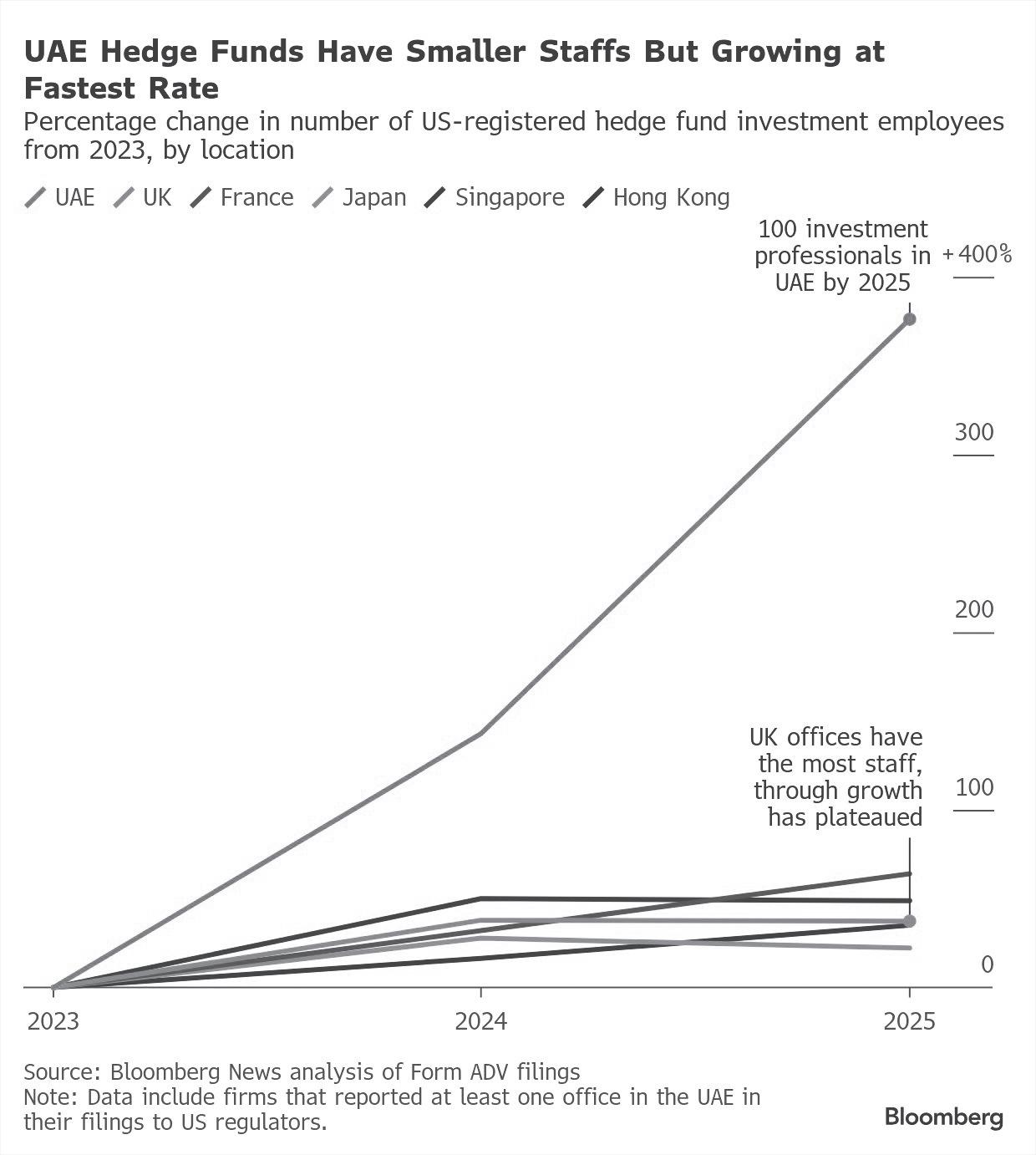
talent migration.
The sister cities, separated by 90 miles of desert and a treedotted road with skyscrapers at either end, are sending delegations to rival locales and courting hedge funds, attracted by a prolonged profit boom at the top of the industry.
Dubai is home to more than 75 of these firms, up from 10 or so a decade ago. Its finance hub is building more office blocks, and a site for hedge funds. The workforce on Al Maryah Island, home to Abu Dhabi’s hub, rose 17% in a year.
“What they’ve done in DIFC and ADGM isn’t a fad,” says Kish Desai, who moved from London to Dubai in April to open Tourmaline Partners’ operation there. “I anticipate that one-way traffic to continue for years.”
Wealthy escapes THE UAE’s emergence as a magnet for rich asset managers—and to a lesser extent the rise of other hotspots
like Monaco and Miami—has been made possible by more traditional rivals ceding ground.
Unlike London, New York, Hong Kong, Singapore or Paris, it doesn’t have a deep history of trading in liquid markets, a homegrown hedge fund ecosystem or a conveyer belt of whiz kids coming out of worldclass universities. Instead, the two emirates have gained territory by removing as many obstacles as possible. They’ve benefited from traders’ difficulties getting permanent residency in Singapore and from Hong Kong’s draconian Covid rules. London, whose fancy Mayfair and St James’ districts host the biggest hedge fund community outside the US, is gradually moving on from a time when it embraced the wealthy in all their guises. Rich people are trying to flee changes to UK taxation.
Paul Marshall, whose London hedge fund runs
about $70 billion in assets— and who co-owns a right-wing news channel—outlined a list of complaints when unveiling plans for an Abu Dhabi outpost in December. “Income tax: Britain 45%, Abu Dhabi zero; capital gains tax: Abu Dhabi zero, Britain’s just gone to 24,” he said. “So in terms of tax, Abu Dhabi is absolutely nailing it.”
The UAE has also tried to shake off its reputation of being a transient destination for foreigners. During the pandemic, it started breaking away from a model linking residency to employment.
Officials widened eligibility for “golden” visas for the rich, stopped requiring companies have a majority local partner, switched to a Monday-Friday workweek and made it legal for unmarried couples to live together. And it’s cutting red tape.
Thomas Margerison, who connects hedge funds to investors on behalf of prime broker Marex, is another who made the jump for personal as well as work reasons. He quit a London job to follow his lawyer wife to Dubai. She’d decided to stay put after first moving because of the UK’s Covid restrictions.
“For many, what started as an extended stay turned into a permanent relocation,” says Salmaan Jaffery, chief business development officer at DIFC Authority.
But the question is how successful the UAE’s campaign can be for a place that lacks investable opportunities, and of its ultimate worth to the economy other than for realestate agents, restauranteurs, private schools and so on.
“It’s much more the intellectual capital that it represents that’s of serious value,” says Arvind Ramamurthy, chief of market development at ADGM. So far, firms are mostly using
Dubai and Abu Dhabi as trading posts, not investing into the market. Homegrown hedge fund startups are negligible. And compared to New York and London, the UAE is still small fry. New arrivals gripe about office shortages, surging rents and finding school places.
“They do it to get the capital, which I think is the usual motive to move there,” says Fasanara’s Filia. “I don’t think they’ll be happy.” Regardless, he opened an Abu Dhabi office in February and is seeking a full license, planning to have 20 people within a year.
Competition for jobs and their relative scarcity make it tough, too, to move between hedge funds in the UAE, a problem for an industry where hiring and firing is part of doing business. Being unemployed in this country bites quickly given the housing expense. There were 435 transactions last year for homes valued at $10 million or more, Knight Frank data shows, nearly matching London and New York combined.
Then there are the holdouts. Citadel, one of the biggest employers of hedge fund traders, is yet to open an office. For Griffin, depth of talent and not just tax perks is key to expansion. DE Shaw, which set up in the emirates in 2009 before pulling out, is a fellow absent giant.
Others remain sanguine, even as the danger of wider war looms.
“We don’t know about the long-term sustainability, livability and workability of a city given geopolitical and macroeconomic instability,” says the Sun Foundation’s Dasgupta. But there’s a “three to fiveyear window where there are very positive factors attracting portfolio managers and hedge funds to UAE, and negative factors in traditional locations.” With assistance from Nandu Nair, Priyanjana Bengani, Weihua Li, Omar El Chmouri and Zainab Fattah/Bloomberg
ICE is using no-bid contracts, boosting big firms, to get more detention beds
By Heather Hollingsworth & John Hanna The Associated Press
LEAVENWORTH, Kan.—
Leavenworth, Kansas, occupies a mythic space in American crime, its name alone evoking a short hand for serving hard time. The federal penitentiary housed gangsters Al Capone and Machine Gun Kelly—in a building so storied that it inspired the term “the big house.”
Now Kansas’ oldest city could soon be detaining far less famous people, migrants swept up in President Donald Trump’s promise of mass deportations of those living in the US illegally. The federal government has signed a deal with the private prison firm CoreCivic Corp. to reopen a 1,033-bed prison in Leavenworth as part of a surge of contracts US Immigration and Customs Enforcement has issued without seeking competitive bids.
ICE has cited a “compelling urgency” for thousands more detention beds, and its efforts have sent profit estimates soaring for politically connected private companies, including CoreCivic, based in the Nashville, Tennessee area and another giant firm, The Geo Group Inc., headquartered in southern Florida.
That push faces resistance. Leavenworth filed a lawsuit against CoreCivic after it tried to reopen without city officials signing off on the deal, quoting a federal judge’s past description of the now-shuttered prison as “a hell hole.” The case in Leavenworth serves as another test of the limits of the Republican president’s unusually aggressive tactics to force migrant removals.
To get more detention beds, the Trump administration has modified dozens of existing agreements with contractors and used no-bid contracts. One pays $73 million to a company led by former federal immigration officials for “immigration enforcement support teams” to handle administrative tasks, such as helping coordinate removals, triaging complaints or telling ICE if someone is a risk to community safety.
Just last week, Geo Group announced that ICE modified a contract for an existing detention center in southeastern Georgia so that the company could reopen an idle prison on adjacent land to hold 1,868 migrants—and earn $66 million in annual revenue.
“Never in our 42-year company history have we had so much activity and demand for our services as we are seeing right now,” said CoreCivic CEO Damon Hininger during an earnings call last month with shareholders.
A tax-cutting and budget reconciliation measure approved last month by the House includes $45 billion over four years for immigrant detention, a threefold spending increase. The Senate is now considering that legislation.
Declaring
an emergency to expedite contracts
WHEN Trump started his second term in January, CoreCivic and Geo had around 20 idle facilities, partly because of sentencing reforms that reduced prison populations. But the Trump administration wants to more than double the existing 41,000 beds for detaining migrants to at least 100,000 beds and—if private prison executives’ predictions are accurate—possibly to more than 150,000.
ICE declared a national emergency on the US border with Mexico as part of its justification for authorizing nine five-year contracts for a combined 10,312 beds without “Full and Open Competition.”
Only three of the nine potential facilities were listed in ICE’s document: Leavenworth, a 2,560-bed CoreCivic-owned facility in California City, California, and an 1,800-bed Geo-owned prison in Baldwin, Michigan.
The agreement for the Leavenworth facility hasn’t been released, nor have documents for the other two sites. CoreCivic and Geo Group officials said last month on earnings calls that ICE used what are known as letter contracts, meant to speed things up when time is critical.
Charles Tiefer, a contract expert and professor emeritus of law at the University of Baltimore Law School, said letter contracts normally are reserved for minor matters, not the big changes he sees ICE making to previous agreements.
“I think that a letter contract is a pathetic way to make big important contracts,” he said.
A Kansas prison town becomes a priority
CORECIVIC’S Leavenworth facility quickly became a priority for ICE and the company because of its central location. Leavenworth, with 37,000 residents, is only 10 miles (16 kilometers) to the west of the Kansas City International Airport. The facility would hold men and women and is within ICE’s area of operations for Chicago, 420 miles (676 kilometers) to the northeast.
“That would mean that people targeted in the Chicago area and in Illinois would end up going to this facility down in Kansas,” said Jesse Franzblau, a senior policy analyst for the National Immigrant Justice Center.
Prisons have long been an important part of Leavenworth’s economy, employing hundreds of workers to guard prisoners

held in two military facilities, the nation’s first federal penitentiary, a Kansas correctional facility and a county jail within 6 miles (10 kilometers) of city hall.
Resistance from Trump country
THE Leavenworth area’s politics might have been expected to help CoreCivic. Trump carried its county by more than 20 percentage points in each of his three campaigns for president.
But skeptical city officials argue that CoreCivic needs a special use permit to reopen its facility. CoreCivic disagrees, saying that it doesn’t because it never abandoned the facility and that the permitting process would take too long.
Leavenworth sued the company to force it to get one, and a statecourt judge issued an order requiring it earlier this month.
An attorney for the city, Joe Hatley, said the legal fight indicates how much ill will CoreCivic generated when it held criminal suspects there for trials in federal court for the US Marshals Service.
In late 2021, CoreCivic stopped housing pretrial detainees in its Leavenworth facility after then-President Joe
Biden, a Democrat, called on the US Department of Justice to curb the use of private prisons. In the months before the closure, the American Civil Liberties Union and federal public defenders detailed stabbings, suicides, a homicide and inmate rights violations in a letter to the White House. CoreCivic responded at the time that the claims were “false and defamatory.”
Vacancies among correctional officers were as high as 23%, according to a Department of Justice report from 2017.
“It was just mayhem,” recalled William Rogers, who worked as a guard at the CoreCivic facility in Leavenworth from 2016 through 2020. He said repeated assaults sent him to the emergency room three times, including once after a blow to the head that required 14 staples.
The critics have included a federal judge WHEN Leavenworth sued CoreCivic, it opened its lawsuit with a quote from US District Court Judge Julie Robinson—an appointee of President George W. Bush, a Republican—who said of the prison: “The only way I could describe it frankly, what’s
To get more detention beds, the Trump administration has modified dozens of existing agreements with contractors and used no-bid contracts. One pays $73 million to a company led by former federal immigration officials for “immigration enforcement support teams” to handle administrative tasks, such as helping coordinate removals, triaging complaints or telling ICE if someone is a risk to community safety.
going on at CoreCivic right now is it’s an absolute hell hole.”
The city’s lawsuit described detainees locked in showers as punishment. It said that sheets and towels from the facility clogged up the wastewater system and that CoreCivic impeded the city police force’s ability to investigate sexual assaults and other violent crimes.
The facility had no inmates when CoreCivic gave reporters a tour earlier this year, and it looked scrubbed top to bottom and the smell of disinfectant hung in the air. One unit for inmates had a painting on one wall featuring a covered wagon.
During the tour, when asked about the allegations of past problems, Misty Mackey, a longtime CoreCivic employee who was tapped to serve as warden there, apologized for past employees’ experiences and said the company officials “do our best to make sure that we learn from different situations.”
ICE moves quickly across the US BESIDES CoreCivic’s Leavenworth prison, other onceshuttered facilities could come online near major immigrant population centers, from New York to Los Angeles, to help Trump fulfill his deportation plans.
ICE wants to reopen existing facilities because it’s faster than building new ones, said Marcela Hernandez, the organizing director for the Detention Watch Network, which has organized nationwide protests against ICE detention.
Counties often lease out jail space for immigrant detention, but ICE said some jurisdictions have passed ordinances barring that.
ICE has used contract modifications to reopen shuttered lockups like the 1,000-bed Delaney Hall Facility in Newark, New Jersey, and a 2,500-bed facility in Dilley, Texas, offering no explanations
why new, competitively bid contracts weren’t sought.
The Newark facility, with its own history of problems, resumed intakes May 1, and disorder broke out at the facility Thursday night. Newark Mayor Ras Baraka, a Democrat who previously was arrested there and accused of trespassing, cited reports of a possible uprising, and the Department of Homeland Security confirmed four escapes.
The contract modification for Dilley, which was built to hold families and resumed operations in March, calls its units “neighborhoods” and gives them names like Brown Bear and Blue Butterfly.
The financial details for the Newark and Dilley contract modifications are blacked out in online copies, as they for more than 50 other agreements ICE has signed since Trump took office. ICE didn’t respond to a request for comment.
From idle prisons to a ‘gold rush’ PRIVATE prison executives are forecasting hundreds of millions of dollars in new ICE profits. Since Trump’s reelection in November, CoreCivic’s stock has risen in price by 56% and Geo’s by 73%.
“It’s the gold rush,” Michael A. Hallett, a professor of criminal justice at the University of North Florida who studies private prisons. “All of a sudden, demand is spiraling. And when you’re the only provider that can meet demand, you can pretty much set your terms.” Geo’s former lobbyist Pam Bondi is now the US attorney general. It anticipates that all of its idle prisons will be activated this year, its executive chairman, George Zoley, told shareholders.
CoreCivic, which along with Geo donated millions of dollars to largely GOP candidates at all levels of government and national political groups, is equally optimistic. It began daily talks with the Trump administration immediately after the election in November, said Hininger.
CoreCivic officials said ICE’s letter contracts provide initial funding to begin reopening facilities while the company negotiates a longer-term deal. The Leavenworth deal is worth $4.2 million a month to the company, it disclosed in a court filing.
Tiefer, who served on an independent commission established to study government contracting for the Iraq and Afghanistan wars, said ICE is “placing a very dicey long-term bet” because of its past problems and said ICE is giving CoreCivic “the keys to the treasury” without competition.
But financial analysts on company earnings calls have been delighted. When CoreCivic announced its letter contracts, Joe Gomes, of the financial services firm Noble Capital Markets, responded with, “Great news.” “Are you hiding any more of them on us?” he asked.
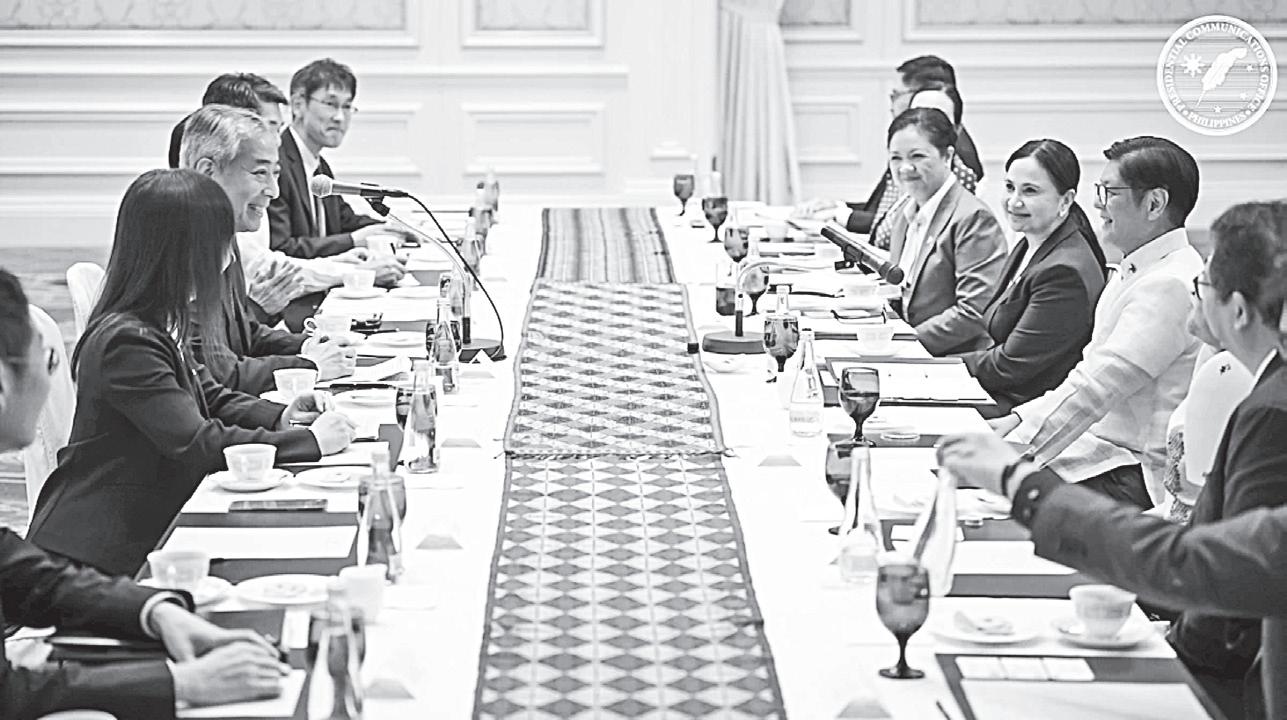
PBBM: PhilSA to expand space cooperation with JAXA
OSAKA, Japan—President Ferdinand R. Marcos Jr. announced during the Philippine delegation’s visit to Expo 2025 Osaka that the Philippines is expanding cooperation with Japan Aerospace Exploration Agency [JAXA] to protect and improve the lives of Filipinos.
“We’re working with [JAXA], together with our very own Philippine Space Agency [PhilSA], to use space technology that helps protect and improve the lives of Filipinos,” he said.
In the meeting with JAXA President Hiroshi Yamakawa and PhilSA Deputy Director General Gay Jane Perez, President Marcos said: “With better satellites, we can track typhoons and respond to disasters more quickly, help our farmers plan smarter, and keep our communities safer.”
During the meeting Yamakawa highlighted Japan’s enduring partnership with the Philippines, which began in 2006 through JAXA’s collaboration with the Department of Science and Technology, and further strengthened with the establishment of PhilSA in 2019, PhilSA said in a news release.
In 2021, both agencies signed a memorandum of cooperation to collaborate in satellite development and utilization, research and development, and capacity building.
In the meeting, Yamakawa expressed support for PhilSA’s priority to maximize the effective use of satellite data in national development.
On-going, future initiatives between JAXA and PhilSA
THE Philippines is an active participant and contributor to the Sentinel Asia initiative, which supports disaster risk reduction and management activities in the Asia-Pacific region using space technology and online geospatial mapping. Since 2023, PhilSA has a continuing commitment to provide pre-, during-, and post-disaster satellite imagery data from the Diwata-2 and NovaSAR-1 satellites.
The partnership also extends to space education and outreach. PhilSA has been leading the Philippines’ participation in JAXA’s Kibo Asian Beneficial
TEAM CH4GEN1 from Batangas State University (BatStateU) bagged multiple awards at the prestigious 2025 American Association of Petroleum Geologists (AAPG) Sustainable Development in Energy Competition (SDEC), held virtually in Tulsa, Oklahoma, USA, on June 19. Composed of BS Chemical Engineering students from BatStateU, Team CH4GEN1’s milestone marks the Philippines’ first-ever win in the competition. The winning team’s innovation—the Modular and Mobile Food Waste Digester for Biomethane and Biofertilizer Generation—clinched the first place grand prize and secured a $5,000 award.
Collaboration (Kibo-ABC), which provides Filipino researchers and students with opportunities to develop experiments to be conducted aboard the Japanese “Kibo” module on the International Space Station (ISS).
This includes regular involvement in the Asian Try Zero-G, where several Philippine experiments have been performed by JAXA astronauts in the ISS since 2022; Asian Herb in Space (AHIS); and the Kibo Robot Programming Challenge (Kibo-RPC).
Looking forward, both countries aim to strengthen the involvement of the private sector through enabling regulations and investment incentives. This includes fostering business-tobusiness engagement to diversify the satellite manufacturing supply chain and support the growth of the domestic space industry.
Philippines to host key space events with Japan IN November, the Philippines will host the 31st Asia-Pacific Regional Space Agency Forum (APRSAF-31) in Cebu, the largest space forum in the region, co-organized by PhilSA and JAXA, PhilSA announced.
The forum will highlight PhilSA’s growing portfolio of programs and showcase its successful cooperation with Japan, reinforcing its leadership role in the regional space community.
PhilSA will also host the Japan-Philippines Space Economy Co-Creation Event to be held in Manila ahead of APRSAF-31, the space agency added.
The initiative will bring together space agencies, startups, investors, and researchers from both countries and lay the groundwork for cooperation in satellite applications, manufacturing, and emerging space technologies.
“PhilSA is expanding our cooperation with JAXA by encouraging Japanese space companies to partner with Philippine space companies for space data utilization and diversifying satellite manufacturing chain,” Perez said.
“These business-to-business opportunities will contribute to building our own local or domestic space industry and partaking in the growing space economy,” she explained.

PHL handloom weaving gets boost with opening of center
THE handloom weaving in the Philippines is getting more government support and it is getting a big boost with the upcoming inauguration of the Philippine Handloom Weaving Center on July 7 at the Department of Science and Technology-Philippine Textile Research Institute (DOST-PTRI) grounds in Taguig City, the Institute said. With the DOST-PTRI’s sight for handloom weaving sector’s modernization, the Center is envisioned as a hub for innovation in the country.
It aims to advance weaving techniques and technology while preserving the cultural heritage and craftsmanship of Filipino weavers.
DOST-PTRI said the Center will lead initiatives in modernizing weave design, drafting, and analysis; advancing handloom engineering technologies; and
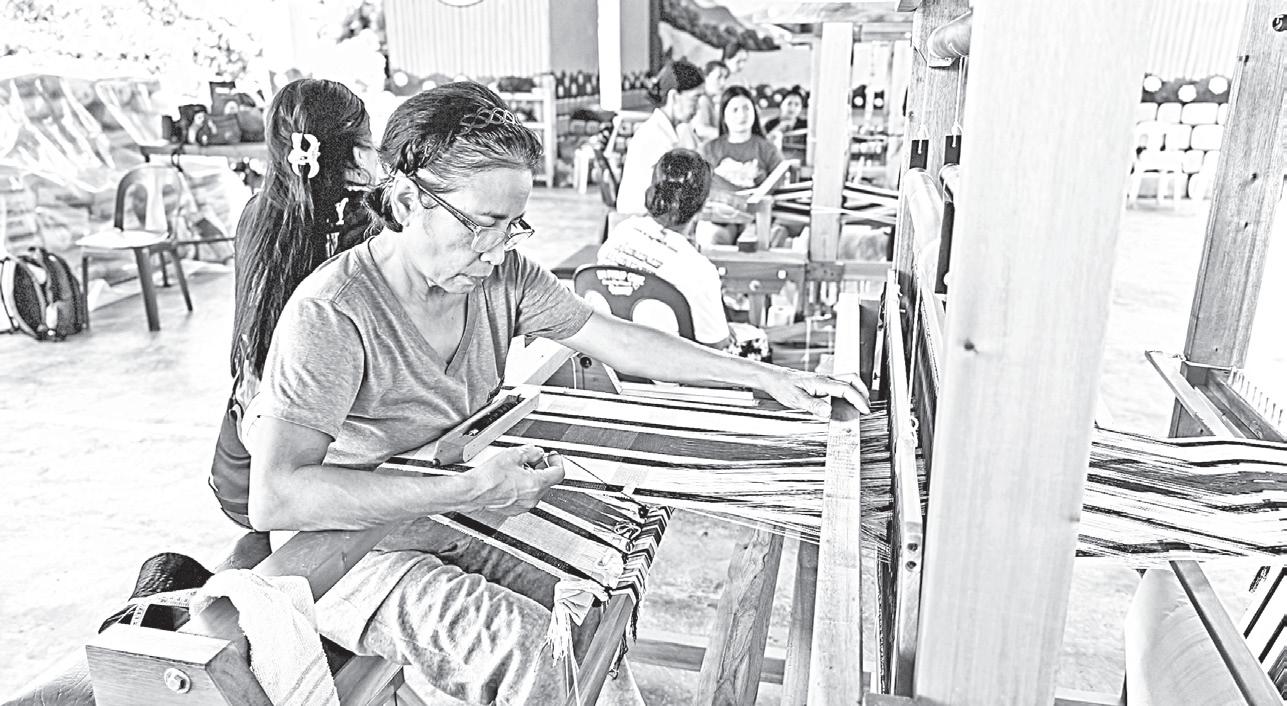
promoting intellectual property protection.
These efforts will be carried out in collaboration with 24 Regional Handloom Weaving Innovation Hubs established across the Philippines.
Through skills training and capability-building programs, the Center also seeks to formalize
handloom weaving as a recognized technical skill, contributing to local employment generation and strengthening the national textile manufacturing industry.
Positioned as the nucleus for handloom woven textile conservation and innovation, the Center will integrate science and artistry in its operations, DOST-PTRI said.
Among its highlights are DOSTPTRI’s innovations in weaving equipment, digital weave pattern design, product testing and assurance, skills development, technology transfer, and the use of sustainable, natural fiber-blended yarns. The advancements were designed to complement and uplift traditional handloom practices and the creative expertise of local weavers.
The facility will house 10 units of the HL Mach 4.0 (45 inches width, four-harness) and two units of the Theraloom V2 (25 inches width, four-harness), showcasing DOSTPTRI’s patented technologies in support of weaving modernization. A dedicated space will also be allotted for the DigiTELAzation Program, highlighting the development of a national database of weavers, computer-assisted weave pattern drafting, and the application of covert yarn technology.
Science execs pursue UK science mission to propel PHL innovation economy
OFFICIALS of the Department of Science and Technology (DOST) have embarked on a high-impact mission to the United Kingdom from June 8 to 15 that aims to solidify international partnerships to accelerate the Philippines’ transition into a robust innovation economy.
Anchored under Project Padaghan, the week-long mission was a step in DOST’s broader agenda to connect Philippine research and development (R&D) with global innovation ecosystems, the DOST said in a news release.
The delegation engaged with some of the UK’s most prominent science and technology institutions, including the University College London Business (UCLB), the UK Department for Science, Innovation and Technology (DSIT), UK Research and Innovation (UKRI), the Royal Academy of Engineering (RAEng), and innovation hubs in Glasgow and Edinburgh.
The DOST explained that the UK mission
Bangsamoro
DThe 2025 SDEC, that was launched on January 30, drew 38 proposals from across the globe, with 10 finalists selected from countries including Colombia, Mexico, Malawi, India, Indonesia, and the Philippines. The competition culminated in a 10-week Venture Lab program, where finalists received coaching, collaborated with industry experts, and refined their innovative ideas. The journey led to the final pitch presentations held on June 19, where Team CH4GEN1 dominated, sweeping the awards with the Top Place Proposal Award, Precision Partner Award, and Voice of the Lab Award.
Team CH4GEN1 surpassed other exceptional teams, including Juan David
“[was] not merely an observational visit, but rather a targeted acquisition of the tools, partnerships, and knowledge needed to position the Philippines as a competitive player in the global innovation landscape.”
Their goal is to bolster the country’s innovation infrastructure and create inclusive, science-led growth across all regions, which are among the DOST’s many initiatives aimed at providing science-based, innovative, and inclusive solutions across four strategic pillars: human well-being, wealth creation, wealth protection, and sustainability.
The key highlights of the mission include:
n Participation in London Tech Week 2025 from June 9 to 11, providing access to over 30,000 global tech leaders, where the delegation scouted scalable technologies in artificial intelligence, clean energy, and biotechnology, and open dialogue with European venture capitalists; Institutional engagement with UCLB on June 11 to adapt successful spin-off and
commercialization frameworks for Philippine higher education institutions;
n Policy-level dialogues with DSIT, UKRI, and RAEng on June 12, exploring co-funding mechanisms and engineering capacitybuilding programs; n Site visits in Glasgow (University of Strathclyde, Industrial Biotechnology Innovation Centre [IBioIC], Glasgow Science Centre) on June 13 and 14, focusing on knowledge transfer partnership model for Philippine industries, bioeconomy collaboration for development of roadmap leveraging IBioIC expertise, and science communication best practices; and n Discussion with Edinburgh Innovation Hub (Edinburgh Innovations and Venture Builder Incubator) on June 15 for startup acceleration framework for DOST incubators and licensing opportunities for Philippine technologies.
Expected outcomes from the visit include the formulation of commercialization
road maps, new models for joint research funding, startup incubation frameworks, stronger intellectual property licensing structures for EU market entry, joint R&D proposals, institutional researcher exchange partnerships, and pilot programs for industry-academic collaboration—all seen to directly strengthen DOST’s capacity to drive inclusive, innovation-led development across the nation.
The Philippine delegation included DOST Assistant Secretary Napoleon K. Juanillo Jr., for Technology Transfer, Communications, and Commercialization; Executive Director Reynaldo V. Ebora of DOST-Philippine Council for Agriculture, Aquatic, and Natural Resources Research and Development; OIC Lucidien G. Raz of the DOST-Food and Nutrition Research Institute; and Director Marion Ivy D. Decena of DOST-Technology Application and Promotion Institute along with Atty. Aldritz Ignacio P. Jurado III and Florisa Mae Ilagan-Bucao.
med technologists undergo parasitology training
AVAO CITY—Medical technologists and other medical laboratory technicians were sent to a parasitology training in Davao City last week to upgrade the laboratory diagnostics accuracy in the Bangsamoro region.
The Bangsamoro Ministry of Health launched its first-ever integrated parasitology training for medical technologists from June 16 to 20 which it said was vital in highprecision laboratory diagnostics.
The training was conducted at the Center for Health Development (CHD) Davao’s new Collaboration Center with hands-on sessions on critical skills in microscopic parasite identification, advanced stool examination techniques, and diagnostic best practices for soil-transmitted helminthiases (STH) control.
The training aims to improve parasitic disease detection, support evidence-based
treatment and strengthen regional health surveillance, said Health Minister Dr. Kadil Sinolinding Jr.
“The training and other succeeding intervention will provide medical aid to the Bangsamoro people, an investment in our people’s future,” Sinolinding added.
“Empowering our laboratories means better care for every Bangsamoro citizen, to refine diagnostic accuracy in the Bangsamoro Autonomous Region in Muslim Mindanao [BARMM],” he said.
The MOH selected participants from all the provinces, cities, and Special Geographic Areas of the BARMM to enable its laboraties “to detect, monitor, and combat STH and other parasitic infections through standardized, accurate laboratory diagnostics.”
“By enhancing technical proficiency, this ensures reliable laboratory results, enabling

Palma Montealegre from Colombia, which secured the second place with his project on “Eggshells for Sustainable Mining,” and Team Energon from India, which claimed third place for their work on “Biomass Valorization.”
Team CH4GEN1 led by MJ Rivera, Joshua Angue, Kayla De Torres, and Nessa Lane Latonio, alongside their mentor Asso. Prof. Rhonalyn V. Maulion. Their innovative mobile and modular
food waste digester converts household and community food scraps into clean biomethane for energy and biofertilizer for agriculture, delivering environmental benefits, economic savings, and a vision for a circular future.
“This victory showcases the ingenuity and determination of our students at BatStateU and underscores the Philippines’ rising prominence in global innovation,” said University President Tirso A. Ronquillo.
targeted deworming campaigns and datadriven public health strategies,” he said.
The MOH said trainers were world-class knowledge-sharing activities from World Health Organization-certified experts, including Alice Amba, Registered Medical Technologist (RMT), in CHD-Davao Region, and Mingki Abdurahman, RMT, in CHD-Zamboanga Peninsula.
The Bangsamoro Planning and Development Authority (BPDA), meantime said it conducted the Feasibility Study/ Research Study Technical Review Committee on May 14 on the proposed Ompeco H400 Waste Converter and its potential to enhance hospital biosafety and sustainable waste management in Cotabato City.
“With achievements like the CH4GEN1 project, we are empowering the next generation of innovators to develop real-world solutions that drive sustainable development and make a global impact,” he added.
The AAPG SDEC attracts global talent, with proposals spanning critical energy sectors, such as oil and gas, as well as renewable energy solutions like solar, wind, and biomass.
The finalists’ projects this year were rigorously evaluated based on originality, sustainability, applicability, and their social and environmental impact. Hosted by the AAPG headquarters in Oklahoma, USA, and sponsored by the AAPG Foundation and Chevron, the competition provides students and young professionals with a platform to develop ethical, innovative, and sustainable solutions for energy challenges.
BatStateU, designated as the Philippines’
Kadil Sulaik Jr., director of BPDA’s Research Development and Special Projects Bureau, said the converter’s efficiency needs verification. He recommended expanding the feasibility study to include waste generation projections for the CRMC to assess the machine’s capacity to handle additional waste from partner institutions, promote institutional selfreliance, and potential scalability to serve other hospitals in the Bangsamoro region. Dr. Israel Lastra, CRMC consultant, emphasized the project’s key features to enable on-site medical waste treatment.
“Once operational, the system will eliminate the need for CRMC to process external waste from other health facilities or local governments.”
The converter will help the Cotabato Regional and Medical Center (CRMC) in transforming medical waste disposal as part of its compliance with Republic Act 9003, otherwise known as the Ecological Solid Waste Management Act.
Manuel T. Cayon
WOMEN weavers are in action with their handlooms. They are from one of the 24 Regional Handloom Weaving Innovation Hubs in the country. DOST-PTRI PHOTO
PHILIPPINE President Ferdinand R. Marcos Jr. (second from right), with PhilSA Deputy Director General Gay Jane P. Perez (fourth from right), meets with JAXA, led by it President Dr. Hiroshi Yamakawa (third from left). PHOTO CREDIT TO PRESIDENTIAL COMMUNICATIONS OFFICE
A6 Sunday, June 29, 2025

Pope Leo XIV on Iran-Israel war: Reject ‘bullying and arrogance;’ talk peace
By Associated Press & Vatican News
VATICAN CITY—Pope Leo
XIV urged the warring sides in the Israel-Iran war to “reject the logic of bullying and revenge” and choose a path of dialogue and diplomacy to reach peace as he expressed solidarity with all Christians in the Middle East.
Speaking at his weekly Wednesday general audience, the American pope said he was following “with attention and hope” recent developments in the war.
He cited the biblical exhortation: “A national shall not raise the sword against another nation.”
A ceasefire is holding in the 12-day Iran-Israel conflict, which involved Israel targeting Iranian nuclear and military sites, and the US intervening by dropping bunker-buster bombs on Iranian nuclear sites.
Iran has long maintained that its nuclear program is peaceful.
“Let us listen to this voice that comes from on High.” Leo said. “Heal the lacerations caused by the bloody actions of recent days, reject all logic of bullying
and revenge, and resolutely take the path of dialogue, diplomacy and peace.”
Solidarity with Damascus bombing victims
THE Chicago-born Leo also expressed solidarity with the victims of Sunday’s attack on a Greek Orthodox church in Damascus, Syria, and urged the international community to keep supporting Syrian reconciliation.
Syria’s Interior Ministry has said a sleeper cell belonging to the Islamic State group was behind the attack at the Church of the Holy Cross in Damascus, which killed at least 25 people.
“To the Christians in the Middle East, I am near you. All the church

is close to you,” he said.
“This tragic event is a reminder of the profound fragility that still marks Syria after years of conflict and instability, and therefore it is crucial that the international community doesn’t look away from this country, but continues to offer it support through gestures of solidarity and with a renewed commitment to peace and reconciliation.”
Pope Leo XIV released a telegram on June 24 to express his deep condolences for those who lost loved ones in the suicide bombing at St. Elias parish in Damascus.
In the message, signed by Vatican Secretary of State Cardinal Pietro Parolin, the pope expressed that he was “deeply saddened to learn of the loss of life and destruction caused by the attack on the Greek Orthodox Church of Mar Elias,” the online Vatican News reported He expressed his wholehearted solidarity with everyone impacted by the tragedy.
In remembering those who were killed, the Pope commended “the souls of the deceased to the loving mercy of our heavenly Father” and extended his prayers “for those who mourn their loss, for the recovery of the injured, and invokes the almighty’s gifts of consolation, healing and peace among the nation.
Inspired by Carlo Acutis, Irish teens make Lego film of his life
DUBLIN, Ireland—Three teen brothers from Ireland have turned their admiration for Blessed Carlo Acutis into a Lego movie about the life of the soon-tobe canonized teenage Italian Catholic who died from leukemia at the age of 15.
The short film called “Lego Movie—The Incredible Life of Carlo Acutis” is now available on YouTube under the name Fiontar Floinn.
Brothers Louis, Iosaf, and Oliver Flynn, ages 16, 14, and 18, from Kilcornan in County Limerick, Ireland, have been making Lego movies since 2015 when they got their hands on an iPad mini.
Youngest brother Iosaf’s job is to build the sets and narrate, while Louis and Oliver plan, animate, and do the filming.
Ten years into their efforts, they have now created a movie made with Lego about Blessed Carlo Acutis that dovetails perfectly with the interests and appeal of the young Italian blessed, whose canonization date was delayed because of the death of Pope Francis.
The Flynns told Catholic News Agency (CNA) that they found in Acutis a young person whose life and interests resonated deeply with their own.
“We were really inspired by him,” Louis said. “I mean, it’s kind of unprecedented, obviously, that he’s going to be made a saint. He was very unique in the sense that he was very relatable to us.”
In the process of making the movie, which was timeconsuming, detailed, and at times frustrating, Louis said he felt the presence of Acutis helping them overcome problems and deal with frustrations.
“Just even with this video, we were having technical problems with it, and we just asked Carlo for his intervention, and I did definitely see a difference when we asked him anything. I can just see things with better clarity,” Louis said.
The release of the short Lego movie is timely as the the rescheduling of Acutis’ canonization is being discussed in Rome.
Pope Leo XIV on June 13 set September 7 as the rescheduled date to canonize the first millennial-era saint.
Louis said he now has a clear and positive commitment to his own Catholic faith.
“Definitely, over the last year, I have made a commitment to go to Mass every single day as a bare minimum. I don’t have to have that much discipline to

do it, but it means one personal prayer to God every day, which is great, a real blessing.”
The brothers’ previous Lego movies included one on Juan Diego and Our Lady of Guadalupe as well as one on St. Patrick. They learned from that production how to make their sets more advanced and detailed.
But Louis said it was a challenge to write the Carlo Acutis script because the Italian teen is so well known and his life has been heavily documented.
“You have a lot of creative license with St. Patrick, which isn’t there with Carlos, because everything is so much more recent,” he said.
“So that was, that was a bit more, that was a bit of a challenge, but we just really wanted to share with fellow young people his message and just his way of life.”
Louis explained to CNA the level of detail involved in creating such a movie with Legos.
“Yeah, it generally starts completely off our own minds. We don’t have any screen involved until we actually start filming. So that would involve piecing together the story on each individual movement, for a shot, and that we break that down into figuring out how many Lego
sets we’d need to make, or which characters to include.”
Each individual movement for each character or element in a scene has to be moved, shot, and moved again, a time-consuming and laborious process.
The creative production process over their short filmmaking career has been one of discernment and learning, Louis said.
“We have a clear picture of what we are going to produce. And what you’re going to see on screen before we do any actual physical work, and then we start building the sets, and over time, it’s got much more advanced, the techniques for building sets. But the end product is more impressive,” he said.
His personal admiration for Acutis is clear: “I just think he is very inspiring. His faith, his age, the fact he had an interest in kind of spreading good news stories via technology.”
Louis said he drew strength from Acutis as the brothers tackled the project.
“You know, nowadays, so much of technology is not being put to good use by people, and Carlo just knew exactly what it was made for by God and all the good it could get,” he pointed out.
Patrick J. Passmore/Catholic News Agency via CBCP News


Episcopal coronation of Our Lady of the Trinity
TOur Lady of the Trinity on June 14. Cardinal Jose Advincula and

POPE Leo XIV waves during a meditation with the participants into the Jubilee of Seminarists in St. Peter’s Basilica at the
THE crowned Our Lady of the Trinity
HE Santisima Trinidad Parish in Malate, Manila, held the Episcopal Coronation of the image of
Santisima Trinidad’s first Parish
Priest Fr. Domingo Baybay led the crowning. Cardinal Advincula presided the concelebrated Mass that included Parish Priest Carmelo Arada Jr. and former Parish Priest Fr Jojo Buenafe. Lyn Resurreccion

Editor: Lyn Resurreccion

Soft corals in WPS, Benham Bank among most diverse in the world
By Jonathan L. Mayuga
THE Philippines is blessed with rich biological diversity, including endemic species of flora and fauna.
Did you know that its coastal and marine ecosystems boast of a diverse array of coral species, both hard and soft?
The country, likewise, has high endemicity of corals, or unique to specific sites in the Philippines, including the West Philippine Sea and Benham Bank.
A recent study highlighted the diversity of soft coral species in the country, highlighting the need to protect and conserve them and the critically important marine ecosystems where they exist. What are corals?
CORALS are neither plants nor rocks. According to the National Oceanic and Atmospheric Administration-Coral Reef Conservation Program (NOAACRCP), corals are animals, even though they exhibit some of the characteristics of plants.
Often mistaken for rocks, in scientific classification, corals fall under the phylum Cnidaria and the class Hexacorallia for hard corals and Octocorallia for soft corals. They are relatives of jellyfish and anemones. There are many species of corals, and they are found in different habitats and different locations around the world.
Soft coral
ALSO known as Alcyonacea and ahermatypic coral, soft corals do not produce a rigid calcium carbonate skeleton and do not form reefs. However, they are present in reef ecosystems and are also mostly colonial.
NOAA-CRCP website explains that what appears to be a single
DOE:
Ilarge organism is a colony of individual polyps combined to form a larger structure. Visually, soft coral colonies tend to resemble trees, bushes, fans, whips, and grasses. Its colony has the growth potential of 2 centimeters to 4 centimeters a year.
Marine habitat
ACCORDING to the Marine Science Institute (MSI) of the University of the Philippines DilimanCollege of Science, soft corals are major components of marine ecosystems.
They are known to contribute to reef complexity and serve as habitats for many organisms. With potential economic and medicinal benefits, they can be sources of compounds that can be used for making medicine. Furthermore, their beautiful colors and shapes are credited to the factors that add to the aesthetic of many tourist diving sites worldwide.
Understudied
S OFT corals, however, remain understudied in many parts of the world, despite their ecological importance and potential economic benefits.
In the Philippines, the trend is changing for the better, a recent UPD MSI press release stated, citing a recent study to explore soft corals across the Indo-Pacific region.
The report titled “Biodiversity and biogeography of zooxanthellate soft corals across the IndoPacific,” that was published in May in the “Nature Scientific Reports,” has been described as a massive international effort to explore the global patterns in diversity of

soft corals.
The study pooled specimens with collections from more than 40 countries and territories.
Each sample was gathered from biodiversity collections, museum collections, and surveys under different research projects from 1998 to 2023.
Filipino soft corals SOFT corals from the Philippines were among the major representatives of the study.
“The samples from the Philippines were major representatives for the Coral Triangle region. The paper shows that the Philippines, including the West Philippine Sea and Benham Bank, is part of one of the centers of zooxanthellate soft coral diversity,” said Dr. Jue Lalas, one of the two Filipino coauthors of the study.
According to the authors, Philippine samples were collected from the Kalayaan Island Group, Western Palawan, Pangasinan, Puerto Galera, northeastern Philippines, and Benham Bank in the Philippines Rise that were gathered various projects from 2019 to 2021.
Lalas collected most of the specimens when he was a research associate at the UP Marine Science Institute. He was assisted by fellow labmates Rhea Luciano and Christine Segumalian at the Interactions of Marine Bionts and Benthic Ecosystems (IMBiBE)
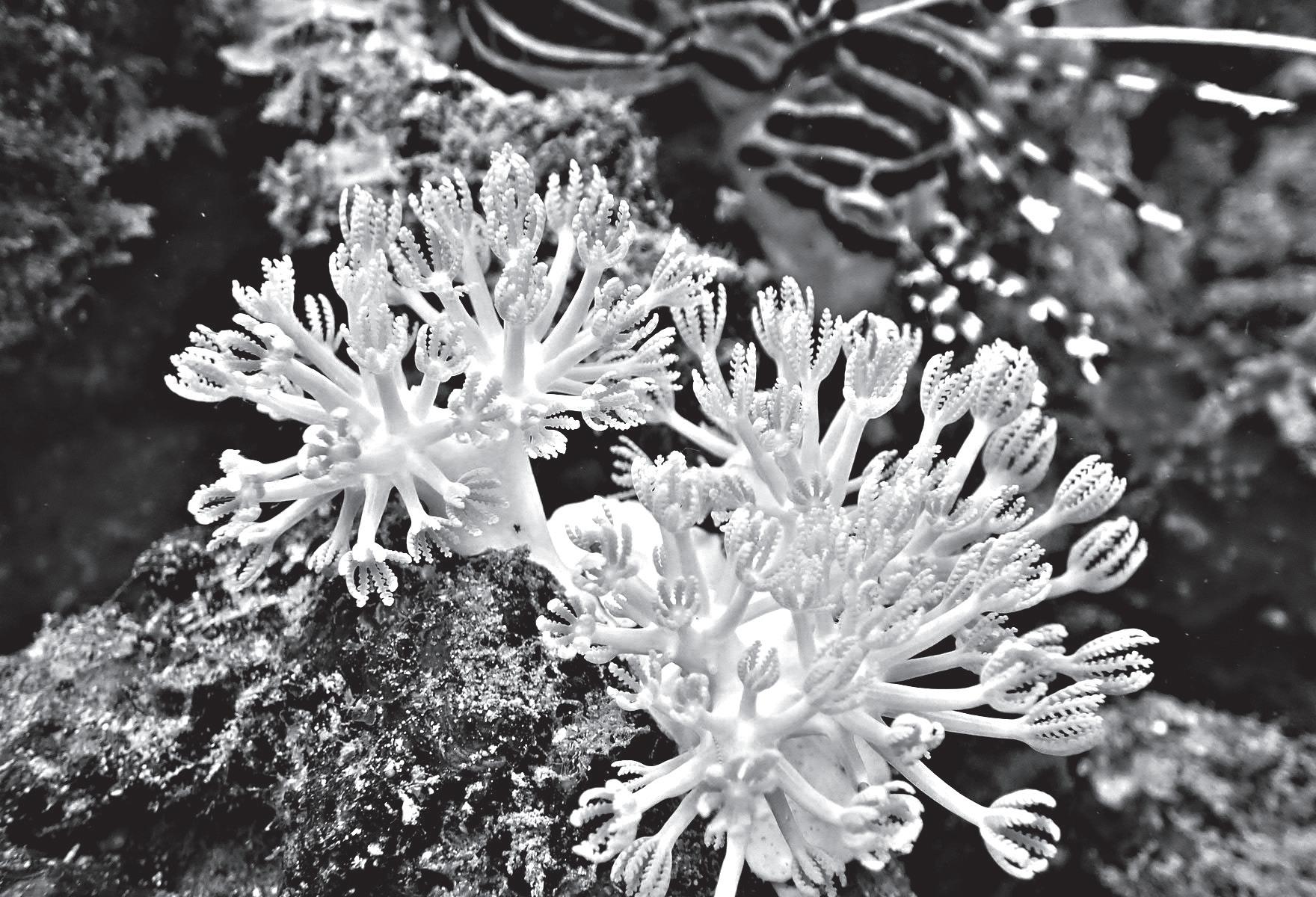
Laboratory, led by Dr. Maria Vanessa Baria-Rodriguez, the report’s other Filipino co-author.
4,000 samples
SPEARHEADED by Dr. Catherine McFadden, the study used DNA barcoding to analyze over 4,000 samples. Two single-locus barcoding markers, mtMutS and 28S rDNA, were used.
By assigning molecular operational taxonomic units to the specimens, patterns in diversity and endemicity revealed the IndoAustralian archipelago and the Western Indian Ocean as centers of species richness for soft corals.
“There are just very few papers on soft corals in the Philippines, despite them being dominant components of Philippine coral reefs,” Lalas said.
He said one of the reasons for this is the lack of people working on soft corals as compared to hard corals.
Soft coral trainings
BARIA-RODRIGUEZ is trying to fill this gap in the Philippines. In 2019, members of the IMBiBE lab that she headed, were trained by Dr. Yehuda Benayahu, one of the foremost experts on soft coral taxonomy, on basic soft coral identification and taxonomy.
Since then, the IMBiBE lab has published studies that further improved understanding on
Renewable energy will lower electricity prices in the long run
NCREASING the share of renewable energy (RE) in the Philippines’ power generation mix marks a strategic shift away from costly and volatile fossil fuels, and in turn, will lower electricity prices in the long run, the Department of Energy (DOE) emphasized in a briefing on June 25.
“We’re focused on ensuring that the transition delivers on its promise of affordability, reliability, and energy security,” said Energy Undersecretary Rowena Cristina Guevara, in a media “kapihan” (discussion over coffee) organized by Clean, Affordable, and Secure Energy for Southeast Asia Philippines.
“Renewables have no fuel costs. That means less exposure to price shocks from global oil and gas markets. With every solar or wind project we bring online, we reduce our dependence on imported fossil fuels, making our energy system more resilient,” she added. There is unprecedented momentum for RE investments, said Guevara, as the DOE awarded 1,392 renewable energy service contracts in April 2025, amounting to a potential capacity of 152 gigawatts.
“Mechanisms, such as the Green Energy Auction [GEA] Program, ensure that we procure RE at competitive prices—lowering electricity rates, encouraging new players, and ensuring a more level playing field,” she said.
Assuming that all GEA projects

go online and the priority dispatch of renewables, Guevara shared simulations from the Independent Electricity Market Operator of the Philippines on the potential impact of increased renewables on spot market prices by 2050. These model-based projections indicate that a balanced supply and demand scenario can reduce the spot prices significantly:
n In Luzon, from P4.95 per kilowatt hour (kWh) in 2026 to P0.28/kWh in 2050; n In Visayas, from P5.28/kWh in 2026 to P0.48/kWh in 2050; and n In Mindanao, from P4.06/kWh in 2026 to P0.36/kWh in 2050.
With renewable energy expected to comprise a large share of the generation mix by 2050, other grid resources such as storage, flexible capacity, and demand-side management are needed to reduce
prices and support reliable system operation.
This will also lessen the country’s exposure to automatic passthrough costs brought by reliance on fossil fuels, resulting in more predictable and affordable electricity pricing for Filipinos.
In 2024, BloombergNEF ranked the Philippines as the second most attractive emerging market for RE investments.
This sends a signal that the Philippines, with its strong policy framework and technical knowledge, is ready to accept more investments to advance the energy transition, said Executive Director Angelo Kairos de la Cruz of the Institute for Climate and Sustainable Cities.
“Everyone is ready to make the jump, but wanting to jump can be hard, and you need a push. For businesses, derisking instruments and tempering interest rates are
crucial, and the DOE is already making strides in laying these out,” de la Cruz said.
In addition, access to concessional finance can further be integrated to lessen the risks for local banks.
“We also need to have the concept of bankability translated at various levels, such as the community and household level. Investments and bankability should not only focus on big players when we know that the just energy transition should cut across various levels,” de la Cruz added.
Linking policies with international research and development will also help reduce risk for RE investments, said Frederic Tesfay, Team Lead for Energy Projects in GIZ Philippines.
“While the Philippines’ physical geography makes energy expansion difficult, the energy transition will provide an opportunity for new technologies and new knowledge to come in. It is important to build relationships with other countries and investors to provide a space where funds and knowledge can flow,” Tesfay added.
“The success of our energy transition depends not just on policy and technology, but also on people. On awareness, understanding, and public support. And you—our colleagues in the media are crucial to making that happen. When the public is informed, change is possible,” Guevara pointed out.
the distribution and ecology of soft corals in some parts of the Philippines.
In 2023, another training was organized on soft coral taxonomy and basic identification, which included participants from UP MSI and other partner local universities.
The authors of the report believe that improving soft coral science in the Philippines will open more opportunities to understand the true diversity and ecology of the country’s waters.
High diversity, endemicity
THE study’s authors hypothesized that there are likely more species in the West Philippine Sea, South China Sea, and Red Sea, which were not detected by their methods.
“We have undoubtedly underestimated the number of species for these taxa,” the study states. Lalas is optimistic many discoveries are still to be made, not just in the West Philippine Sea, but in Philippine waters as a whole.
“If you look at the study more closely and the literature on Philippine soft corals, we have yet to explore their diversity in most of the Philippine seas. This represents an opportunity for coral reef scientists in different parts of the
country,” he explained.
Resilient to climate change
LALAS pointed out that more people are starting to realize the importance of soft corals, especially with the changes brought by climate change.
“In some disturbed sites in the Indo-Pacific, some studies have reported a shift to the dominance of soft corals. They have been generally reported to have high resilience to disturbances. However, soft corals may also eventually be subjected to mortality if stressors persist,” he said.
“Overall, soft corals can serve as useful indicators of environmental disturbances,” he added.
“Ongoing research continues to shed light on their ecological roles in coral reefs amid global and local changes,” Lalas pointed out. The study was a big step forward in establishing a connection between Filipino soft coral researchers and experts from around the world, Lalas said.
More importantly, the study noted that it also highlights the role of the Philippines, including the Benham Bank and the West Philippine Sea, as critically important centers of marine biodiversity that must be protected.
CDC, Clark Water join Clark Freeport in 2025 Clark-Mabalacat-Angeles Road clean up
IN celebration of Philippine Environment
Month this June, various companies within the Clark Freeport Zone spearheaded the annual Clark-Mabalacat-Angeles Road (CMAR) Clean-Up Drive. Clark Development Corp. (CDC), in collaboration with the Environmental Practitioners Association (EPA), Clark Water Corp. (CWC), and Prime Waste Solutions Pampanga Inc. (PWSPI), led the activity.
The clean-up covered a 6-kilometers from SM City Clark to the Clark Mabalacat Gate, mobilizing over 200 volunteers from various companies within the freeport zone.
The initiative aimed at promoting environmental stewardship and enhance the cleanliness and visual appeal of CMAR, a key access road that is often affected by indiscriminate waste disposal from nearby residents and motorists.
PWSPI sponsored the hauling and proper disposal of the collected waste, which amounted to 2,880 kilograms.
As the event’s hydration partner, CWC provided three hydration stations to ensure participants remained refreshed and energized throughout the activity.
EPA member companies from TECO Industrial Park in Magalang, Pampanga, also joined the effort, demonstrating their commitment to environmental responsibility.
Several companies, including Acciona EEI-JV, Aderans, Tanitec, and Evertrust, generously provided refreshments for all participants, fostering a spirit of camaraderie and community support.
This collaborative effort exemplified the Filipino “bayanihan” (community) spirit, with stakeholders working together to protect and preserve the environment.
Participants included representatives from EPA member companies and Clark Freeport Zone locators. Among the organizations with more than 20 volunteers were CDC, Acciona EEI-JV, and Global Gateway Development Corp. Philippine Branch, who focused on cleaning areas near their respective work sites. Other participating companies included Hann Philippines, HPI, Evertrust, Anasco, SRCI Mfg Inc., University of the Philippines Clark, Nanox Philippines Inc., Lufthansa Technik Philippines Inc., Aderans Philippines Inc., Filinvest Mimosa Inc., KMS, Tanitec, the local government of Mabalacat City, City Environment and Natural Resources Office, and Outback Five Star Philippines.

The soft pulse coral, called as such because it uses its “hands” to “pulse” away water. It is from genus Xenia sp. found in Puerto Galera, Occidental Mindoro.
THE soft coral samples used for the study were collected from all over the world. The size of the circles indicate the number of samples from that area and the colors denote different marine provinces. The circles for the West Philippine Sea and Philippine Rise (formerly known as
ENERGY Undersecretary Rowena Cristina Guevara in a media “kapihan” organized by Clean, Affordable, and Secure Energy for Southeast Asia Philippines on June 25. PHOTO COURTESY OF ICSC
Coventry makes 1st big decision on first day as president of IOC
GENEVA—India’s push toward winning the 2036 Olympics hosting contest seemed to stall a little on Thursday in the first big decision of Kirsty Coventry’s International Olympic Committee (IOC) presidency.
Coventry paused the fast tracking of a preferred bidder —a signature policy of her predecessor and mentor Thomas Bach—in a concession to IOC members who have wanted more say in decisions under new leadership.
“Members want to be engaged more in the process” of picking Olympic hosts, Coventry acknowledged, citing “overwhelming support” at meetings this week to stop and review how it is done and when.
India has been seen as gaining momentum in the 2036 race that involves at least 10 bidders in talks including Qatar, Saudi Arabia, Indonesia and Istanbul in Turkey.
In her third full day in office, Coventry promised to create two working groups—to look at how hosts are chosen, and a second analyzing how to “protect the female category” after controversy in women’s boxing at the 2024 Paris Olympics.
Los Angeles Olympics
THE two-time Olympic champion swimmer also restated a principled vision ahead of the 2028 Summer Games in the city of Los Angeles, which US President Donald Trump this month called “a trash heap.”
“We see the best of humanity, we see compassion for others” in Olympic values, Coventry said at a news conference after chairing her first executive board meeting over two days.
“If we can celebrate in the diversity that we are, and that we have, we can really work towards creating something great,” the former sports minister of Zimbabwe said, pledging to try to inspire young people.
Olympic officials from LA met with Coventry’s board Wednesday and promised a “unity of effort” in the city where the Trump administration deployed military forces after street protests against immigration raids.
“There is so much goodwill from all levels of government,” Coventry insisted, including federal.
“That gives us faith,” she said, that a platform for the Olympics “will be there for us to ensure that our values are stuck to but that our values will also be heard.”
2036 Olympics decision
AFTER Los Angeles in 2028, the 2032 Summer Games will go to Brisbane which was picked 11 years ahead of time in the most secretive of modern hosting decisions. Bach aimed to avoid expensive bid campaigns and contested votes that could lead to negative headlines: rejection by local voters
Escamis, Belen Collegiate press Corps’ top picks
or allegations of vote buying.
Instead, the IOC administration talked discreetly with potential hosts with no set timetable to deal exclusively with a bid well-connected in Olympic circles.
Under this system, an India bid for 2036 promoted by influential IOC member Nita Ambani, from the family that is the richest in Asia, has looked strong.
However, Coventry’s strongest opponents in a seven-candidate election she won in March promised to consult more with their 100-plus IOC colleagues than was the case during Bach’s tightly controlled 12year presidency.
Her presidency started Tuesday in closed-door sessions with more than 70 IOC members in Lausanne. The result is a reset for the 2036 contest.
Still, Coventry confirmed, a bid team from India will continue to make a scheduled visit to the IOC next week.
Athletes election
OLYMPIC gold medalists are among 11 candidates for two vacancies to be IOC members when athletes vote at the Milan-Cortina d’Ampezzo Olympics in February.
Chinese pairs figure skater Cong Han, Canadian ski cross racer Marielle Thompson, Ukrainian aerials skier Oleksandr Abramenko and Swiss cross-country skier Dario Cologna will be on the ballot.
The two winners will be IOC members for eight years through the 2034 Salt Lake City Winter Games.
2012 Olympics medals
AMERICAN 1,500-meter runner Shannon Rowbury was formally confirmed as the bronze medalist from the 2012 London Olympics nearly 13 years later.
The IOC reallocated the medals to take account of a doping ban for Tatyana Tomashova imposed in September by the Court of Arbitration for Sport. Rowbury crossed the line in sixth place in London in a race notoriously tainted by doping cases for the runners who placed first, second and fourth. Abeba Aregawi of Ethiopia was upgraded to silver on Thursday. The gold medal was previously awarded to Maryam Yusuf Jamal of Bahrain. AP


Women battling cancer find hope in Va’a canoe
RIO DE JANEIRO—
When breast cancer turned her life upside down, Anna Lucia Amorim, a 63-yearold Brazilian from Rio de Janeiro state, fell into a deep depression sometimes struggling to get out of bed. But everything changed, she said, after she started practicing Va’a canoeing in Niteroi, a city facing Rio across Guanabara Bay, with other women who have battled cancer or were undergoing treatment.
“Every time you put the paddle in the water, it’s like a new life,” she told The Associated Press on Thursday. “When you are there, you forget everything. You only see the sea
Amorim is part of Va’a Roses, a group of cancer patients and survivors between the ages of 52 and 70 who partake in local and national competitions of Va’a canoeing. Originating in the Pacific region, Va’a canoes—which traditionally have outriggers and can be single or double-hull—are now popular worldwide.
In Niteroi, the Va’a Roses train twice weekly just after 7 a.m., departing from the sheltered Charitas Beach surrounded by harbors and sloping mountains, from which one can spot the famed Christ the Redeemer statue.
Guanabara Bay has a reputation for being polluted by garbage and sewage, but members of the Va’a Roses say they regularly see turtles,
rays and other fish—even dolphins.
“You wouldn’t think that Guanabara Bay has so much life,”
said Flavia Bichara, a 52-year-old lawyer who is currently undergoing chemotherapy for lung cancer.
She said the hope of spotting a turtle and watching the sun rise gives her ample motivation to get out of bed early. “The sunrise, for us, symbolizes coming back to life,” she said.
Polynesian canoeing and water sports in general have become increasingly popular in Niteroi over the last few years, said Isabel Swan, the municipality’s deputy mayor who has an Olympic bronze medal in sailing. The number of Polynesian canoeing clubs in the area has jumped from five to around 40 in the last decade.
the Covid-19 pandemic, because people can practice water sports while complying with social distancing rules,” she said.
In August, Niteroi will host the Va’a long distance world championship in which around a thousand athletes from 30 countries will compete. And alongside Rio, the city is a candidate to host the 2031 Pan American Games. Estella Tourl, 68, was diagnosed with breast cancer four years ago. As well as the stunning setting, she says she loves the social aspect of the activity.

and in the middle of it all was Finals MVP Escamis thus earning this year’s Collegiate Men’s Basketball Player of the Year. Belen was the hands down choice as UAAP Women’s Volleyball Player of the Year after towing the Lady Bulldogs to back-to-back titles and third crown in four seasons laced by three Season MVP citations as well. Escamis, NCAA Rookie-MVP in Season 99, brought Mapua to the title after sweeping the College of Saint Benilde Blazers i historic Season 100 behind averages of 24.5 points, 4.0 assists and 4.0 steals.
Serving as his counterpart is two-time UAAP MVP Kacey Dela Rosa, this year’s Collegiate Women’s Basketball Player of the Year. De la Rosa led the league in runaway fashion with 22.1 points, 16.0 rebounds, 2.3 assists and 3.7 blocks per game in UAAP Season 87. She posted double-double numbers in all 15 games she played for Ateneo.

Building a case as one of the best volleyball players in the country, Belen graduated from the UAAP with an unrivaled resume marked by eight championships and five MVPs since high school. Leo Aringo, Belen’s counterpart at NU, is also in league of his own as the UAAP Men’s Volleyball Player of the Year citation after anchoring the Bulldogs to five straight championships against top-seed Far Eastern University and winning the Finals MVP award as his grand swan song.
Belen since then rose as the No. 1 pick in the 2025 Premier Volleyball League Draft while Aringo took his talents to Japan to fly the flag high. Over at the NCAA, Finals MVP Carl Berdal led the Arellano University Chiefs to their firstever volleyball championship with a 2-0 sweep of the Letran Knights behind his 17.5 points to be hailed as the NCAA Men’s Volleyball Player of the Year. Then there’s the NCAA Women’s Volleyball Player of
“This boom occurred during
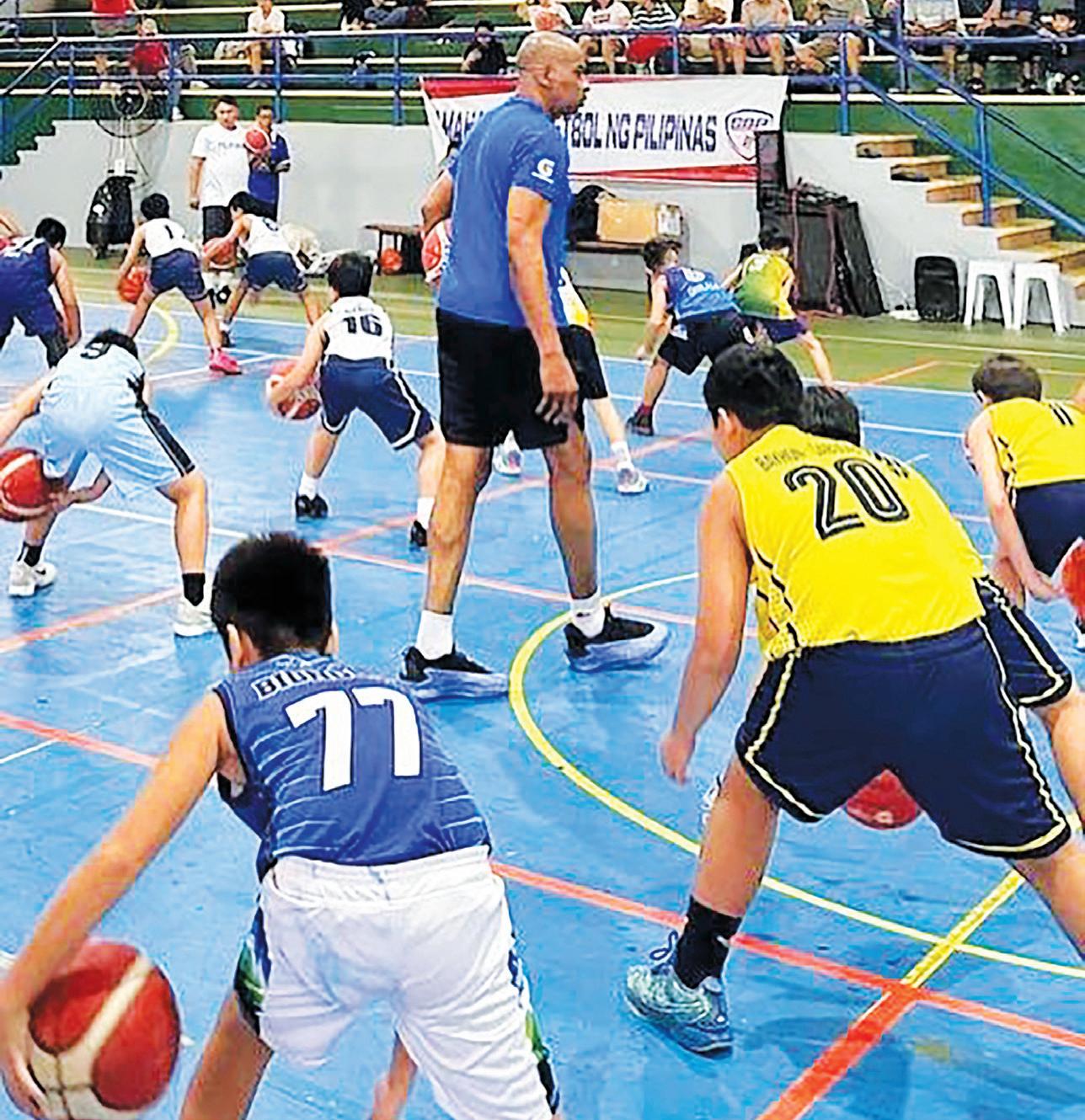
SBP-sports drink brand tie up
THE Samahang Basketbol ng Pilipinas (SBP) sealed a new partnership with Gatorade in support of its Talent Identification and Development Program and Coaches Academy.
“We are thrilled to collaborate with a globally respected brand like Gatorade,” SBP Executive Director Erika Dy said. “Beyond providing essential hydration, Gatorade brings a wealth of expertise in sports science and athlete performance.”
“This partnership allows us to tap into their knowledge and best practices, which will greatly benefit our programs and the broader basketball community,” she added.
As part of the partnership, Gatorade will integrate hydration and performance education into both the
Talent Identification and Development Program and the Coaches Academy.
In addition, Gatorade will provide strategic support and resources to help enhance the reach and impact of these initiatives.
The brand will also serve as the exclusive sports drink of the SBP’s Grassroots Development Program.
Coach Norman Black heads the Talent Identification and Development Program and is open to both boys and girls in the Under-16 age group— several free camps are scheduled around the country every year.
Coach Jong Uichico heads the Coaches Academy that aims to equip coaches for different levels of basketball training and strategizing. The coaches under the program are also accredited by the SBP.
“We’re in nature, we exercise and we talk. Afterward everyone sits together, we have coffee and laugh. It’s stimulating—we want to live,” Tourl said. AP
THE Rosas Va’a Hawaiian canoeing team, whose members are women who have undergone cancer treatment, train near Charitas Beach in Niteroi in Rio de Janeiro state. AP
MAPUA’S Clint Escamis and National University’s Bella Belen
president Kirsty Coventry speaks during the opening of the executive board meeting at the Olympic House in Lausanne. AP


HOW TO MANAGE CLIMATE ANXIETY AND BUILD RESILIENCE
The emotional toll of climate change is broad-ranging, especially for young people
JUNE 29, 2025 | soundstrip.businessmirror@gmail.com
HEARTACHE & HEALING
Kiana V sings for women who stayed too long—and finally left
Story by Justine Xyrah Garcia
Falling out to fall back in How to break a bad habit When it’s good, it’s impossible to let it go
Filipina R&B artist Kiana V returns with “Falling Out,” a soulful slow jam that leans into the messiness of toxic love—and the quiet strength it takes to walk away.
Released as the first single off her upcoming full-length album, the track marks a turning point for Kiana, not just as a musician but as a woman choosing herself after years of unlearning emotional patterns that no longer serve her.
“I hope that they see themselves in it and they’re able to live in the moment a little more and try to avoid making bad decisions that lead to more bad decisions,” Kiana said in a media roundtable with BusinessMirror's SoundStrip and other media organizations.
Beyond introspection, she also hopes it becomes the kind of song people play at intimate get-togethers—

Publisher :
T. Anthony C. Cabangon
Lourdes M. Fernandez
Editor-In-Chief :
Concept :
Aldwin M. Tolosa
Y2Z Editor :
SoundStrip Editor : Group Creative Director : Graphic Designers :
Jt Nisay
Edwin P. Sallan
Eduardo A. Davad
Niggel Figueroa
Chow Jarlego
Contributing Writers :
Tony M. Maghirang
Rick Olivares
Jill Tan Radovan
Reine Juvierre S. Alberto
John Eiron R. Francisco
Pocholo Concepcion
Francine Y. Medina
Justine Xyrah Garcia
Bea Rollo
Trixzy Leigh Bonotan
Bless Aubrey Ogerio
Photographers :
Bernard P. Testa Nonie Reyes
Y2Z & SOUNDSTRIP are published and distributed free every Sunday by the Philippine Business Daily Mirror Publishing Inc. as a project of the
The Philippine Business Mirror Publishing, Inc., with offices on the 3rd Floor of Dominga Building III 2113 Chino Roces Avenue corner
Dela Rosa Street, Makati City, Philippines. Tel. Nos. (Editorial) 817-9467; 813-0725.
Fax line: 813-7025
Advertising Sales: 893-2019; 817-1351,817-2807. Circulation: 893-1662; 814-0134 to 36. www.businessmirror.com.ph
something friends can vibe to when they’re together
According to the 31-year-old artist, the inspiration for "Falling Out" came after a conversation with friends who, like her, had been through their share of complicated relationships.
Kiana recalled how their stories mirrored her own, almost uncannily—different people, same patterns.
"That's when it hit me that just this group of girls, we've all been through the same thing. And I felt like I had to write a song about that moment, for that realization," she explained.
Sonically, the track blends soft, early-2000s R&B vocals with smooth production, setting the mood for a reflection on letting go.
But at its core, Kiana said it’s a reminder to prioritize one’s own worth.
“Don’t bleed yourself dry for anyone that isn’t willing to do the same for you because then you’re left on the road alone,” she said.
Real love, she added, can only happen when it’s rooted in self-love.
For those still in unhealthy relationships, she acknowledged how hard it is to even name the situation for what it is.
Many people, she said, get so used to the pain that it starts to feel normal.
“I just think that when you’re able to see it for what it is, that it’s not good for you and it’s pulling out something in you that isn’t natural or authentic anymore, then some steps would be to lean on the right shoulders, right? To find support in your friends and family who love you," Kiana added.
Music as an escape
Over the years, Kiana has turned to songwriting as her safe space.
She began her career in her early twenties, releasing singles independently, and often poured her frustrations and grief into lyrics long before she could speak them out loud.
The songs, no matter how cringe they may sound now, served as reminders of how far she’d come—and what she shouldn’t return to.
“It’s a good reminder for me when I look back that I’ve really come so far. And honestly, I probably would have gone back to some of those bad toxic relationships if I hadn’t already written about them,” she said.
“It’s like, how could I go back to that if I’ve already sung this song with a bunch of people singing the lyrics back to me?”
Even when doubt creeps in, music remains her outlet.
“No matter how much I complain about or struggle with being a creative or a songwriter… I find myself with a pen in my notebook, and everything

that I’m mad about, I’ll end up putting it into a song anyway," she added.
More to come
Kiana’s upcoming album will feature 10 Englishlanguage tracks, all centered on emotional boundaries and self-respect.
She said much of the inspiration came from rewatching 90s TV shows and noticing how the women in them often stayed in unhealthy relationships.
“They kind of just stay a little hopeless,” she said. “Today, if you’re treated poorly, we respect our own boundaries and we’re out. We’re like, you know what?
I don’t have time for this.”
“It makes for good entertainment, but you
wouldn’t wish it on anyone,” she added, referring to how some fictional women would lose themselves in the cycle of one man after another.
As for what’s next, Kiana said she’s excited about potential collaborations.
At the top of her list is Kyla, whom she listened to growing up.
“I grew up listening to her music and I used to copy all of her runs… I always make jokes that she’s like one of my vocal coaches just because of how much I listen to her,” she said.
She also expressed admiration for Moira, Denise Julia, Jason Dhakal, and Juan Karlos.
“Manila’s like booming. It makes me so happy," Kiana said.

Kiana Valenciano
ANISAMA MANILA 2025
Celebrating anime music in style
Story By Ica Hontiveros-Cheng
Istill have to pinch myself every time I find myself in a concert featuring Japanese artists. Being an early fan of Japanese music (in the late 90s), which started with anime opening and ending themes, I was always the “weird” kid who would listen to anime songs instead of the latest boy/girl band. So whenever I find myself in a venue filled with anime fans such as myself, it is always such a validating experience.
And this is what AniSama Manila 2025 was all about—a celebration of anime music, featuring eight Japanese acts featuring FLOW, Ave Mujica, Hiroshi Kitadani, Toshiya Miyata, nobodyknows+, Ash Da Hero, MindaRyn, and Mayu Maeshima whose portfolio includes performing songs from popular anime such as One Piece, Naruto, Blue Lock, Code Geass, and so much more.
A nostalgic trip
The Naruto soundtrack has always had a special place in my heart since it was our playlist when we would drive around in our first (then new) car. The songs from FLOW, nobodyknows+ were all so nostalgic. My brother (who was my date for the concert) kept reminding me that Naruto was almost 20 years ago already! And seeing the video clips from the Naruto opening songs flashed on the screen just brought out all those nostalgic feelings!
I loved MindaRyn’s ‘SURVIVE’ from ‘Why Raeliana Ended Up at the Duke’s Mansion’ and although she didn’t play this song from her set (there were 8 artists who played 3 songs each) she instead performed a cover of the well-loved Voltes V theme song which played with clips from Voltes V Legacy playing in the background–the cheers of the crowd. And in case you needed a little reminder, Voltes V Legacy is the 2023 GMA 7 live-action adaptation of the beloved anime series. Seeing those clips played in the background as MindaRyn sang the opening song felt like a Filipino and Japanese love letter to the anime series.
I also appreciated her decision and the effort to learn a few Tagalog phrases, which she wrote on her palm. She chided herself when she realized that being caught up in her emotions while performing put her palm in front of the camera, with her Tagalog cheat sheet for all to see. I think that it was adorable.
FLOW also covered ‘CHA LA HEAD CHA LA’ from Dragon Ball Z, and it made me a bit emotional as it


reminded me that the author of Dragon Ball Akira Toriyama already passed away in 2024.
It is about all of us here
Another treat for fans was not just these eight acts performing three songs each, but there were also performances where all the artists were on stage,

it was like an all-star number! Much like the all-star performances at the noontime show ASAP! There were also memorable collaborations between artists. This was such a bonus and extra gift to the fans.
“AniSama is not just about us singing on the stage, but it is about all of us here,” MindaRyn told the crowd. And I think what she said was very fitting, the
live songs being played to such an energetic crowd, who sang and pumped their light sticks in the air, the songs were for them, they were for all of us, for each and every anime fan in the audience, and to their younger selves who used to just enjoy these songs by themselves but can now sing their hearts out with other fans just like them.
Anisama Manila 2025. Photos: Wilbros Live
HOW TO MANAGE CLIMATE
ANXIETY AND BUILD RESILIENCE
The emotional toll of climate change is broad-ranging, especially for young people
By
Leanne Italie
The Associated Press
NEW YORK—
Anxiety, grief, anger, fear, helplessness. The emotional toll of climate change is broad-ranging, especially for young people.
Many worry about what the future holds, and a daily grind of climate anxiety and distress can lead to sleeplessness, an inability to focus and worse. Some young people wonder whether it’s moral to bring children into the world. Many people grieve for the natural world.
Activists, climate psychologists and others in the fight against climate change have a range of ways to build resilience and help manage emotions. Some ideas:
Get active in your community
FEELING isolated? Find ways to connect with like-minded people and help nature, said climate psychologist Laura Robinson in Ann Arbor, Michigan. There are many ways to get involved.
Work locally to convince more residents to give up grass lawns and increase biodiversity with native plants, for instance. Help establish new green spaces, join projects to protect water, develop wildlife corridors, or decrease pesticide use to save frogs, insects and birds. Work to get the word out on turning down nighttime lighting to help birds and lightning bugs.
“I see people struggling with these emotions across the age range,” said Robinson. “I have parents who are themselves really struggling with their own feelings and really worried about their children in the future.”
Make a positivity sandwich
CLIMATE news and the onslaught of disaster and mayhem in general has become heavy and overwhelming for many with the rise of social media and mobile phone use. Try scheduling breaks from notifications on your phone or stepping back from the news cycle in other ways.
Consider the idea of a “positivity sandwich,” where you begin with a good piece of news, followed by a harder tidbit, then finish with a second feel-good story.
Model behaviors for your kids
PHOEBE Yu, 39, gave up a cushy job in


health technology to work on an MBA with a focus on sustainability. She started a business selling sponges made from the luffa gourd. And she does it all while raising her 6-year-old son with her husband in Fremont, California.
“I am generally a very happy person and I’m very optimistic. And I’m still that, but sometimes it becomes very difficult to manage. Like, what will happen and thinking about the long term,” she said. “At points, I’ve regretted bringing a child into this world, knowing how things could get much, much worse.”
Part of managing her own emotions is trying to model sustainable behaviors for her son while educating him on the importance of helping the environment. The family drives an electric vehicle. They don’t eat meat and have encouraged extended family to do the same. They recycle, compost and limit travel by air.
“I try to explain things to my son so he can at least have some understanding of how the world and the ecosystem works as a whole,” Yu said. “I do think kids are able to absorb that and turn that into some level of action.”
Remember: We’re all connected
BRITNEE Reid teaches middle school
they can feel fearful, but they’re like these go-getters of, ‘I’m going to make the change in this world.’ There’s kind of two truths at once where they feel scared but they also feel like, you know, I can do something about this,” she said.
“The timelines,” Reid said, “provided some good, rich conversations.”
Find the words to express your feelings
PSYCHOTHERAPIST Patricia Hasbach, just outside of Eugene, Oregon, has written several books on eco-psychology and ecotherapy and has taught graduate students on those topics.
“We incorporate nature into the healing process,” she said. “And we address a person’s relationship with the natural world. Certainly with climate change, eco-therapy has a huge role to play.”
One of her most important missions is helping people find their words to talk about climate change in pursuit of resilience.
‘A lot of times, the anxiety and the hopelessness come from a feeling of powerlessness. Collectively, we’re incredibly powerful.’
— Climate scientist Kate Marvel
science for Gaston Virtual Academy, a K-12 virtual public school based in Gastonia, North Carolina.
Reid participated in a pilot project for a free teacher tool kit on climate put together by the National Environmental Education Foundation and the Climate Mental Health Network, a collective of community advocates working on the emotional impacts of climate change.
The kit is full of ways to help teachers support students’ mental health and manage their own climate-related emotions. One of the exercises involves students documenting their interactions with the natural world in an environmental timeline. Laying it all out often stirs action, Reid said.
“They can be anxious, they can be angry,

“There have been some studies done that show an increased number of young people reporting concern, like 84 percent of young people in the US reporting concern about climate change, but only like 59 percent of them think that other people are as concerned as they are,” Hasbach said. That, she said, contributes to inaction and feelings of anxiety, depression or isolation.
You’re not one. You’re many CLIMATE scientist Kate Marvel, a physicist and author of the new book Human Nature: Nine Ways to Feel About our Changing Planet, urges people to think differently about their place in preserving the environment.
“A lot of times, the anxiety and the hopelessness come from a feeling of powerlessness. And I don’t think any of us is powerless,” she said.
“I think collectively, we’re incredibly powerful,” Marvel said. “The atmosphere cares about what all of us together are doing, and I think you can have much more impact if you think of yourself as part of the collective.”
n Cover photo by Maria Orlova on Pexels.com
EATON Fire evacuee Alyson Granaderos (left) sobs while trying to comfort her son, Ceiba Philips, 11, as he visits their home for the first time since the fire in Altadena, Calif, on February 8, 2025.
VISITORS walk down a ramp after climing Shark Vallery observation point in Everglades National Park, Fla., on November 20, 2024
LEGACY ON A PLATE
Casa Reyes Bistro Filipino expands with flavor and flair
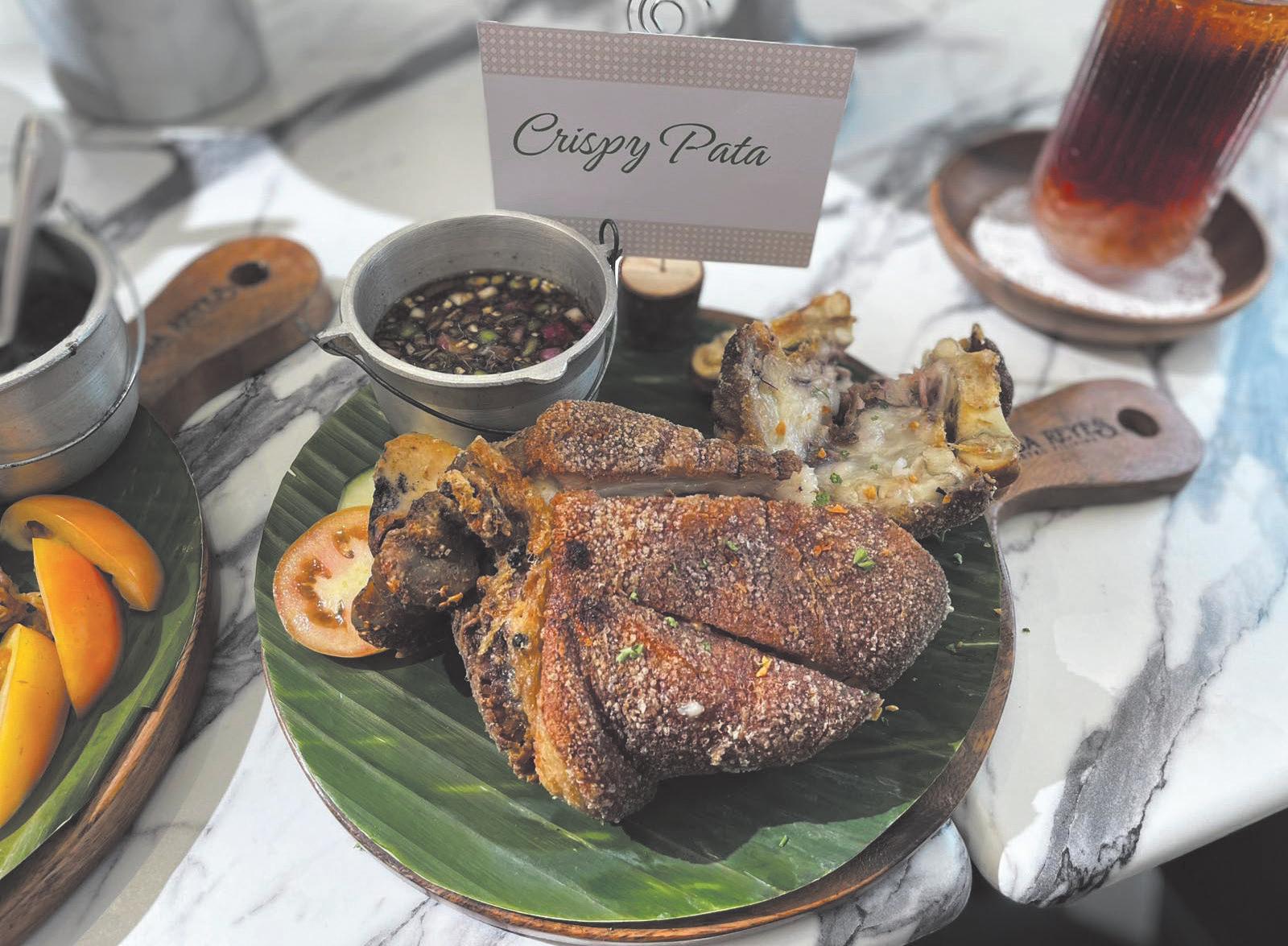
By Bless Aubrey Ogerio
WHO would have thought that a homegrown Filipino restaurant, known for its comforting heirloom recipes and deep-rooted culinary traditions, would still hunger to be a leading voice in Filipino cuisine?
This is exactly the vision shared by Christine Bautista, granddaughter of the legendary Teresita “Mama Sita” Reyes—the matriarch behind the iconic Filipino condiment brand—as Casa Reyes Bistro Filipino celebrated the grand opening of its third branch at Ayala Malls Manila Bay on May 28, 2025.
“I’m hoping [the restaurant will] be seen as an authority in Filipino cuisine,” Bautista said on the sidelines of the launch. “We now have modern Filipino cuisine,
Tbut I want to retain that authentic taste—the flavors of our earlier recipes. I want families and even foreigners to recognize them as typical, genuine Filipino dishes.”
The Casa Reyes journey began in 2006 in Greenhills, San Juan City, initially named Casa Reyes Restaurant. In 2015, the brand transformed, reintroducing itself as Casa Reyes Bistro Filipino, to show a nostalgic Filipino ambiance with antique decor. But even with its longevity, the
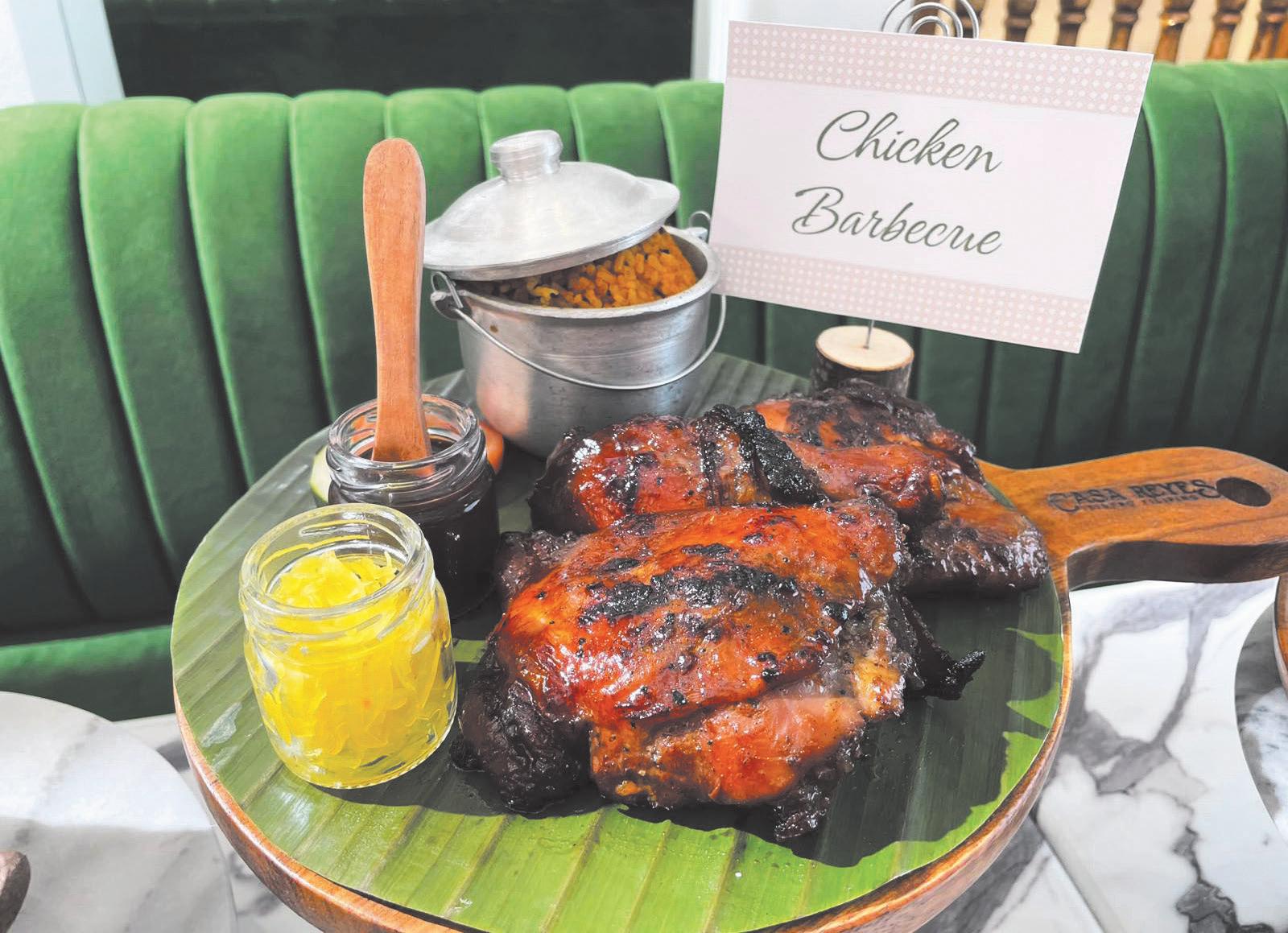
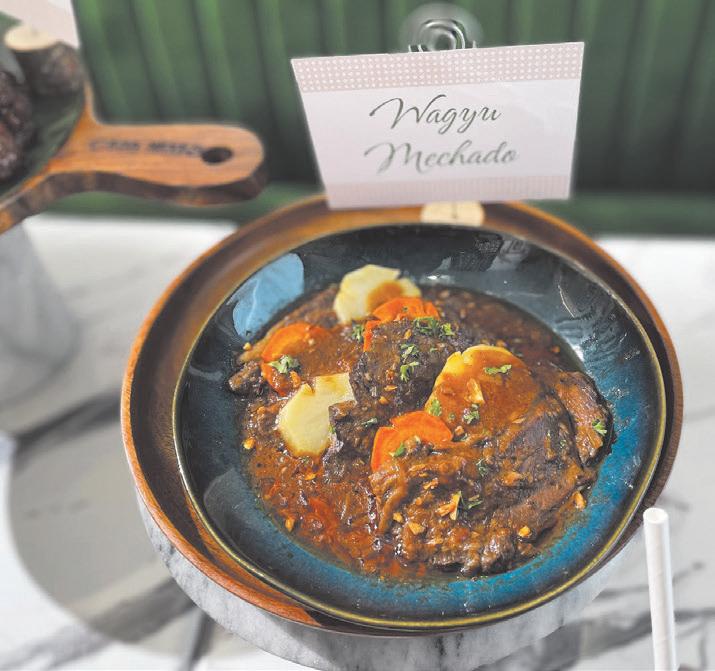
restaurant attributes its staying power to more than just the legacy of Mama Sita. For Bautista, it is their commitment to consistency and responsiveness that has helped them maintain their place in the culinary scene.
“Of course, we hear feedback from people,” she shared. “There are complaints sometimes, but we follow procedures. We correct them immediately when something goes wrong. We act at once.”
New look for the crowd
WHILE the core remains rooted in tradition, Casa Reyes is embracing
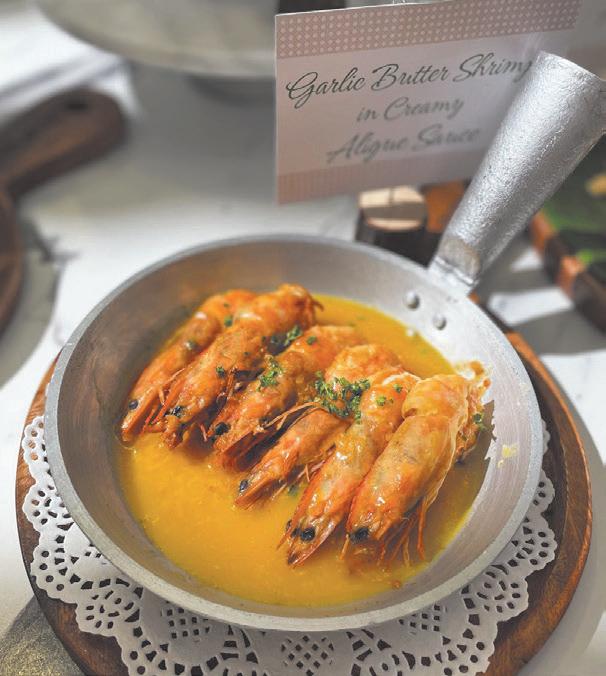
change, especially in its look and feel.
The newly opened Ayala Malls Manila Bay branch brings in a fresher, younger vibe with a modernized Filipino interior. Design consultants Chippy and Lex Ledesma of Studio Matthew lent their expertise to reimagine the space, incorporating earth tones, curated accents and Filipino home-style elements, even down to the utensils.
“We wanted to make it more modern and attract a younger crowd,” Bautista explained. “The ambiance in Greenhills still holds that vintage look, while Eastwood
Rosa: A fresh, heartfelt take with a twist on Filipino cuisine
By Rory Visco Contributor
HE world of food is ever evolving so culinary innovation is always at the heart of it all. As some would say, it takes more than just good food to make a lasting impression—there should be heart, heritage, and a healthy dose of imagination or reinvention.
And that’s exactly what Illo’s Hospitality Group (IHG) brings to the table with their newest concept, Rosa. This pure Filipino bistro pays homage not only to the divergent flavors known to many parts of the archipelago but also to the personal story behind its name.
“Rosa is our first foray into the all-Filipino food fare,” says Maq Agapito, IHG’s Chief Operating Officer, in an interview with BusinessMirror during the recent launch of Rosa located along Bradco Avenue in Parañaque City. “It’s an all-Filipino bistro, where all our dishes were inspired by food coming from different parts of the Philippines.”
Unlike their earlier ventures such as its popular party tray delivery service that offers Filipino, Spanish, and international cuisine, Rosa is a bold step toward deep cultural and emotional storytelling through food.
The party tray endeavor began humbly in December 2019, right before the world changed. “We started just a little before the pan-


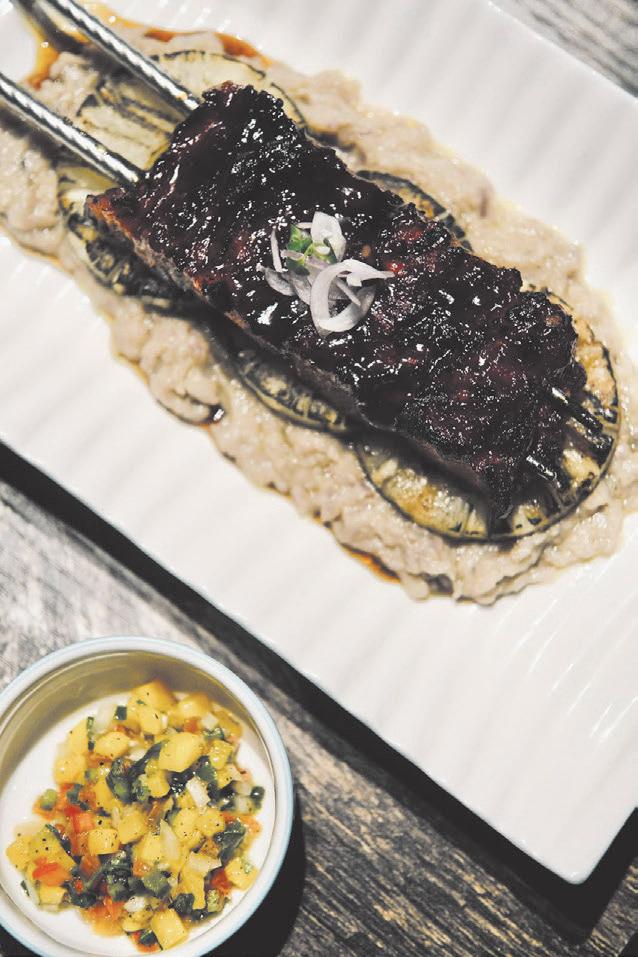
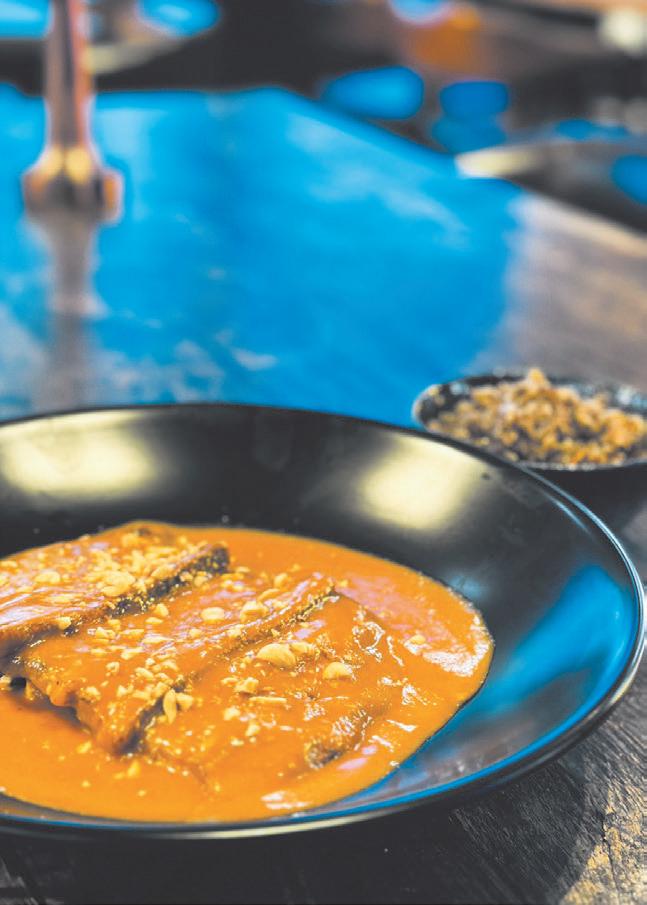
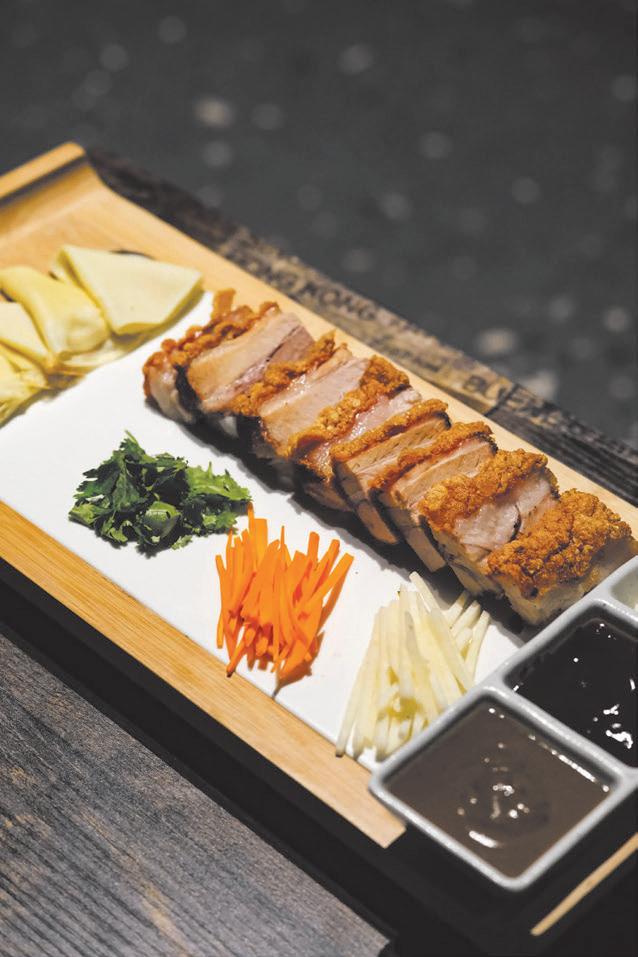
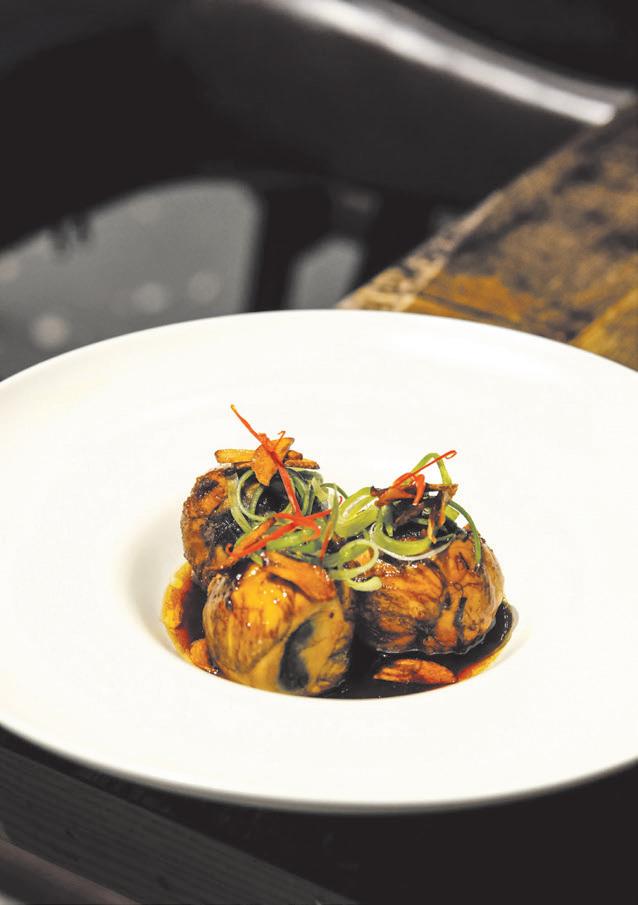
is a little bit modern. But this [new branch] is the more modern area.”
The new branch also introduces al fresco dining and was strategically chosen to cater to the South Metro Manila market.
The star of the show
THE spotlight remains on the food, which is Casa Reyes’ true crowdpuller. Their menu is a celebration of Filipino flavors, from street food staples to fiesta favorites.
To start, the tinapa and kesong puti lumpia with mango salsa is a standout appetizer. It strikes a perfect balance between the smokiness of tinapa and the gentle acidity of the salsa, with lettuce served on the side for a refreshing crunch.
Following that, the crispy adobong pusit offers both texture and depth. Its crunch holds up even when cooled, and the sauce served on the side ensures the flavor stays vibrant without compromising the squid’s crispiness.
Vegetable lovers will appreciate the pinakbet na bagnet, which brings together okra, ampalaya and sitaw in a light, savory sauce. It’s topped with crispy bagnet and chicharon bits for added richness and crunch, which is a comfort food in its purest form.
Among the heavier mains, the crispy pata makes a lasting impression with its golden, crackling skin and juicy meat. The soy dipping sauce cuts through the richness, balancing each bite with a salty edge.
Generous sauce EQUALLY satisfying is the beef mechado, simmered in a flavorful tomato-based sauce. While the beef and potatoes are prepared in a straightforward style, the generous sauce ties the dish together with traditional flair. The garlic butter chicken, served skinless and coated in a thick, glossy sauce, is visually ap -
demic, and then the lockdown hit in March. The menu wasn’t that extensive yet but eventually, we expanded,” Agapito shares. As gatherings shifted from physical to virtual, the party tray was a hit where they served comfort food and kept that human connection during uncertain times.
As the world reopened, so did their ambitions. Illo’s Home became the next evolution—a restaurant offering an à la carte version of their beloved dishes, followed by catering services as the economy opened up and families and friends managed to hold celebrations once more.
Then came the vision to create concept-driven restaurants under a new banner: IHG. “What we want is to put up concept restaurants, and Rosa is our first,” Agapito explains.
At Rosa, the food is as dynamic as the culture it represents.
“The menu is not fixed; it’s evolving. We change the menu every six months,” he says. This ensures that each visit to Rosa feels fresh, inventive, and rooted in the ever-shifting Filipino palate.
“In the food industry, it is very important to stay innovative,” Agapito continues. “People always want something new, and they always want first dibs on new food offerings.” With this in mind, Rosa becomes not just a bistro, but a creative playground where tradition meets transformation.
What’s in a name?
THE story behind the name is as tender as the dishes served. “We
pealing and comforting, though it leans on the simpler side in terms of flavor.
Meanwhile, the classic pork barbecue skewers are tender and aromatic, easily pierced with a fork and bursting with smoky, grilled goodness. Paired with fresh atsara and Mama Sita’s signature barbecue sauce, they deliver a quintessentially Filipino taste. Their kare-kare is another highlight, featuring ultra-tender meat that falls apart with ease— clearly the result of long, careful cooking. The sauce is thick and nutty, and when paired with their sweet bagoong, it becomes deeply satisfying.
Subtle smokiness
AS FOR the java rice, it holds its own with a subtle smokiness that pairs beautifully with almost every dish on the menu, making it more than just a side.
Also, no Filipino meal is complete without dessert, and Casa Reyes delivers on this front as well.
Their creamy gelato is rich and generously served, offering a cool, milky finish. Meanwhile, the hot tsokolate, made with traditional tablea, has a fragrant aroma and a perfectly balanced consistency— thick, but not overpowering, and leaning slightly sweet.
Still, personally, it’s the bibingka that steals the show. Soft, cheesy and just salty enough, it’s perfectly layered and indulgent, capturing the very essence of Filipino holiday nostalgia in every bite.
When asked if any dishes are exclusive to the new branch, Bautista clarified that they serve the same menu across all locations.
Building a culinary staple
IN A time when food trends come and go, Casa Reyes Bistro Filipino proves that heritage cuisine, when served with consistency, creativity and care, will always have a place on the Filipino table and beyond.
Looking ahead, the Casa Reyes team envisions its name becoming a staple in every Filipino’s culinary vocabulary. More branches are in the pipeline, and marketing efforts, including new promos and menu items, are in the works.
“We have plans to expand” Bautista shared. “We’re [also] working on new offerings and promotions very soon.”
named the place Rosa partly in honor of the wife of our executive chef, Chef N (Saturnino “Nino” Rovillos), who is also our CEO. Her name is Roseanne,” Agapito reveals. But the connection goes deeper than a nod to a loved one.
“When we were conceptualizing Rosa, Roseanne was going through a very delicate pregnancy. Eventually, she gave birth despite all the challenges so we consider that child a miracle baby,” Agapito shares. “So, Rosa is an ode to her strength as a woman, a mother, and a wife.”
But what sets Rosa apart from the others is the blend of culinary craft and emotional depth. Among the standout dishes is the Roast Beef Kare-Kare, a beloved staple from their party trays, now reimagined for dine-in. “Instead of the usual tenderloin beef, we used roast beef.” The twist brings a deeper, smokier flavor that enhances the traditional peanut sauce.
Another must-try is Isabelita’s Inihaw na Liempo Tocino. “It uses a liempo slab cooked tocino-style— not the usual processed tocino. Underneath, there’s mashed sweet potato with our unique mix, and it’s topped with mango salsa.” Agapito adds with an obvious beaming smile, “You have to eat it altogether to really get the full experience.” With Rosa, IHG offers more than just food—they offer a journey through Filipino culture, memory, and identity, wrapped in flavors both nostalgic and new. It’s a love letter to the Philippines, and to the people who make it home.
Editor: Anne Ruth Dela Cruz
Sinuteng Inihaw na Liempo Tocino
Mais na Pinalutong Roast Beef Kare Kare Balot Ala Pobre
Prichon Belly Set
Crispy Pata
Chicken Barbecue
Wagyu Mechado
Garlic Butter Shrimp in Creamy Aligue Sauce
Wine Dine&
Navigating culinary trends with Future Menus 2025

By Candy P. Dalizon Contributor
ON the heels of the successful launch of Future Menus 2025 in Thailand, Unilever Food Solutions (UFS) commenced a rollout of the 2025 edition of Future Menus in the Philippines via a dazzling launch event held last June 17, 2025 at the Avire Tower in Quezon City. At Future Menus 2025: The Taste Kitchen, this year’s report came to life as UFS chefs engaged food entrepreneurs from across the country, sharing diverse strategies to futureproof their businesses for the challenging, yet exciting, times ahead. The event, designed to stimulate all senses, also featured live cooking demonstrations where UFS chefs brought the report’s insights to life.
UFS Country Executive Chef Kenneth Cacho and Senior Sous Chefs Carlos Aluning, J. Brando Santos, and Paulo Sia were joined by award-winning chef Josh Boutwood in a series of industry talks discussing the four trends identified in Future Menus 2025 report.
UFS is the dedicated foodservice arm of Unilever, one of the world’s largest consumer goods companies. Essentially, they are a business built “by chefs, for chefs,” providing professional ingredients, services, and support to the culinary industry.
Future Menus, an annual initiative by UFS, is a leading trend-forecasting report and event dedicated to the future of food and culinary innovation. It curates top global foodservice trends, leveraging extensive data and chef perspectives to provide professionals with essential insights for developing profitable, efficient, and on-trend menus.
“In our 3rd year, Future Menus keeps growing. Because we get it: Keeping your menu trendy and inspiring is challenging when diner habits change so quickly. Chefs are constantly balancing the now and the next in the kitchen. With 250 chefs globally, Unilever Food Solutions knows what it takes to run a kitchen and stay ahead,” said Sheala Ang, Operator Experience Manager, UFS Philippines.
“By turning trends into real, sellable recipes, we help chefs create dishes—and guest experiences—that are fit for tomorrow,” she added.
More than a mere trend guide, the UFS Future Menus 2025 report is a comprehensive roadmap for culinary success in a rapidly evolving landscape. It features four global trends, supported by research, chef insights, and actionable tips, empowering operators to meet evolving diner expectations for creativity and innovation.
Street Food Couture
TRADITIONAL street foods are transforming into gourmet offerings across all foodservice channels, including fine dining, thanks to chef expertise. This trend is largely driven by Gen Z, with 65 percent prioritizing value in their dining experiences. Leveraging humble ingredients and techniques like charcoal grilling, steaming, and wok hei, chefs are elevating beloved favorites such as crepes, tacos, skewers, burritos, spring rolls, dumplings, bao buns, and Korean corn dogs. During the Taste Kitchen, Chef Aluning cooked Stuffed Chicken Wings with Minced Meat which he described as “an innovation on Japanese Kushikatsu.”
“These stuffed chicken wings are filled with seasoned minced meat, skewered, battered, and deep-fried. A light barbecue glaze balances sour, sweet, and savory flavors, offering a delightful combination of textures and tastes,” said Chef Aluning.
Diner Designed
DINER Designed champions personalize interactive, and multisensory culinary experiences. Driven by emerging technologies like AI (artificial intelligence) and AR (augmented reality), this trend puts diners in control through table-side cooking, 3D printing, build-your-own dishes, and blowtorching. With 47 percent of consumers now prioritizing experiences over material goods, UFS supports businesses with training, menu engineering, and seamless trend integration to meet the growing demand for custom flavors and im-
PAUSE, MIX, MATCH | CURATE YOUR OWN FOOD TABLE AT KIWAMI

mersive dining.
Demonstrating the Diner Designed trend, Chef Sia prepared Bistek Burger with Truffle Bistek Sauce.
“I wanted to offer a diner-designed experience by localizing the classic, American burger with the Filipino dish Bistek. This creation features various fillings, letting diners enjoy a beloved burger with a distinctly Filipino twist,” said Chef Sia.
Borderless Cuisine
BORDERLESS Cuisine celebrates the exciting fusion of global food traditions, driven by globalization, culinary tourism, and migration. This trend brings new flavors and ingredients to the table while honoring authentic techniques and cultural roots.
This results in creations that combine the old with the new, featuring standout ingredients like miso, kimchi, shiso, pomegranate, and calamansi to craft fresh, respectful, and truly unique culinary experiences.
Chef Santos transformed this concept into culinary reality with his exceptional creation, Beef Pares Tacos with Garlic Spring Onion Crema.
“Marrying comfort foods from Mexico and the Philippines, created Beef Pares Tacos. These tacos feature tender beef cooked pares style on soft tortillas, garnished with ensaladang talong, garlic-spring onion crema, calamansi, and cilantro,” said Chef Santos.
Culinary Roots
CULINARY Roots marks a significant return to indigenous ingredients and hyperlocal cuisines. This trend sees chefs delving into forgotten recipes and traditional techniques to honor the regions they cook in, celebrating and reviving lesser-known regional dishes.
The Culinary Roots trend emphasizes preserving the past while moving forward, ensuring authenticity remains at the heart of each dish. While this trend often originates regionally and may gain wider recognition, its success hinges on retaining its true cultural essence and connection to heritage.
Innovating a dish rooted in heritage, Chef Cacho prepared Halang-Halang na Manok (Spicy Chicken Stew in Coconut) to illustrate this trend.
“An innovative take on Tinola making it creamier and more flavorful with lemongrass and coconut milk. This Visayan dish literally translated as ‘spicy-spicy’ is enhanced with coconut milk, lemongrass, chilies, and optional basil leaves or dahon ng sili,” said Chef Cacho.
The tender chicken is cooked with Knorr Chicken Broth Base, adding a rich and savory flavor. Enhanced with Knorr Liquid Seasoning and Knorr Chicken Powder, it brings an elevated taste and aroma that makes this dish more special. Seasonings, broth bases, or mayonnaise were incorporated into all other dishes prepared during the event, enriching their taste and aroma.
“There are dishes we’ve grown to love that were passed down to us by our ancestors. Now, when you create something, you have to have a strong foundation where you create that innovation,” said Chef Cacho.
“Innovation is actually making food taste better, making food taste interesting,” he added.
Chef Cacho explained that sometimes, a traditional heritage dish might lack the robust flavor modern palates expect, perhaps just a simple broth from boiled bones.
“But innovating that taste by adding a few key ingredients to make it more vibrant and flavorful isn’t wrong; it’s simply an enhanced way of making food taste better,” he pointed out.
To cap off the culinary experience, guests enjoyed unique and surprising ice cream flavors like Salted Egg Pili, Potato Ice Cream, Tokwat Baboy, and Choc-nut Tablea, along with magically conjured chocolate creations from CMV Txokolat.
The next and final Metro Manila leg of The Taste Kitchen will go live in Pasay on July 15, before UFS samples Future Menus for key cities across the country, including Bacolod, Baguio, and Davao. The Future Menus 2025 Trend Report is now available for download.
By Vincent Peter Rivera
CRAVING Japanese food
while out and about in the midst of SM Mall of Asia, but struggling with which delicacies to choose? You’re in luck because you can have it all at once! Kiwami, the newest Japanese food destination, has officially arrived.
Kiwami: Japanese Master Kitchens is home to six of Japan’s master kitchens, each embodying the core of Kiwami’s multi-kitchen concept by offering distinctly specialized dishes and upholding a culinary philosophy of single-dish mastery, deeply rooted in Japanese culture and tradition.
True to its name, which roughly translates to “ultimate,” Kiwami ensures that quality meets delicacy. Each of its dedicated kitchen spaces is equipped with specialized equipment and staffed by Japan-trained chefs, whose sole focus is exclusively on mastering one iconic dish.
During its official launch at SM MOA on June 23, 2025 the food place opened its doors to its largest location to date, measuring over 700 square meters with a 250-seat capacity.
Upon entering Kiwami, a captivating “moment area” instantly sets the tone. Dominated by a large circular light casting a glow on a tree with vibrant yellow-orange leaves, this space’s purpose is to transition your mindset. Its sleek, ambient interiors embody modern Japanese minimalism, allowing you to reset from the bustling mall environment before indulging in the offerings from the six master kitchens.
Yabu YABU, a popular mainstay in the country’s food scene, is celebrated for its signature Tonkatsu. Founded in 2011, the restaurant’s success is rooted in its partnership with Michelin Bib Gourmand Chef Kazuya Takeda who perfected the art
Sparkle

of preparing this one iconic dish, meticulously selecting only the finest meats from trusted partners to guarantee the authenticity and excellence that define Yabu’s Tonkatsu.
Among its signature Tonkatsu dishes are: Kurobuta, made from Black Berkshire pork cured for 12 hours in a special Koji blend and served with a wasabi-plum sauce; Rosu, a thick and juicy pork cutlet with a flavorful trimming of fat; and Menchi, a mix of ground beef and pork cutlet with Yabu’s special spices and stuffed with cheese.
Ippudo
FOR anyone exploring Japanese cuisine, ramen is an absolute essential you simply can’t miss, and Kiwami has it ready for you through Ippudo.
Since 1985, Ippudo has been celebrated for its world-famous Tonkotsu Ramen, which translates to “pork bone” and is known for its creamy and milky-white broth. With the expertise of Ramen King Shigemi Kawahara, a three-time Ramen Master Chef Hall of Famer, Ippudo pioneered Hakata-style ramen, distinguishing itself with an imported 15-hour Tonkotsu broth, freshly made noodles, and Chashu that’s slow-cooked for 30 hours before being expertly torched.
Each piping hot bowl is served in custom “aritayaki” porcelain, crafted from pottery stone mined in Mount Izumi, Japan. These bowls reflect the brand’s deep commitment to tradition and unwavering quality.
One of Ippudo’s contemporary dishes, Akamaru, is a modern take on Hakata-style ramen featuring their signature 15-hour pork bone broth, paired with spicy miso paste and garlic oil, and generously topped with 30-hour slow-cooked Chashu slices.
Hannosuke RENOWNED Japanese restaurant chain Kaneko Hannosuke is a restaurant chain that specializes in
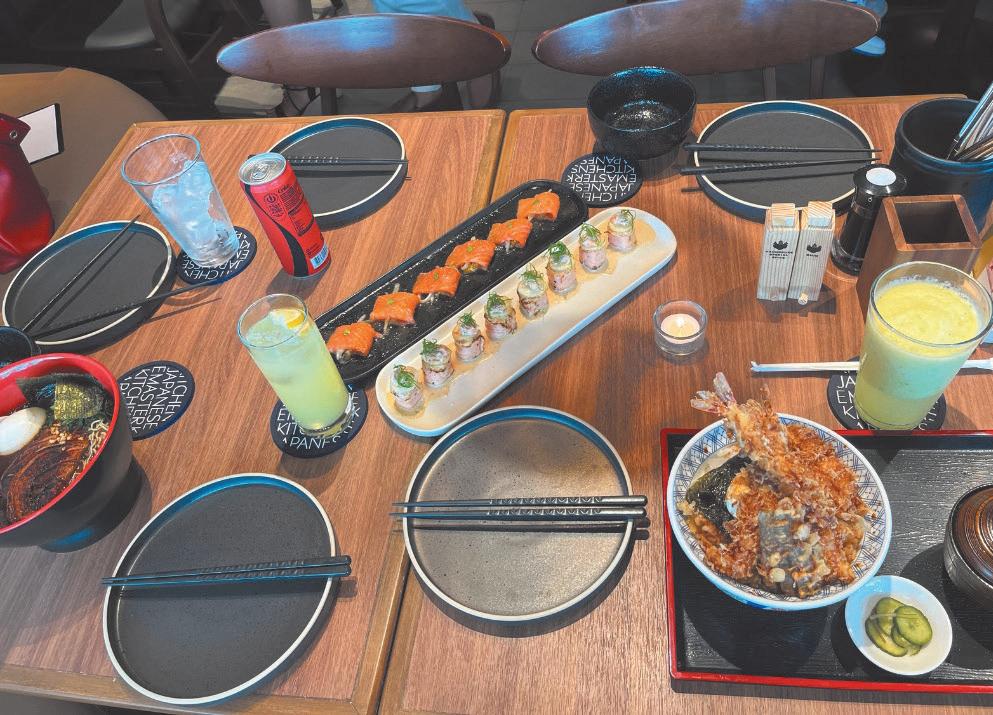
Tendon, a popular Japanese dish consisting of tempura served over a bowl of rice, typically drizzled with a savory-sweet sauce called tentsuyu.
What defines Hannosuke’s tendon is its use of sesame oil, specialty flour, and a generational heirloom tendon sauce passed down through the Kaneko family. These elements have made Hannosuke a symbol of culinary heritage, beloved for its light, crispy texture and timeless recipes.
The “Signature,” a house specialty, features two ebi (shrimp), squid and scallop kakiage, onsen tamago (hot spring egg), eggplant, and nori. It’s best savored by splitting the onsen tamago over the rice and adding spice to your preference.
Koyo Handroll bar ANOTHER staple in Japanese cuisine is sushi and Kiwami made sure to include it in its home through Koyo, a dedicated station for crafting exceptional sushi handrolls.
New York-based Filipino Chef Mark Manaloto is in charge of the reimagination and contemporary twist of Koyo’s sushi. By meticulously sourcing the finest ingredients, Koyo achieves a perfect balance of refinement and innovation, crafting bold and inventive handroll flavor combinations.
Each premium nori-wrapped roll is carefully prepared and packaged to ensure ultimate freshness and crispness, guaranteeing an exceptional experience with every bite.
Some of the crowd favorite sushi handrolls are California Crunch, Tuna Edamame, Unagi Tamago, and Ebi Katsu.
Yakitori Hachibei CHAR-GRILLED over Binchotan charcoal and ideal centerpieces for any meal, Kiwami’s Hibachi Shared Plates are a collaboration with Sydney-based chefs Max Smith and
and slay the way you want it with Maria

FBy Rory Visco Contributor
OR FOUR decades ago, Destileria Limtuaco
& Co. Inc. (DLCI) brought innovation to the cocktail red wine market with the introduction of Maria Clara Sangria, which served as a tribute to the timeless beauty and enduring spirit of the Filipina named Maria Clara, the iconic literary symbol of grace and strength. Over the years, the sweet, citrus-kissed classic has become a steady and constant fix at Filipino gatherings, a companion to life’s joyful moments, both big and small. And after 40 years, DLCI introduces a fizzy version of a classic Filipino favorite where Filipinos can get to sip, sparkle, and slay the way they want with Maria Clara Sparkling Sangria, a refreshing and sparkling new addition to DLCI’s legacy.
This exciting new variant will definitely delight loyal fans and even new drinkers alike with its signature sweet red wine and whisper of citrus, but now enhanced by a vibrant fizz to bring a whole new level of energy to the table—fun, refreshing, and always celebration-ready.
Douglas Barker. These former Cho Cho San alumni, with Michelinstarred experience from London, craft unique Japanese flavors for groups to share, making Kiwami a viable option for celebrations and shared dining experiences—beautifully culminating both Japanese and Filipino culture.
Meanwhile, since its inception in 1983, Hachibei, under Chef Katsunori Yashima’s expert guidance, has set the global standard for Hakata-style yakitori. Their unwavering commitment to the art is evident in the distinctive use of Binchotan charcoal, which enhances flavor and aroma. Every meticulously crafted dish, from premium ingredient selection to precise preparation, embodies their dedication to authentic Japanese culinary traditions and craftsmanship.
A must-try in this master kitchen is the Hanger Steak grilled in Binchotan, drizzled with black garlic miso sauce, leeks in ginger vinaigrette, and wasabi.
Hokkaido Soft Cream TO complete the dine-in experience, Kiwami features Hokkaido Soft Cream, a master kitchen dedicated to desserts. This venture operates under the helm of John Concepcion—CEO of The Standard Hospitality Group (Kiwami’s owner) and former Managing Director and CEO of Selecta ice cream. The Maple Honeycomb Sundae is one of its specialties, renowned for its rich, milky, and creamy texture derived from Japan’s high-quality Hokkaido dairy. It is topped with honeycomb sweets and is paired with a cylindrical wafer stick.
Kiwami stands as the perfect destination for all Japanese food lovers, offering the best of diverse culinary worlds under one roof. Whether dining solo or with a group, you can truly enjoy curating your own table from the distinct offerings of its master kitchens.
Clara Sparkling Sangria
The sleek, 330-ml aluminum can provides Maria Clara Sparkling Sangria drinkers a drink that is light, lively, and easy to enjoy— perfect straight from the fridge, poured over ice, or sipped directly from the can. With seven percent alcohol by volume (ABV) (14 proof), it delivers just the right buzz for sunny escapades, spontaneous hangouts, rooftop sunsets, or cozy nights in.
Convenient and being ready to drink is what made Maria Clara Sparkling Sangria a sure-fire hit for on-the-go individuals. For those who juggle meetings, events, or weekend plans, Maria Clara Sparkling Sangria offers a no-fuss, all-fun option—and definitely no corkscrew needed.
“We made it sparkling and we put it in a tin can to appeal to the younger Gen Z market since they’re into the fast-paced lifestyle. They love convenience that they can bring their drink anytime, anywhere and enjoy it. We even made it lighter at seven percent ABV, and we added some fizz to it so it’s carbonated. We believe the young generation will like it because it’s refreshing,” explains Olivia “Olive” Limpe-Aw, President and Chief Executive Officer of DLCI, the country’s oldest distillery and maker of world-class brands like White Castle Whisky, El Hombre Tequila Flavored Spirit, and Napoleon VSOP Brandy, in an interview with BusinessMirror. Just like any new product, Maria Clara Sparkling Sangria, Limpe-Aw
The facade and moment area of Kiwami: Japanese Master Kitchens Yabu
Some of the Japanese food offerings from the master kitchens of Kiwami.
In the photo are, from left, UFS Senior Sous Chef Carlos Aluning, Country Executive Chef Kenneth Cacho, award-winning chef Josh Boutwood, UFS Senior Sous Chefs J. Brando Santos, and Paulo Sia
Wine Dine& BusinessMirror
CONSISTENT FROZEN SOLUTIONS HOSTS EXCLUSIVE LAUNCH WITH OPEN KITCHEN EVENT

By Candy P. Dalizon Contributor
FOR dishes like Pork Belly Sinuglaw, Sukiyaki, and Steak Rice Bowl, it’s the high-quality meat, often serving as the star ingredient, that makes them truly delectable.
Take Sinuglaw, a uniquely Filipino creation. This dish masterfully combines “sinugba” (grilled) and “kinilaw” (ceviche), typically featuring cubed grilled pork belly mixed with fish ceviche, often tuna. The interplay of smoky, savory grilled pork with the tangy, spicy, and refreshing kinilaw makes it a popular appetizer or main dish, particularly in the Visayas and Mindanao regions of the Philippines.
Similarly, in Sukiyaki, a traditional Japanese dish, thinly sliced, often marbled, beef takes center stage. Cooked tableside in a shallow iron pot, the beef is seared before being simmered alongside vegetables like onions, mushrooms (shiitake and enoki), and tofu, as well as leafy greens such as watercress or spinach. All ingredients are infused with the rich, sweet, and savory flavors of a broth typically made from soy sauce, sugar, and mirin.
The Steak Frites Rice Bowl rei-
magines the classic steak and fries by combining it with the comforting heartiness of a rice bowl. This satisfying dish typically features tender, sliced Choice Grade Ribeye, crispy fries, and a flavorful sauce, served over a bed of rice, either fried rice or Japanese rice.
Live cooking session
DURING Consistent Frozen Solutions’ recent “Open Kitchen” event, these three outstanding dishes captivated attendees as acclaimed Chef Ed Bugia prepared them in a live cooking demonstration featuring American Wagyu, Kurobuta Pork and US Ribeye, making them even more appetizing and palatable. Consistent Frozen Solutions is among the leading frozen meat suppliers in the Philippines, trusted by the top restaurants, meat processors, and supermarkets. In recognition of the importance of fine ingredients, culinary craftsmanship, and enduring part-

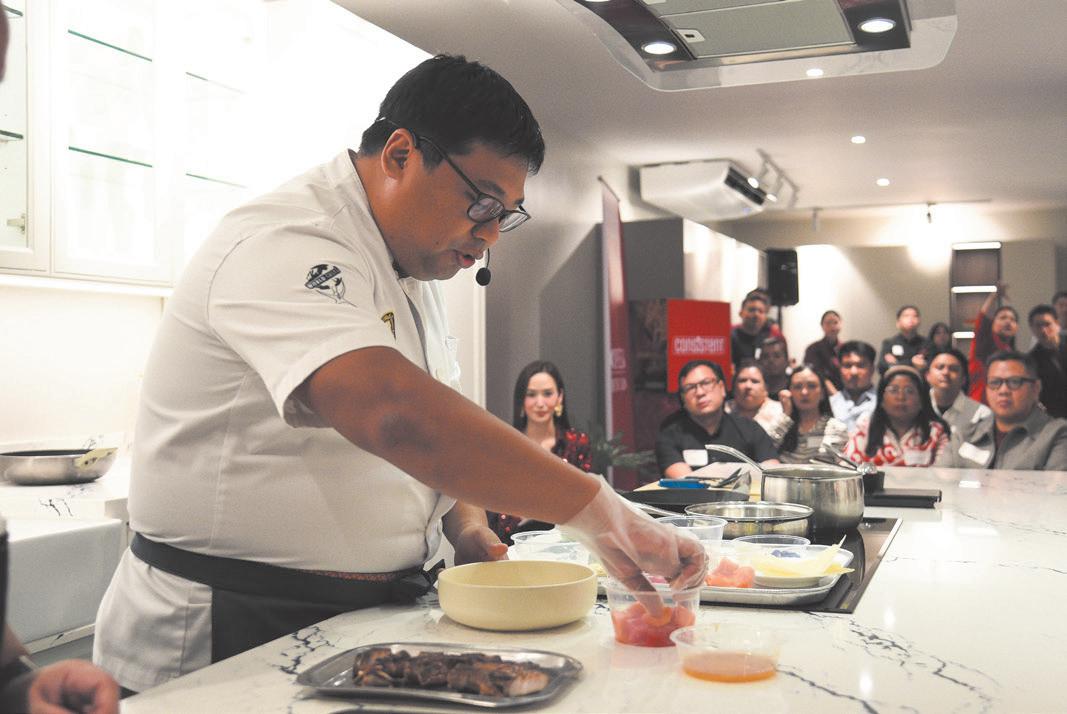
nerships in the foodservice industry, Consistent Frozen Solutions held the exclusive event Open Kitchen on May 27, 2025 at the elegantly modern Ernestomeda showroom in Makati. The event brought together chefs, restaurateurs, hoteliers, and business owners. Guests were welcomed with cocktails and an introduction to the story behind the foodservice company Consistent, setting the stage for an afternoon of appreciation for fine meats. The spotlight was on Chef Bugia, known for his inventive, ingredient-driven cooking. He led an engaging live cooking demonstration featuring Kurobuta Pork Belly Sinuglaw, an elevated version enriched by the marbled goodness of US Kurobuta pork; Kyoto-Style Wagyu Sukiyaki, showcasing the deep and indulgent flavors of American Wagyu, and Steak Frites Rice Bowl with Choice Grade Ribeye, enhanced by the richness of American Wagyu fat in the rice.


Sharing tips
CHEF Bugia generously shared tips on maximizing each cut’s unique characteristics, engaging guests with culinary insights and personal stories from his extensive kitchen experiences. Alongside this, attendees admired an impressive display of Consistent’s fine meats portfolio which included premium American meat brands Mishima Reserve US Wagyu, Sig Iowa Kurobuta Pork, and Greater Omaha Steaks. Representatives from the fine meats industry graced the Open Kitchen. The US Meat Export Federation (USMEF) shared the advantages of US grown meats, including its quality end-to-end program from the proper raising of animals to quality assured cutting and packing. The USMEF also highlighted the globally recognized USDA quality grading standards. The global meat supply market leader JBS presented a refresher on the makings of fine meats, such as breed, grow-
The Evolving Plate: Where Batangas Traditions and Bold Flavors Meet
Story
Photos by Nicole Paler
one will realize that the Batangueño table isn’t fixed in time. It’s moving, expanding. It welcomes new ideas, ingredients, and dishes into its fold — not out of trendiness, but out of genuine appetite. Tucked quietly in Bauan, Batangas, gateway to Mabini’s diving coves and the historic charm of Taal town proper is Sotogrande Hotel and Convention Center Batangas, a new place where comfort meets creativity, and where, under the expert hand of Chef Erwin Rarugal, the kitchen became a space where history met the here-and-now.
Familiar Roots, Bold Starts
THE welcome plate Sotogrande Batangas gave us in our room along with the dessert for lunch and breakfast was an introduction to Batangas and its agricultural roots. Waiting for us in the room, and again during lunch and breakfast, was a sticky, sweet bite of local heritage: sinukmani.
This glutinous rice delicacy had that perfect chew, rich with coconut milk and just the right hint of sweetness, with golden, crispy latik that added both texture and that deep, caramelized nuttiness. It’s the kind of dish that shows up at fiestas, town gatherings, and every Batangueño celebration, rooted in its rich agricultural bounty—coconuts and rice, the heart of its farmlands.
Suelo and the Language of the Land
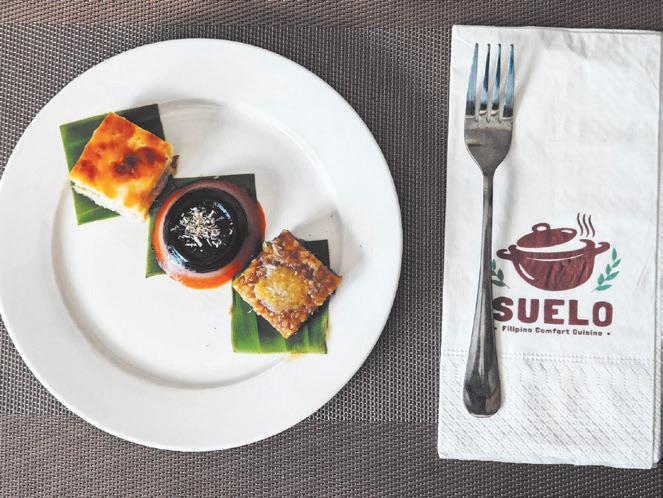


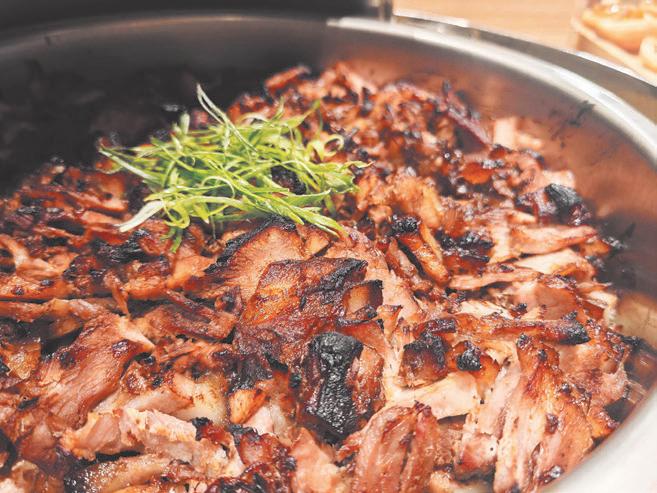
Chef Erwin is game to “try to do something na medyo Batangueno [that is a little Batangueno]”— just enough Batangueño to be loyal, just enough daring to be different. It’s a balance that plays out in Suelo’s buffets and event menus, where Western dishes meet Filipino flavors in harmony. That balancing act — of heritage and innovation — defines the entire experience.
ing and the eventual cuts. A wine pairing session led by WSET Level 3 certified and Consistent Frozen Solutions Business Development Senior Specialist Mikee Manahan added further dimension to the experience. Guests sampled each dish alongside select wines, discovering how thoughtful pairings amplify flavors and textures of the dishes.
As the event drew to a close, guests and industry members engaged in lively discussions, all while enjoying more delectable dishes that showcased Consistent’s premium meat portfolio. A final toast from the Consistent team reaffirmed their commitment to supporting the country’s finest kitchens.
The Story Behind Consistent FROM a modest operation supplying restaurant entrepreneurs and meat distributors, Consistent Frozen Solutions has, in over a decade, grown to become one of the Phil-
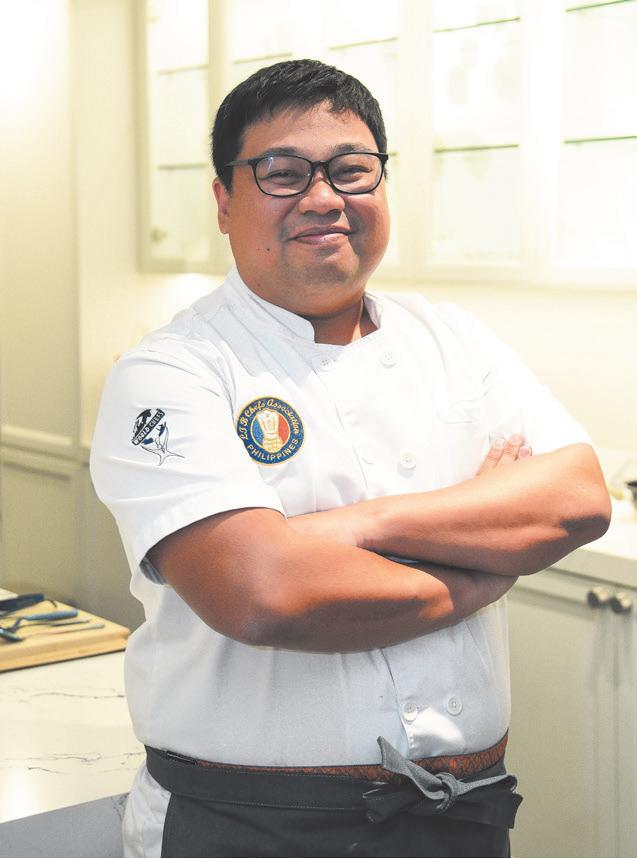
ippines’ most trusted foodservice suppliers. Anchored on the purpose to “Feed, Empower & Grow,” the company looks to help customers meet their business opportunities.
“Our customers are with us because we do not simply supply these meats — we provide them with the intention to help them grow their businesses and delight their clients. We act with professionalism and provide great, consistent service, hence the name, Consistent,” said Carlo Agbayani, Head of Product Development and Marketing. In the case of restaurants and the hospitality industry, Consistent wants to bring the best high-end premium meat brands at fair costs and a reliable supply stream. This is how Consistent plans on bringing excellence to every plate. The company boasts
than
the
and
—
‘to look for’ in the foodservice industry,” remarked Claudia Rivera-Quimpo, Consistent’s Director. “We are happy to hear your big culinary idea, or whatever you have in mind for your dishes. Let us know! We have suggestions and can lead you to the best product to fit your menu, or perhaps even source it for you.” Learn more about them and their products at www.consistent. com.ph and on @consistent.ph on Facebook, Instagram, and TikTok.
By Vincent Peter Rivera
After a winning debut at the International Food Exhibition Philippines (IFEX) with the “2024 Katha Award for Food Innovation,” the world’s first all-bacon brand Baken returned to the food trade show to share a mouthful of its latest product developments.
Founded in 2018, the homegrown brand originated from co-founders Rachel Carrasco and Kelly Parreño’s desire to make the versatile bacon not only readily available but also innovative. This led them to create crispy and real 100 percent bacon snacks with no substitutes.

THIS culinary narrative continues at Suelo of Sotogrande Batangas, the restaurant whose name means “soil” — a fitting tribute to the grounded flavors of Bauan. Here, Chef Erwin interprets tradition with both respect and curiosity. “When we were looking at the area, we wanted to incorporate something that’s from the land,” said Chris Guballa, the general manager of Sotogrande Hotel and Convention Center Batangas. And the philosophy shows in both the food and the way the team approaches hospitality. With seating for 150 guests, Suelo is poised to become more than a dining room. It and the four-star Sotogrande Batangas is an anchor — for weddings, events, and big Batangueño memories.
Filipino table—but with a chef’s calibration. Sweet-and-sour pork is balanced with a glaze that’s sticky sweet with an acidic zing. Fried chicken emerges skin-crisp, meat tender, salt and fat in perfect union. Chopsuey, layered with garlic and oyster sauce, sings in fresh, snappy notes.
Buffet breakfasts are generous and rooted in place: ginisang ampalaya (bitter gourd with egg) that is surprisingly delicate; danggit that crackles with sea-salt crunch; and a bowl of champorado so dark and made perfect with a dash of milk. Rice cakes like sinukmani, and kutsinta, always wait nearby.
With the evolving Batangueño palate, locals are no longer just craving for the familiar comforts of lomi or bulalo. There’s a growing curiosity for new flavors—especially when it comes to special occasions—and that’s exactly where Suelo comes in. This fresh dining destination in Batangas raises the bar, offering both comfort and creativity in every dish. Suelo’s menu leans heavily into the
Flavors Not From Here — But Right at Home WHAT made this experience so unforgettable was how meals in Sotogrande welcomed flavors beyond Batangas, yet never felt foreign. They were grounded in the Filipino soul, even if their roots were elsewhere.
We had a bohemian-style rooftop dinner at their Sky Lounge. It was a sneak peek into how they can also serve something delicious yet out of the ordinary for celebrations. We started with oyster sisig bruschetta — yes, sisig on toast. Spicy, creamy, and briny in the best way, it was seared just enough to stay delicate, then layered with chili, calamansi, and mayo on top of crisp bread. Weird idea? Maybe. Brilliant? Absolutely. Carnitas tacos followed. It was slowcooked pork with crispy edges and soy and vinegar folded into warm tortillas. Alongside it: roasted fish with herbs and lemon, and a comforting sardines pasta that felt like someone raided their pantry and made magic.
Chef Erwin has his hands in everything — from the everyday to the experimental. As they and Sotogrande Hotel and Convention Center Batangas are the new kids on the block, Chef Erwin is also introducing new experiences to the locals. While bulalo remains a regional favorite, they’re also introducing Kansi, a dish more common in the Visayas but gaining traction locally, as it uses beef shanks and bone marrow as well, which is what Batangas is also known for. Batangas isn’t clinging to the past. It’s growing from it. The meals here are proof: Sinukmani that’s steeped in memory, a bite of oyster sisig bruschetta breaking rules. At this quiet stop in Bauan, Chef Erwin and his team aren’t just feeding guests — they’re telling the story of a province in motion. Plate by plate. Bite by bite.
During the event held from May 22 to 24, 2025 at the World Trade Center, Baken showcased most of its original products: Real Bacon Crisps, featuring crispy, savory, and smoky bacon strips; Bacon Cookies, which offer a combination of salty, smoky bacon bits and sweet chocolate chips baked into a soft and chewy cookie; and their Bacon Jam, a spread that elevates the taste of anything it’s paired with. Their participation at IFEX this year became special for the snack brand, as it offered an exclusive first taste of new Real Bacon Crisps flavors: Cheesy Jalapeño and Barbecue, which will soon be available to the public.
“When we did our research, it said that for snacking, you must have your original flavor and then you need to have a spicy variant, and an all-time favorite variant,” Carrasco explained. “We tried a lot of spices but it was way too spicy and it overpowers

Kurobuta Pork Belly Sinuglaw
Kyoto-Style Wagyu Sukiyaki
Steak Frites Rice Bowl with Choice Grade Ribeye
Chef Ed Bugia in action, preparing Sinuglaw at the live cooking demo. Greater Omaha Ribeye
The pre-set menu of Baken during the tasting session.
Baken’s original products displayed during the three-day event of IFEX 2025.
Sinukmani, sapin sapin and Cassava Cake for welcome treat in the room Fruit platter
Ham Sliders for appetizers Pulled Pork Carnitas
Chef Ed Bugia
ILOILO’S HOSPITALITY: ILOILO CITY FOOD TOUR WITH INJAP TOWER HOTEL, KLOOK
By Brian K. Ong
ILOILO City greets you not just with fanfare—think thundering Dinagyang drums and warriors in motion—but with a steaming bowl of batchoy or kansi and a knowing wink from a local who’s well aware you’re about to eat too much (and possibly regret nothing).
Injap Tower Hotel—one of the properties managed by the Hotel101 Group—partnered with Klook Philippines, an online travel and experiences platform that lets users “discover and book everything from theme park tickets and guided tours to airport transfers, SIM cards, and even food experiences—all in just a few taps,” to bring Kreators, or Key Opinion Leaders (KOLs), to Iloilo City for a firsthand taste of the hotel’s and the city’s hospitality and vibrant travel and food scene.
We started off Day 1 in Iloilo City with a half-day food tour curated by Klook, designed to offer a taste of Iloilo’s best-loved bites and hidden gems. From hearty streetside snacks to heritage recipes passed down through generations, the tour promised an edible introduction to the city’s culinary soul.
Roberto’s Siopao JM Basa St, Iloilo City Proper, Iloilo City | +632 033 335 0484
HAVE you met the Queen of Iloilo? Make way—since 1978, Roberto’s has earned its crown as the city’s most famous, oldest, largest, and arguably best-tasting siopao. Their Queen Siopao is a meal in itself: a soft, steamed bun generously stuffed with bacon, Chinese sausage, chicken-pork adobo, and egg.
Other contenders in the royal lineup include the King Siopao (with ham, Chinese sausage, adobo, and egg), the slightly lighter Jumbo (minus the ham), and the classic Regular version filled with pork adobo and egg. Despite the decades, Roberto’s hasn’t lost its touch. The unassuming Chinese eatery still draws long lines of loyal locals and curious tourists alike.
While the Queen reigns supreme, their menu also features favorites like the meatballs on a stick, lumpia shanghai, lomi, pancit, and crispy fried chicken, among others
Alicia’s Special Batchoy Huervana Ext St. Lapaz, Iloilo City +63939 989 3302
BATCHOY is synonymous with Iloilo—it is the city’s most iconic dish and, in 2024, was named “the world’s best offal soup” by global food guide TasteAtlas.
This hearty Filipino noodle soup is a bold blend of pork offal, chicken or beef stock, round egg noodles, and a medley of toppings—crisp pork cracklings, fried garlic, a splash of shrimp paste, and sometimes even a raw egg for added richness. Ask an Ilonggo for the best batchoy in town, and you’ll hear passionate answers—but no universal agreement. Everyone has a favorite, depending on the mood and the moment. I have tried some of the greats: Netong’s, Deco’s, Ted’s, Popoy’s. But Alicia’s? It is definitely one of the bowls I will return to. No frills, just heartwarming goodness—anytime of day.
Kap Ising’s Pancit Molo Shops At Atria, Donato Pison Avenue Brgy. San Rafael, Mandurriao, Iloilo City | +63917 676 7644
IN the district of Molo—often dubbed as one of Iloilo’s culinary cradles—there’s a dish that’s as comforting as it is iconic: Pancit Molo. This local dumpling soup features savory meat filling wrapped in delicate wonton skin, swimming in a flavorful broth that tastes like home. At the center of this tradition is Kap Ising’s Pancit Molo, a household name since the 1920s. What began as his grandmother’s humble recipe has been passed down through three generations, now lovingly preserved and elevated by Kap Ising himself. While the flavors have evolved with time, the essence remains: a rich, garlicky bowl that hits all the right nostalgic notes. Fresh ingredients, time-tested methods, and that unmistakable Ilonggo warmth have made Kap Ising’s a favorite—not just in Molo, but throughout Iloilo province. One spoonful in, and you’ll understand why.
Agatona 1927 Plaza Rizal, Jaro, Iloilo City +63912 500 3883
WHAT if you could step into the past?” That’s the promise of Agatona 1927 Museum Café, set in the historic Jalandoni-Montinola home in Jaro, Iloilo—a neoclassical mansion brimming with stories and oldworld charm.
The museum café offers its guests the Ilustrado Tour, a guided heritage experience that brings the home’s storied past to life. From the life-sized image of Nuestra Señora de la Candelaria (Our Lady of the Candles) to the papal bull authorizing masses within the mansion walls, the tour traces the legacy of Doña Agatona Escarilla Arguelles and her family. Their influence lives on not

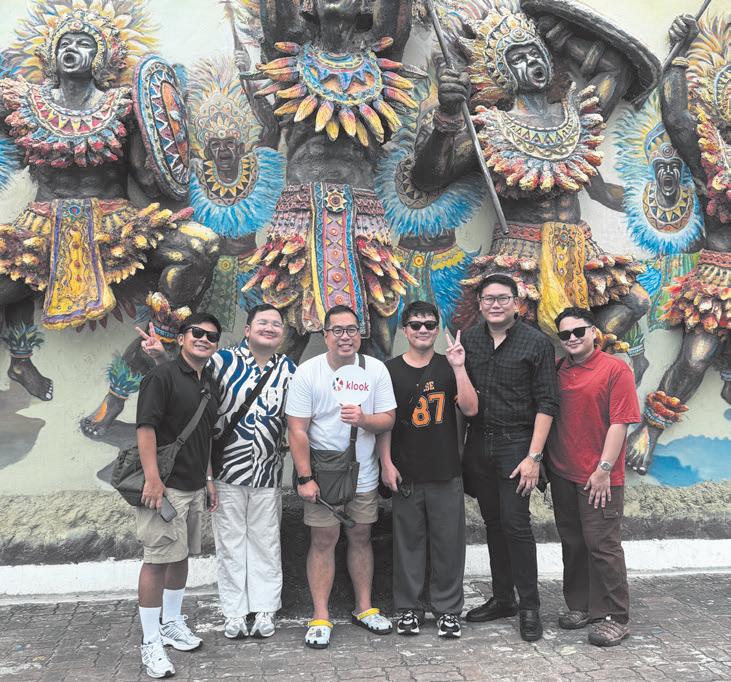
just in relics like religious artifacts and fine china, but in the oral histories shared by her descendants— tales that linger in the woodwork and whisper through the halls, telling a vivid chapter of Iloilo’s cultural soul.
After the tour, we were welcomed by Candy Jalandoni Garcia, part of the new generation at the helm of Agatona 1927. In the café, we were invited to unwind and were served Tsokolate E, short for tsokolate espresso, a rich, thick, and unapologetically indulgent Filipino hot chocolate made from native cacao. It came with their heirloom cookies, based on a beloved recipe passed down from their grandmother, who used to serve them to the family as a treat. I personally couldn’t resist pairing the tsokolate with their suman—a sticky rice delicacy that, together with the chocolate, made for a nostalgic and comforting moment.
Just as we thought the experience couldn’t get more generous, we were surprised with a dinner feast of treasured, multi-generational family heirloom recipes. The spread was both hearty and unforgettable: Chicken al Ajillo—tender chicken in garlic and a special soy blend; Dinuguan con Chicharon—pork blood stew with crunchy pork cracklings; Beef Salpicao—tenderloin bathed in rich garlic sauce; Lengua in Mushroom Sauce—melt-inyour-mouth ox tongue in a creamy mushroom reduction; Pan-Seared Salmon with Lemon Butter Sauce— flaky salmon touched with a bright garlic-citrus glaze; and Blue Marlin Steak—pan-seared and crowned with garlicky chimichurri. Dessert? The family’s signature Golden Frozen Caramel—sweet, silky, and the perfect final note.
And as if that weren’t enough, the dining room offered a stunning view of Jaro Cathedral—history and heritage, served with a side of amazing views.
Tatoy’s Manokan and Seafood Sto. Nino Sur, Villa Arevalo District, Iloilo City, Iloilo | +632 033 337 1360
ALTHOUGH not part of our
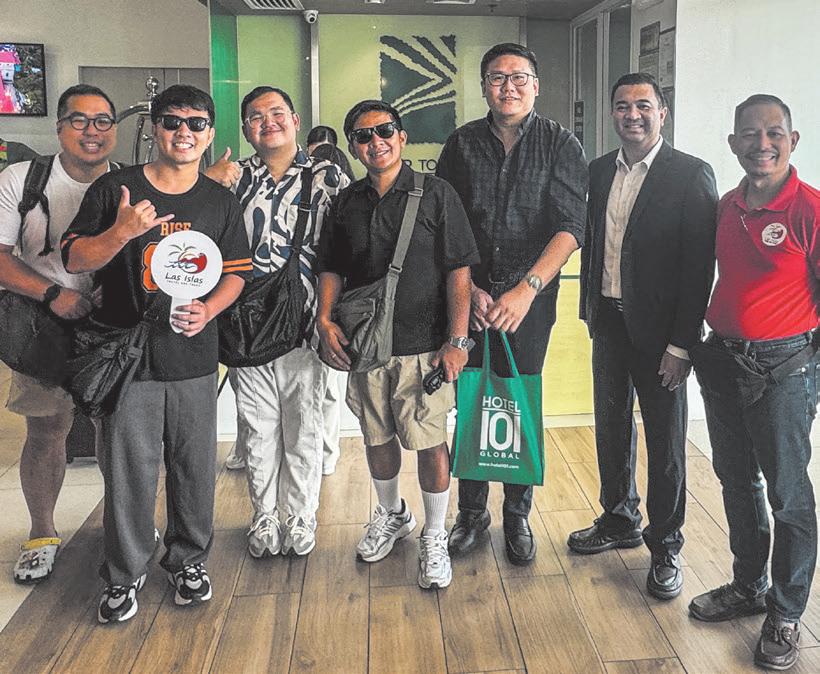

Klook food tour, Tatoy’s Manokan and Seafoods is a must-visit for any first-time (or returning) Iloilo traveler. It’s likely to pop up on every “best local eats” search—and for good reason.
Its original seaside branch in Villa Arevalo offers a breezy backdrop for feasting on their famous litsong manok—native chicken stuffed with lemongrass and tamarind leaves, grilled over charcoal in true inasal style. The menu also features lechon and a bounty of fresh seafood: scallops, oysters, fish, crabs—you name it.
Now, Tatoy’s Manokan and Seafoods has 3 branches, the other two located in Atria, and near the Iloilo International Airport.
Injap Tower Hotel Iloilo Diversion Road, Mandurriao, Iloilo City | +63977 808 8111
FOR comfort, convenience, and affordable stays in Iloilo City, Injap Tower Hotel offers a centrally located stay along Diversion Road, right across from SM City Iloilo. With 194 HappyRooms, each with one queen sized bed and one single bed, it is an ideal accommodation choice for families, groups of friends, or couples exploring and visiting Iloilo not just its vibran food scene, but also for business, leisure, or wider adventures or activities across Western Visayas and Panay Island.
Injap Tower Hotel is part of Hotel101 Group, the hospitality arm of DoubleDragon Corporation, with a

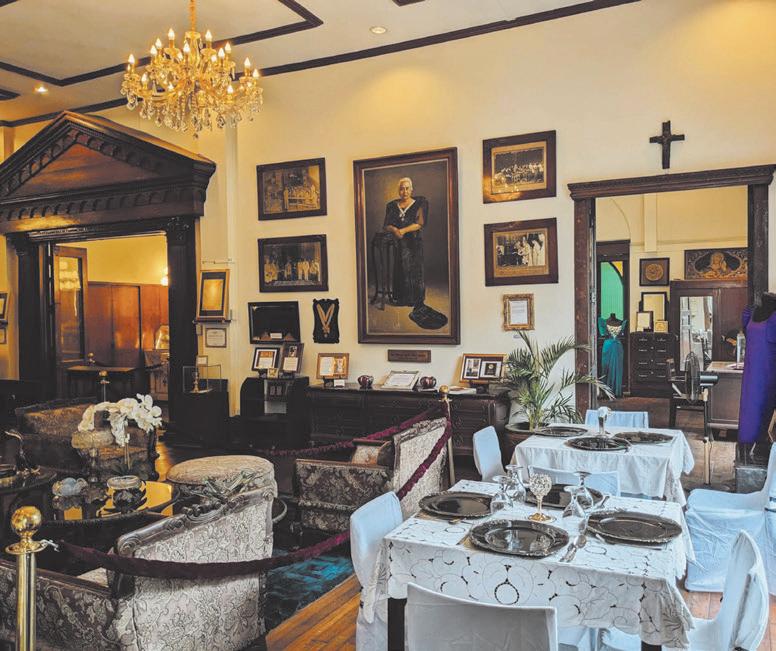
growing portfolio of properties in key Philippine locations: Hotel101Manila, Hotel101-Fort, Jinjiang Inn – Ortigas, Jinjiang Inn – Makati, Jinjiang Inn – Boracay Station 1, and soon, Hotel101-Davao and Hotel101-Cebu Mactan Airport.
UNESCO Creative City of Gastronomy
IN 2023, Iloilo City earned a prestigious global nod as the first Philippine city designated by UNESCO as a Creative City of Gastronomy—a title that celebrates not just its culinary heritage, but its commitment to innovation, sustainability, and cultural pride.
From heirloom recipes passed down through generations to the vibrant food festivals that animate its streets, Iloilo’s gastronomic identity is both deeply rooted and ever evolving. This international recognition affirms what every visitor quickly discovers: in Iloilo, food is no just nourish-
Chef Laudico x Adobros stir the soul of Pinoy cuisine
By Bless Aubrey Ogerio
HEN Filipino food is mentioned, most people, especially foreigners, often jump to two things: adobo and balut. While these are undeniably part of the country’s
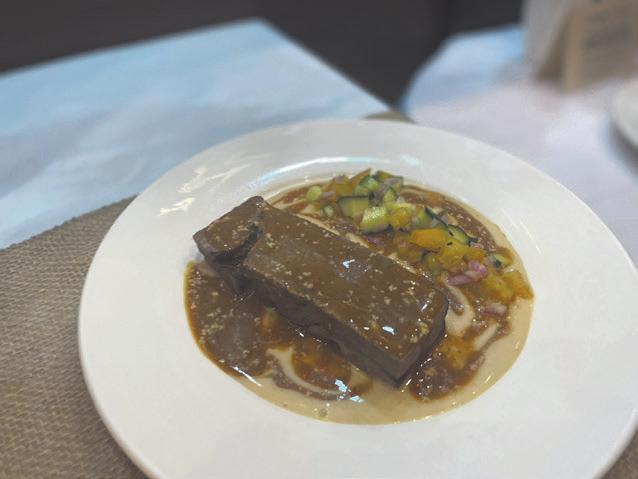
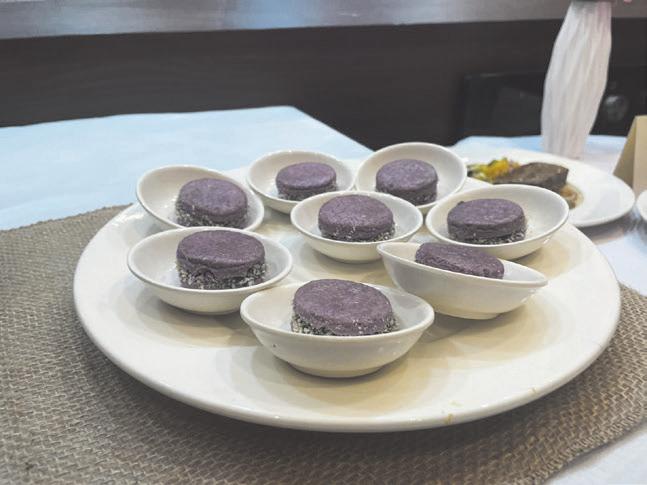
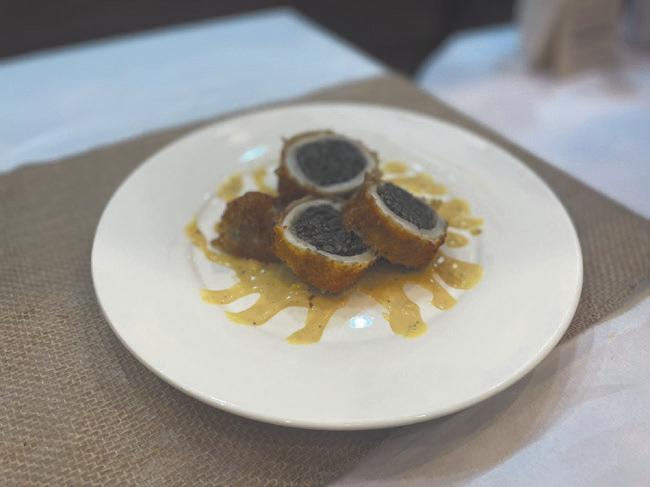
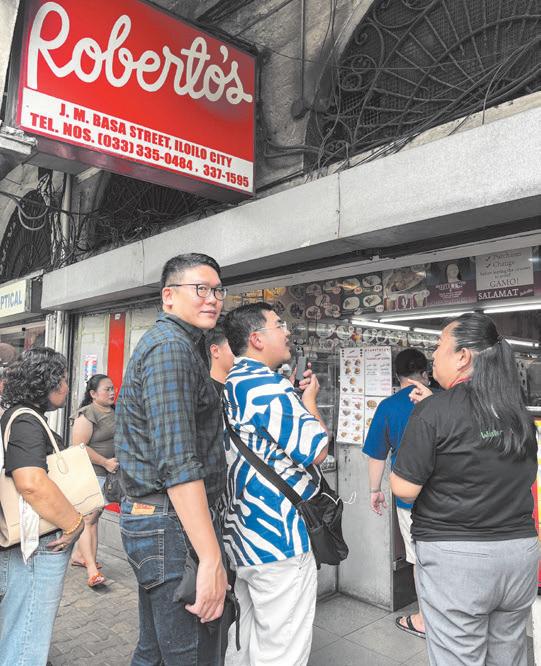
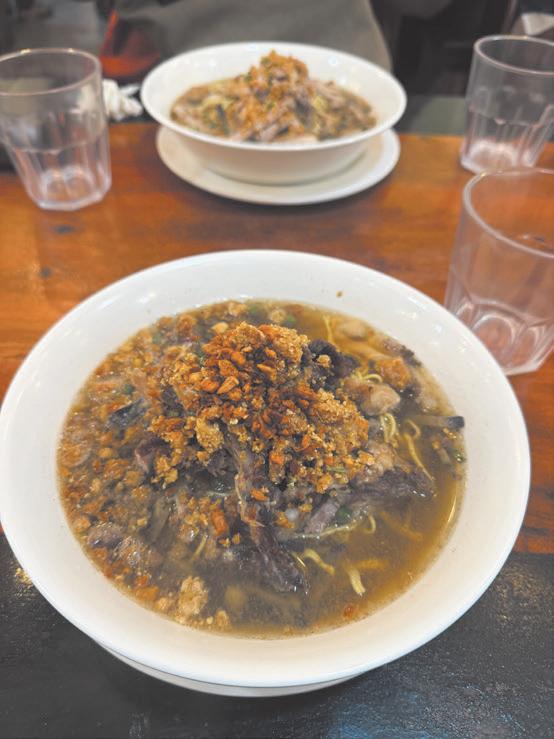


of this flavorful collabo -
ration were planted in Melbourne back in June 2024, when the Laudicos and Adobros met and realized they shared the same dream. During the event, Adobros presented a bold reinvention of their namesake dish—a mango-calamansi lamb adobo ensalada with rice. It was a fusion of cultures and climates: Filipino adobo with the Mediterranean familiarity of lamb, a nod to Chef Morris’ culinary roots in Italy.
In the demo, the chefs used lamb shoulder for a more balanced, less gamey flavor. They also thought that adding mango works beautifully with it, as one of their philosophies is using seasonal ingredients. More than just flavors, the dish was a reflection of heart and heritage.
A shared mission WHEN asked what message they want to send through their food, Chef Michael was clear: it’s about pride.
“Personally, I just want to see Filipinos being proud of our own food,” he said. “Let’s just be proud of what we have here.”
For him, supporting local doesn’t just mean eating local. It means supporting Filipino farmers, local suppliers, and own ecosystem.
Chef Morris added that Filipino cuisine is still largely undiscovered, even by Filipinos themselves. “There’s so much we don’t know yet—so many ingredients tucked away in regions we haven’t even explored.”
“So this is what we’re trying to do, to help the people to know more about Filipino food in our platform, which is cooking and showcasing it to the media or social media,” he added.
The Guevarra’s x Adobros creations are now available as part of the San Juan-based buffet starting May 21.
“Actually, we did not intend for it to stand out,” Chef Michael said. “We’re just being 100 percent here in pushing for Filipino food. And whatever happens, it will be just the reflections of what we’re doing.” Before Adobros took the stage, Chef Roland showcased his own innovation: adobo two ways. First, a valenciana-inspired adobong pusit. Then, valenciana stuffed into a whole squid, breaded and fried like arancini—an Italian twist with a Filipino soul. Meanwhile, Chef Jacq Laudico stayed true to her signature sweet creations.
Injap Tower Hotel Klook Kreators with Hotel101 Group staff exploring Iloilo City
Agatona 1927 Museum Café Roberto’s Queen Siopao Alicia’s Special Batchoy
The interiors of Agatona 1927 Museum Café Tatoy’s Litsong Manok
Enjoying the specialties of Agatona 1927 Museum Café
Klook Kreators Mark Tan, Marvin Samaco, Paul Ivan de Guzman and Lito Dizon, together with Hotel101 Group Head of Public Relations Brian Ong and Injap Tower Hotel Hotel Manager Gerald Fontanos
The writer and the Klook Kreators lining up at Roberto’s, Home of the Queen.


June 29, 2025
Edited by Jose F. Lacaba
Filipino musicians shine in USA, France, UK, and Berlin


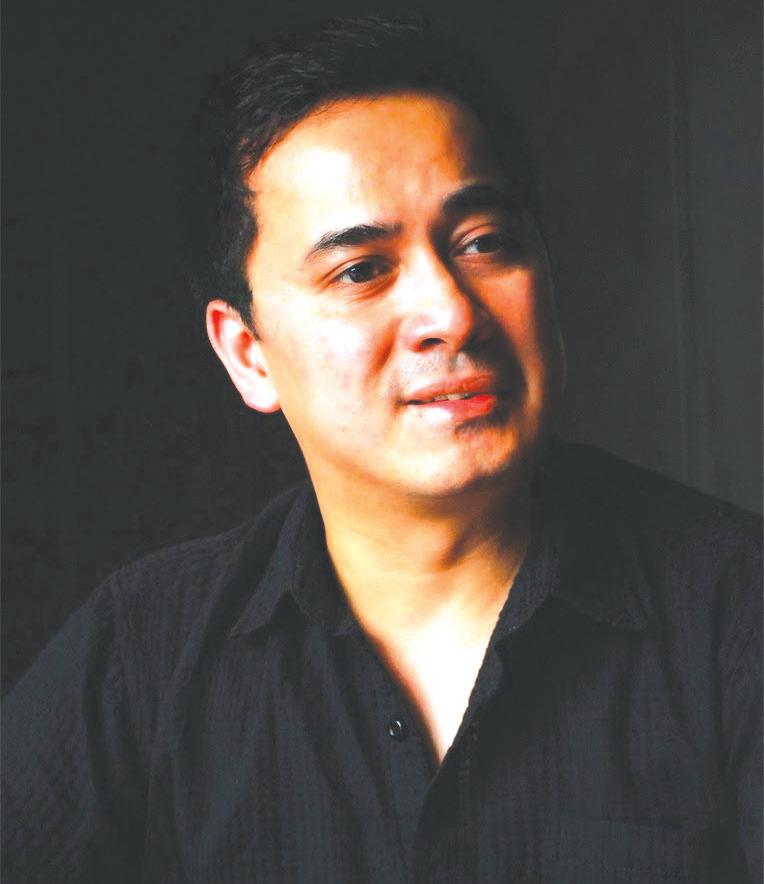


By Pablo A. Tariman
THE months of March, April, and May of this year saw Filipino musicians as virtual newsmakers—not on home grounds, but abroad.
music with trumpet icon Wynton Marsalis and his Jazz Ensemble from May 17-30 in the United States. With 1907 New Orleans as backdrop, Louis tells the story of noted American trumpeter and vocalist Louis Armstrong as a young boy. It depicts his early, poverty-stricken years and his dreams of playing the trumpet. As summed up in the Wynton Marsalis blogsite, “ Louis is an homage to Louis Armstrong, Charlie Chaplin, beautiful women and the birth of American music.” Music lovers and cineastes
agreed that one of the big comeons of the 2025 Louis film tour was the live music provided by Marsalis and Licad. Back in 2010, the film’s screening at the Keswick Theater in Pennsylvania got a rave review with adulation for the musicians who performed the live music. Five years later, it was Marsalis and Licad’s turn to earn this rave review from local jazz critic Wade Luquet: “In a sense, tonight’s performance was about two men named Louis, both of whom had a profound impact on American music. Licad expertly
played the (Louis) Gottschalk tunes with feeling and emotion that left the audience speechless from its beauty and the realization of Gottschalk’s influence on early jazz as the two musical forms were played on the same stage.”
For film director Dan Pritzker, the combination of Licad playing Gottschalk and Marsalis and his ensemble playing jazz reflects “the wide-ranging nature of the American musical landscape.”
ARTHUR ESPIRITU
IN the middle of May, Filipino tenor Arthur Espiritu debuted
as the Prince in Antonín
Dvořák’s
Much
to
she
And like The Little Mermaid , she makes a deal with a witch to gain legs in exchange for her voice. Espiritu impressed critics with his radiant performance at the Opera de Massy—the youngest opera house in France. Continued on
From the United States to Europe, Pinoy virtuosos wowed foreign audiences with their exceptional mastery and brilliance in music.
CECILE LICAD Cecile Licad
a sensation in the West Coast tour of the silent film Louis where she played live
Leopold
opera Rusalka
like the 1837 fairytale, The Little Mermaid by Hans Christian Andersen, Rusalka is a 1901 opera of a water nymph who longs
be human to be with the prince
loves.
CECILE LICAD PHOTO BY PATRICK DIOKNO
ARTHUR ESPIRITU
PHILIPPINE Philharmonic Orchestra (PPO)
Cecile Licad, Arthur Espiritu, and the Philippines Philharmonic Orchestra (PPO) wow foreign audiences
Continued from page 1
French critic Olga Szymczyk wrote: “Arthur Espiritu (as The Prince) is compelling in his wounded sincerity. His voice, clear and almost radiant, contrasts beautifully with Rusalka’s liquid universe. He embodies a tragic naivety—blind passion, impulsive betrayal, and regret without redemption. Each phrase wavers between the surge of love and the weight of guilt.”
Rusalka is famous for its soprano aria, Song to The Moon, made famous locally by the Peque Gallaga-Lore Reyes film, Sonata as sang by the late actress, Cherie Gil and voiced by soprano Camille Lopez Molina.
Espiritu told this writer: “I had a great time performing the Prince, for the first time. I have to admit, Czech is as hard as Polish. I enjoyed singing the last part of the Opera. It gave a feeling of peace and resolution in The Prince’s conscience. They have similarities but singing them requires special attention on opening up the vowels because you don’t really have too much time since you have to pay attention to the consonants.”
Although Song to the Moon was the opera’s most anticipated aria, the tenor said the aria of the Prince was just as touching.
“The aria for the Prince is such a joy to sing and it is so beautiful the way Dvořak wrote it. It’s not one of those arias where you think twice about yourself. There are no challenging leaps nor fiorituri (melody embellishment). It’s like singing a good melodic line that climaxes to the end,” Espiritu explained.
A month before his France debut, Espiritu was heard for the first time at Teatro Massimo in Palermo, Italy in a new production of Gounod’s Faust
Teatro Massimo is the largest theatrical building in Italy and the third largest in Europe after the Opera Nacional in Paris and the Staatsoper in Vienna.
The tenor sums up his Palermo engagement thus: “It was comparable to my La Scala debut but, the theater was much bigger and the acoustics were okay. It kept me thinking about how much we are missing as far as constructing a real opera house in the Philippines is going to be like. It was overall surreal. It was so good to be able to sing this role and iconic aria in one of the biggest theaters in Italy.” Espiritu is all set to reprise Faust in Varna November 15 to 23 until December 16. In March 2026, he sings Prince Igor as Vladimir at Gartnerplatz State Theater in Munich, Germany.
PHILIPPINE PHILHARMONIC ORCHESTRA
Meanwhile, the Philippine Philharmonic Orchestra’s debut in the United Kingdom (UK) from May 13 to 24 was a big hit.
The PPO UK tour started May 13 at Beacon Hall in Bristol and was greeted with a standing ovation followed by equally enthusiastic audiences at Cadogan Hall in London (May 14), the Symphony Hall in Birmingham (May 15), G Live in Guildford (May16) and another standing ovation at the Theater Royal in Norwich (May 18). The audiences at the Theater Royal in Norwich were so enthusiastic the orchestra had to oblige with two encores. The PPO’s 7th engagement at the Bridgewater Hall in Manchester had Filipinos in the audience.
Krina Cayabyab, daughter of National Artist for Music Ryan Cayabyab, told her father the PPO was well-received by English audiences.
“It was a proud moment for Filipinos as the applause was really long and well-deserved.”
In Guildford, England, the
orchestra performed Mendelssohn’s Italian’ Symphony; Delius’ Piano Concerto, featuring acclaimed pianist Mark Bebbington; Elgar’s Nimrod/ Enigma Variations; Bizet’s Carmen Suite No. 1 and Tchaikovsky’s Swan Lake Suite
The others concerts featured cellist Wen-Sinn Yang and violinist Diomedes Sarala Jr. in a repertoire consisting of Bizet’s Carmen Suite No. 1, Vaughan Williams’s The Lark Ascending and again opening with Jeffrey Ching’s Il Maestro di Capella Present at the Cadogan Hall in in London were Ambassador Teddy Boy Locsin and his wife and some CCP scholars led by Aidan Baracol and singer Mark Bautista.
Beethoven’s Fifth Symphony was a powerful finale but the audience favorite was Vaughn Williams’ Lark Ascending interpreted with class by PPO soloist Diomedes Saraza, Jr.
From what CCP President Kaye Tinga could figure out from assorted audiences in the different venues, the most applauded numbers were the original composition of CCP Artist in Residence, Jeffrey Ching’s Il Maestro di Capella 5
Pointed out Tinga: “It was an enormous hit and, in every venue, it elicited much laughter and applause.”
Berlin-based Filipino composer Jeffrey Ching was able to catch up with two of the nine UK tour concerts at Cadogan Hall in London and Symphony Hall in Birmingham.
He noted the venues have totally different acoustics. “The first is a converted church, beautifully resonant, but a bit limited in terms of backstage options. This was a challenge for the offstage effects in Il maestro di cappella. Because to be honest, the trumpets sounded just as loud playing offstage as onstage. But Birmingham Symphony Hall was another matter. It was gigantic and yet you could hear the smallest detail. We were able to make the trumpets sound really far away by placing them behind a thick acoustic curtain behind the stage. The PPO played brilliantly in both concerts. The highlights for me being the finale of Mendelssohn’s Italian’ Symphony and the entirety of Beethoven’s Fifth, both of which brought the house down.”
The composer noted the Polish Maestro performed the Mendelssohn and Beethoven symphonies with absolute fidelity to the score by doing all the repeats. “Of the added length, the audience remained totally spellbound, yet you heard the grand dimensions of these masterpieces as their creators intended.”
To prepare for the tour, Maestro Nowak had to consult with the artists managements in UK and the venue organizers.
“This is in order to avoid clashes of the same works being performed in the same season. That’s why we could not go with just one program, but with two symphonies, two major orchestra works, three soloists and two shorter works by a British composer and our Filipino composer in residence,” he said.
Since UK is exposed to excellent visiting ensembles, the challenge is how to make impression since the PPO is unknown in this part of Europe.
“It is a big challenge for an unknown orchestra to be compared with other excellent ensembles. After seven concerts, I believe the PPO has passed the test with flying colors and was adjudged one of the world’s best orchestras,” Nowak added.
For his part, Ching described his healthy working relationship with Maestro Nowak. “All composers dream of working with conductors who master every note in the score and correct every note in the orchestra that doesn’t match—that’s Grzegorz Nowak! Then of course there was Il maestro di cappella for the


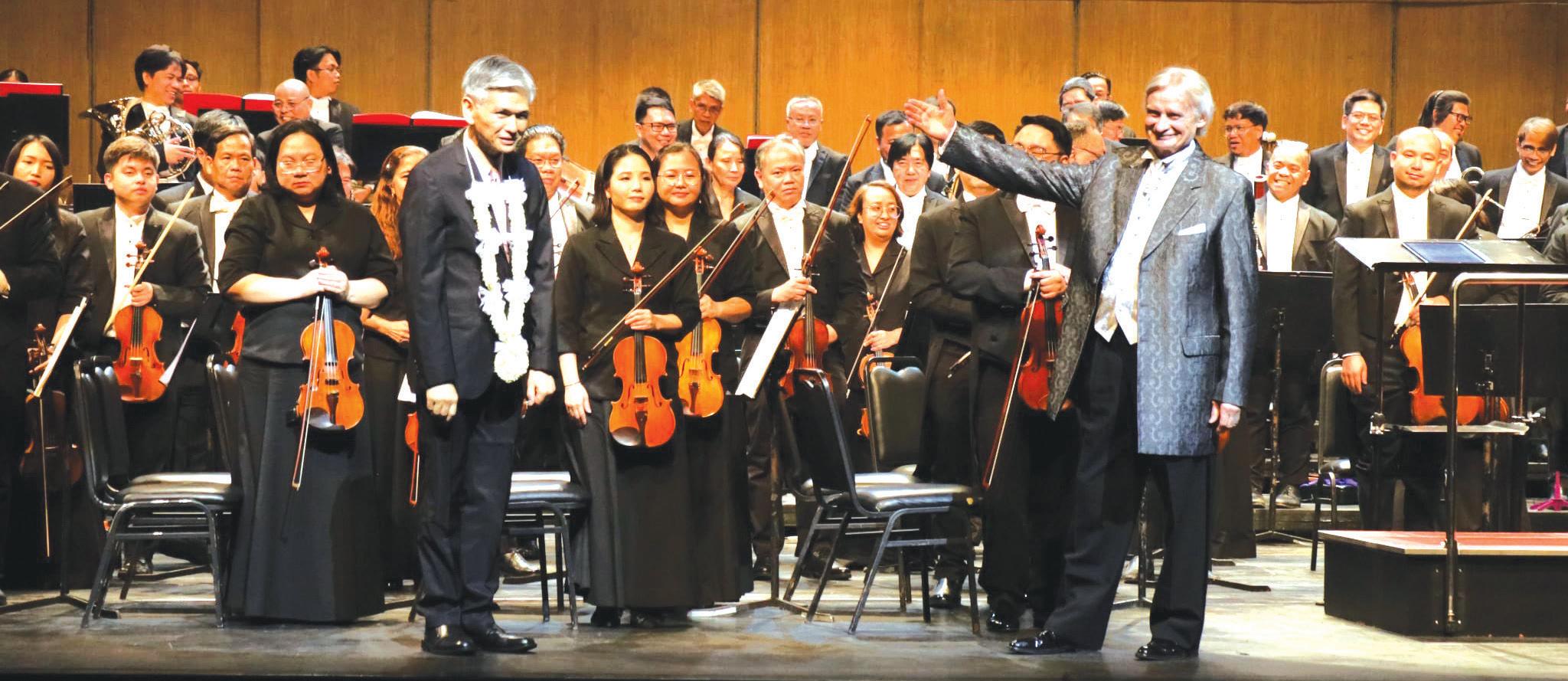

UK tour which was a clear symptom of a healthy working relationship. I always accept the Maestro’s suggestions to improve the execution of tricky passages, especially in the strings, since he is an accomplished violinist himself. And he is only too glad for me to discuss improvements with individual players at his back, as this saves precious minutes in the rehearsal proper. But he can take the initiative too. I’ve seen him use the rehearsal break not to rest or have a cup of coffee but to go through my woodwind parts one by one with a pencil, visually clarifying confusing rhythms for the players.”
He further elaborated: “There was the PPO’s concertmaster, Dio Saraza, who had to kickstart the piece before the conductor arrives, and absolutely milked the role for all
its comic potential. Then there was the unwavering support of the PPO’s unsung heroes, Noreen Oronce, Manual Agustine Chua, and Miguel Sto. Domingo, without whom it would have been impossible to devise the solutions we did for the offstage effects. Last by not least were the PPO players themselves, who were totally ‘game’ for all the unorthodox things the score asked them to do.”
COMING PERFORMANCES
After her successful team up with Marsalis in May, Cecile Licad will be reunited with the PPO under Maestro Novak on September 24, 6:30 p.m. at the Manila Metropolitan Theater. It will be a fundraising concert of the Philippine Philharmonic Orchestra Society, Inc. Licad is soloist in the Mozart and Ravel concertos.


After the Met engagement, Licad will go on a national outreach tour at the Baguio Country Club (6 p.m., Sept. 27), Pinto Gallery in Antipolo (6 p.m., Sept. 28), MiraNila Ancestral House (6:30 p.m., Oct. 1), University of the Philippines Visayas in Iloilo City (6 p.m., Oct. 6), Molo Church also in Iloilo City (7 p.m., Oct. 7) and Virac, Catanduanes (Oct. 10). Meanwhile, 25-year-old Filipino-Finnish conductor Tarmo Peltokoski is consistently getting rave reviews in his latest engagements in
and
Europe. He led the NHK Symphony in Mahler’s No. 1 (“The Titan”) and with Daniel Lozakovitch in Korngold violin concerto June 20-21 in Tokyo. Composer Ching caught up with Peltokoski’s engagement at Berlin Philharmonie on May 29. He told this writer: “Peltokoski’s Wagner brought the house down—70 minutes conducted from memory. A truly outstanding talent,
still so young. I liked his Saariaho even better—so I think he has a unique flair for contemporary music.”
ARTHUR ESPIRITU
JEFFREY CHING with PPO and Maestro Nowak in one concert
CECILE Licad with Wynton Marsalis (Right) with a fan (Left)
PHILIPPINE Philharmonic Orchestra (PPO) at Samsung Theater
PPO at St. George’s Hall in Bradford, northern England on May 22

Gajah Gallery presents Libang/Hibang: A group exhibition of Filipino artists
YOGYAKARTA, Indonesia— Gajah Gallery is pleased to announce Libang/Hibang, a dynamic group exhibition showcasing a selection of influential voices in contemporary Filipino art, curated by artist-curator Leslie de Chavez.
Participating Filipino artists include: Alfredo Esquillo, Charlie Co, Elmer Borlongan, Joy Mallari, Leslie de Chavez, Manny Garibay, Mark Justiniani, Plet Bolipata, and Renato Habulan.
exhibition coincides with one of the most vibrant months in Indonesia’s contemporary art calendar—when artists, collectors, and curators from across the region and beyond converge in the city.
It is a timely and powerful platform to champion Filipino artistic perspectives on a regional stage.
This presentation marks another significant step in Gajah Gallery’s ongoing commitment to showcasing Filipino contemporary art across Southeast Asia.
pay attention.
The exhibition’s title is drawn from two Filipino words—libang, meaning distraction or amusement, and hibang, evoking obsession or madness. Together, they encapsulate the delicate tension between being captivated and being consumed, between mindful presence and manic overstimulation.
This exhibition considers attention not simply as a theme, but as a potent force—one that shapes how we see, what we remember, and who is heard.
fractured perception, to attend closely—to truly see—is increasingly rare. Here, each artwork becomes an invitation to resist distraction and engage fully. Some pieces turn toward the intimate and overlooked, illuminating daily rituals and quiet encounters. Others critique the spectacle-driven nature of modern life, questioning the cost of constant exposure and the ethics of seeing.
spirit—the exhibition creates a space for viewers to slow down and reorient.
Within the gallery’s walls, attention is no longer splintered or weaponised, but reimagined as connection and care.
FILIPINO ART
TAKING place at the Gallery’s Yogyakarta space, the Libang/Hibang
Founded in 1996, Gajah Gallery has remained at the forefront of the Southeast Asian art scene, with premiere exhibitions curated by the region’s leading academics and art historians. It continues to support the work of Southeast Asian artists through a full calendar of exhibitions each year, including invitations to regional and international platforms of the highest calibre.
Following exhibitions in Singapore (2023) and Jakarta (2024), Libang/Hibang in Yogyakarta continues this curatorial trajectory— deepening cross-cultural dialogue and fostering meaningful encounters between artistic communities.
In a world propelled by algorithmic noise, social fragmentation, and digital acceleration, Libang/Hibang proposes a radical act: to pause and


The participating artists confront this idea head-on, using a range of mediums—including paintings and sculptures—to explore the complex relationship between visibility and silence, presence and absence, focus and fatigue.
KALEIDOSCOPE OF NARRATIVES
IN the age of infinite scrolling and
Rather than offering a single reading, Libang/Hibang presents a kaleidoscope of narratives: from personal histories and cultural memory to media distortion and systemic erasure. What unites these works is their quiet insistence—that giving attention is not a passive gesture, but a conscious, often political act. To witness is to care. To notice is to participate.
Set against the backdrop of Yogyakarta—a city revered for its rich artistic heritage and contemplative
Libang/Hibang also marks a meaningful collaboration between Gajah Gallery and artists based in the Philippines. Together, this partnership refl ects a shared vision to deepen regional dialogue and amplify Southeast Asia’s vibrant contemporary art ecosystems.
Libang/Hibang ultimately reminds viewers that attention is not a commodity to be traded—it is a sacred gesture of presence. In offering it, we assume responsibility. And in doing so, we reclaim a sense of clarity, purpose, and power.
The Libang/Hibang exhibition will be on view until Sunday, July 13, 2025.


